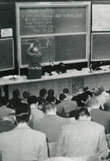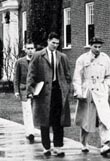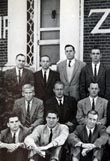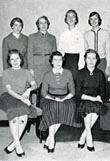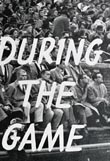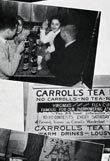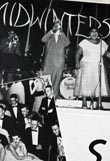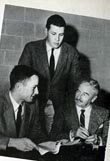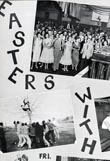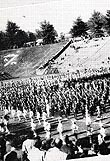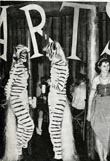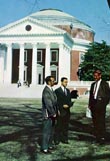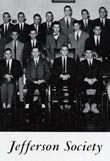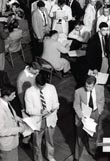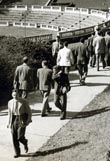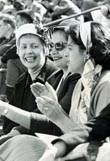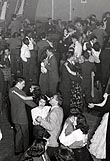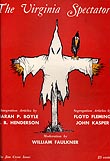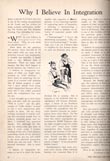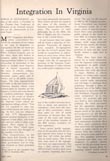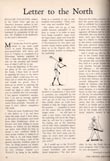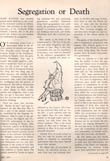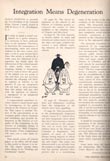Introduction and Contexts
- Faulkner At Virginia: Introduction
- Faulkner in the Late 1950s
- The US in the Late 1950s
- Virginia in the Late 1950s
Virginia in the Late 1950s
 In February 1957, when William Faulkner arrived in Charlottesville to occupy his position as Virginia’s first
Writer-in-Residence, “Mr. Jefferson’s University” was 132 years old. Its first students matriculated
in March 1825: 123 undergraduates, all white males. There were almost five thousand UVA students by the 1956-1957 academic year,
but they were still mostly white and male. The Nursing School’s students were all female, the Education School was
largely female, and there were a few women students in the graduate Schools of Law, Medicine and Arts & Sciences, but
officially there were no women students in the College of Arts & Sciences until 1969, and the College was not fully
co-educational until the Class of 1976 arrived in 1972. There actually are a few women pictured among the college students in the
1957 and 1958 editions of Corks and Curls, the school yearbook, but they might have been daughters of faculty members;
during those years Mary Washington College, in Fredericksburg, was officially designated the state’s school for women.
(When Faulkner traveled there to speak in April 1957 he would still have been considered “in-residence” at
UVA.) A large number of the questions from Faulkner’s UVA audiences come from women; in May 1957 he met with a group
identified as “Wives of Law School Students,” and “wives” were explicitly invited to his
session with the English Department faculty the same month, but since women only made up about 3% of the total student body, it is
not clear who the women were whose voices you can hear during the other sessions, especially the classroom sessions. Several were
certainly graduate students in English or Education (four are identified by name in his 6 May 1958 session with
Stevenson’s English 32), many were interested residents of Charlottesville or Albemarle County, still others may have
been the wives of faculty members sitting in on classes when Faulkner was present. The presence of these women suggests the
environment at UVA wasn’t as “male” as it looks in the records. To my ear, at least, the
women’s voices we hear on the tapes don’t sound shy or hesitant about being part of the conversation
In February 1957, when William Faulkner arrived in Charlottesville to occupy his position as Virginia’s first
Writer-in-Residence, “Mr. Jefferson’s University” was 132 years old. Its first students matriculated
in March 1825: 123 undergraduates, all white males. There were almost five thousand UVA students by the 1956-1957 academic year,
but they were still mostly white and male. The Nursing School’s students were all female, the Education School was
largely female, and there were a few women students in the graduate Schools of Law, Medicine and Arts & Sciences, but
officially there were no women students in the College of Arts & Sciences until 1969, and the College was not fully
co-educational until the Class of 1976 arrived in 1972. There actually are a few women pictured among the college students in the
1957 and 1958 editions of Corks and Curls, the school yearbook, but they might have been daughters of faculty members;
during those years Mary Washington College, in Fredericksburg, was officially designated the state’s school for women.
(When Faulkner traveled there to speak in April 1957 he would still have been considered “in-residence” at
UVA.) A large number of the questions from Faulkner’s UVA audiences come from women; in May 1957 he met with a group
identified as “Wives of Law School Students,” and “wives” were explicitly invited to his
session with the English Department faculty the same month, but since women only made up about 3% of the total student body, it is
not clear who the women were whose voices you can hear during the other sessions, especially the classroom sessions. Several were
certainly graduate students in English or Education (four are identified by name in his 6 May 1958 session with
Stevenson’s English 32), many were interested residents of Charlottesville or Albemarle County, still others may have
been the wives of faculty members sitting in on classes when Faulkner was present. The presence of these women suggests the
environment at UVA wasn’t as “male” as it looks in the records. To my ear, at least, the
women’s voices we hear on the tapes don’t sound shy or hesitant about being part of the conversation
 .
.
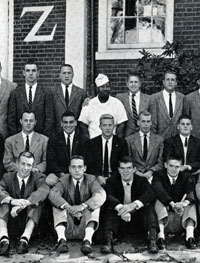 On the other hand, I don’t hear any recognizably “black” voices among the hundreds of people
who ask Faulkner questions, and it seems likely that there were no blacks in any of his audiences here (though one man on the
tapes identifies himself as an Indian national). Thanks to the series of legal battles fought by the NAACP in the courtroom in the
years leading up to the Supreme Court’s Brown v Board of Education decision, in the 1950s African American
students began attending UVA in very small numbers: a few in the Law School, in Education and in Engineering. I saw no sign of
these students in Corks and Curls from the years Faulkner was here; the only black faces in those yearbooks belong either
to the entertainers who came to town for the big weekends (Duke Ellington, Lionel Hampton, Louis Armstrong, among others) or to
the servants who worked for the fraternities (identified in the group photos simply by their first names). A May 1957 editorial in
the student newspaper, The Cavalier Daily, titled “Desegregation At The
University,” refers to “the Negro students [now] enrolled,” but adds that there has not been
any “social mixing between white and Negro” at UVA, “even when the two have attended dances together
in Memorial Gymnasium.”
On the other hand, I don’t hear any recognizably “black” voices among the hundreds of people
who ask Faulkner questions, and it seems likely that there were no blacks in any of his audiences here (though one man on the
tapes identifies himself as an Indian national). Thanks to the series of legal battles fought by the NAACP in the courtroom in the
years leading up to the Supreme Court’s Brown v Board of Education decision, in the 1950s African American
students began attending UVA in very small numbers: a few in the Law School, in Education and in Engineering. I saw no sign of
these students in Corks and Curls from the years Faulkner was here; the only black faces in those yearbooks belong either
to the entertainers who came to town for the big weekends (Duke Ellington, Lionel Hampton, Louis Armstrong, among others) or to
the servants who worked for the fraternities (identified in the group photos simply by their first names). A May 1957 editorial in
the student newspaper, The Cavalier Daily, titled “Desegregation At The
University,” refers to “the Negro students [now] enrolled,” but adds that there has not been
any “social mixing between white and Negro” at UVA, “even when the two have attended dances together
in Memorial Gymnasium.”
 The “Supreme Court decision” comes up several times in Faulkner’s sessions at UVA, and no one
has to explain which decision is being referred to
The “Supreme Court decision” comes up several times in Faulkner’s sessions at UVA, and no one
has to explain which decision is being referred to
 . You can hear the discussions that follow for yourself. I sense a good deal of anxiety in the room whenever this subject is
brought up, but very little openness to the possibility of social transformation. The large number of news articles about school
integration struggles throughout the South on the front pages of The Cavalier Daily between Fall 1956 and Spring 1958
(see below) suggests that white students were very interested in how traditional southern racial patterns might be
changing, but in those same issues there is no discussion of admitting black students to the College. Although UVA never seems to
be included in the category of “public schools,” a few voices were raised in the CD for school
integration, belonging to some faculty members and one faculty wife (Sarah Boyle). The paper
defended the “Jim Crow Issue” published in May 1958 by The Virginia Spectator; in the issue
this undergraduate monthly reprinted Faulkner’s Life magazine “Letter to the North” and
listed him as the “moderator” of the debate staged between four newly-written articles, two pro-segregation
and two pro-integration, none written by students (see below). Two weeks after the magazine appeared, Faulkner cited it
approvingly when he was asked to give examples of students resisting the pressure to conform
. You can hear the discussions that follow for yourself. I sense a good deal of anxiety in the room whenever this subject is
brought up, but very little openness to the possibility of social transformation. The large number of news articles about school
integration struggles throughout the South on the front pages of The Cavalier Daily between Fall 1956 and Spring 1958
(see below) suggests that white students were very interested in how traditional southern racial patterns might be
changing, but in those same issues there is no discussion of admitting black students to the College. Although UVA never seems to
be included in the category of “public schools,” a few voices were raised in the CD for school
integration, belonging to some faculty members and one faculty wife (Sarah Boyle). The paper
defended the “Jim Crow Issue” published in May 1958 by The Virginia Spectator; in the issue
this undergraduate monthly reprinted Faulkner’s Life magazine “Letter to the North” and
listed him as the “moderator” of the debate staged between four newly-written articles, two pro-segregation
and two pro-integration, none written by students (see below). Two weeks after the magazine appeared, Faulkner cited it
approvingly when he was asked to give examples of students resisting the pressure to conform
 . But most articles in the newspaper suggest how deeply the student body was loyal to the racial status quo. When on 10 May 1957 the CD decided to respond to a challenge from the
Writer-in-Residence – “William Faulkner said yesterday, ‘I’d like to see more
undergraduates of this University express their opinions on topics of wide interest’” – by
conducting a “Poll on Integration,” students were given only two plans to choose between, and as the paper said, “Both plans have a common goal – prevention of
racial integration in the public schools.” The plan that called for delaying tactics defeated the one that advocated
vigorous defiance of the federal courts by two-to-one, but while one student wrote
“we must have complete integration” on his ballot, and another student
wrote the paper to complain that too few ballot boxes were available, no protests were registered about the narrow range
of “opinions” the poll reflected.
. But most articles in the newspaper suggest how deeply the student body was loyal to the racial status quo. When on 10 May 1957 the CD decided to respond to a challenge from the
Writer-in-Residence – “William Faulkner said yesterday, ‘I’d like to see more
undergraduates of this University express their opinions on topics of wide interest’” – by
conducting a “Poll on Integration,” students were given only two plans to choose between, and as the paper said, “Both plans have a common goal – prevention of
racial integration in the public schools.” The plan that called for delaying tactics defeated the one that advocated
vigorous defiance of the federal courts by two-to-one, but while one student wrote
“we must have complete integration” on his ballot, and another student
wrote the paper to complain that too few ballot boxes were available, no protests were registered about the narrow range
of “opinions” the poll reflected.
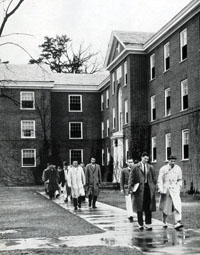 The “pressure to conform” to the mass was one of Faulkner's favorite topics in his sessions with UVA
audiences. To him it is perhaps the chief threat facing modern society
The “pressure to conform” to the mass was one of Faulkner's favorite topics in his sessions with UVA
audiences. To him it is perhaps the chief threat facing modern society
 . He brought that concern with him to Virginia, but what he found at UVA probably only increased it. These were what Robert
Lowell called “the tranquilized Fifties,” and despite or because of Cold War fears about nuclear annihilation
there was a widespread national longing for what journalists were calling “normalcy.” Even so, the environment
at UVA in the late 1950s exalted conformity – though the students called it “tradition.” The suit
jackets and ties that students wore to all classes and public events as a kind of uniform were the outward and visible sign of a
community that was comfortable with the world that they found themselves in, and devoted to the rituals of the previous
generations of students. “Gentleman” was a word that resonated much more deeply with them than
“intellectual” or “artist.”
. He brought that concern with him to Virginia, but what he found at UVA probably only increased it. These were what Robert
Lowell called “the tranquilized Fifties,” and despite or because of Cold War fears about nuclear annihilation
there was a widespread national longing for what journalists were calling “normalcy.” Even so, the environment
at UVA in the late 1950s exalted conformity – though the students called it “tradition.” The suit
jackets and ties that students wore to all classes and public events as a kind of uniform were the outward and visible sign of a
community that was comfortable with the world that they found themselves in, and devoted to the rituals of the previous
generations of students. “Gentleman” was a word that resonated much more deeply with them than
“intellectual” or “artist.”
 Faulkner’s picture appears twice in the 1957 Corks and Curls, in the “Features”
section (see below). Judging by the yearbook’s annual emphases, however, the chief features of student life at
UVA were fraternities, football games, and the three regularly occuring “big weekends” – Openings,
Mid-Winters, and Easters, supplemented by other annual events like the Beaux Arts Ball. For each of the three
“big” weekends The Cavalier Daily published expanded editions, allowing them to list all the women
(from other schools, of course) who would be attending, along with the names of their UVA dates. Again to judge by the
yearbook’s photos, music and alcohol were the main ingredients of these weekends. No one asked Faulkner during any of
his sessions about Gowan Stevens, the character in Sanctuary who has just graduated from Virginia and can’t
stop talking about how he’d “learned in a good school” how to drink, which turns out to mean how to
get drunk; if Faulkner’s interrogators were embarrassed to bring Gowan up, though, the yearbook seems to celebrate
displays of drunkenness. This prevailing alcoholic culture makes it hard to know how to “read” the photograph
above left, published on the front page of The Cavalier Daily's “Mid-Winters
Issue,”which appeared the morning after Faulkner gave his speech exhorting Virginians to show the rest of the South the
way toward integration – a picture of the Writer-in-Residence coming out of the liquor store with a paper bag in his
hands. Is it an attempt to undercut his message by suggesting it came out of a bottle of booze? or does it imply (especially since
students would be stocking up their own bottles for the weekend) that Faulkner is “one of us”? (The photo was
taken by Ken Ringle, who discusses it in his essay on Faulkner at UVA; in the first issue
of the CD after the weekend, the paper ran an editorial about the speech,
expressing disappointment with Faulkner’s inadequacies as a speaker, but approving the way “Faulkner's
proposal [for improving Negro education] offers the compromise between the dogmatism of the North and the South on the
subject.”)
Faulkner’s picture appears twice in the 1957 Corks and Curls, in the “Features”
section (see below). Judging by the yearbook’s annual emphases, however, the chief features of student life at
UVA were fraternities, football games, and the three regularly occuring “big weekends” – Openings,
Mid-Winters, and Easters, supplemented by other annual events like the Beaux Arts Ball. For each of the three
“big” weekends The Cavalier Daily published expanded editions, allowing them to list all the women
(from other schools, of course) who would be attending, along with the names of their UVA dates. Again to judge by the
yearbook’s photos, music and alcohol were the main ingredients of these weekends. No one asked Faulkner during any of
his sessions about Gowan Stevens, the character in Sanctuary who has just graduated from Virginia and can’t
stop talking about how he’d “learned in a good school” how to drink, which turns out to mean how to
get drunk; if Faulkner’s interrogators were embarrassed to bring Gowan up, though, the yearbook seems to celebrate
displays of drunkenness. This prevailing alcoholic culture makes it hard to know how to “read” the photograph
above left, published on the front page of The Cavalier Daily's “Mid-Winters
Issue,”which appeared the morning after Faulkner gave his speech exhorting Virginians to show the rest of the South the
way toward integration – a picture of the Writer-in-Residence coming out of the liquor store with a paper bag in his
hands. Is it an attempt to undercut his message by suggesting it came out of a bottle of booze? or does it imply (especially since
students would be stocking up their own bottles for the weekend) that Faulkner is “one of us”? (The photo was
taken by Ken Ringle, who discusses it in his essay on Faulkner at UVA; in the first issue
of the CD after the weekend, the paper ran an editorial about the speech,
expressing disappointment with Faulkner’s inadequacies as a speaker, but approving the way “Faulkner's
proposal [for improving Negro education] offers the compromise between the dogmatism of the North and the South on the
subject.”)
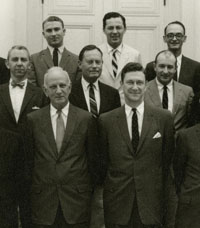 Although probably only about half of the people who ask Faulkner questions on the tapes were UVA students, the most common
setting for these sessions was an English Department class. In 1957 and 1958 the department’s faculty were also all
white and male, and as you can hear by their accents on the tapes, mostly from the South. (It was several years after
Faulkner’s residency that Fredson Bowers became departmental chair and launched an ambitious effort to re-make UVA
English by recruiting scholars nationally; by the time I arrived at UVA in 1974, I heard few southern accents at department
meetings.) Even senior faculty taught first-year composition and second-year introductory courses. The study of literature was
essentially as steeped in tradition as the mores of the undergraduates. During the 1956-1957 academic year the department offered
36 undergraduate and 24 graduate literature courses. Only two authors were studied separately – Chaucer and Shakespeare;
at the graduate level Fredson Bowers taught “Spenser and Milton” in addition to
“Shakespeare.” Only seven courses were dedicated to American literature, three for undergraduates, all taught
by Frederick Gwynn, and four for grad students taught by Floyd Stovall, the department’s most recognized Americanist and
departmental Chair during Faulkner’s tenure. There were also three courses taught by Edward McAleer in twentieth-century
writers – none at the graduate level. Most of Faulkner’s classroom sessions are with students in these groups
of classes and Joseph Blotner’s undergrad courses on “The Novel,” though he also answered questions
from students in both introductory and writing classes who had read one of his stories.
Although probably only about half of the people who ask Faulkner questions on the tapes were UVA students, the most common
setting for these sessions was an English Department class. In 1957 and 1958 the department’s faculty were also all
white and male, and as you can hear by their accents on the tapes, mostly from the South. (It was several years after
Faulkner’s residency that Fredson Bowers became departmental chair and launched an ambitious effort to re-make UVA
English by recruiting scholars nationally; by the time I arrived at UVA in 1974, I heard few southern accents at department
meetings.) Even senior faculty taught first-year composition and second-year introductory courses. The study of literature was
essentially as steeped in tradition as the mores of the undergraduates. During the 1956-1957 academic year the department offered
36 undergraduate and 24 graduate literature courses. Only two authors were studied separately – Chaucer and Shakespeare;
at the graduate level Fredson Bowers taught “Spenser and Milton” in addition to
“Shakespeare.” Only seven courses were dedicated to American literature, three for undergraduates, all taught
by Frederick Gwynn, and four for grad students taught by Floyd Stovall, the department’s most recognized Americanist and
departmental Chair during Faulkner’s tenure. There were also three courses taught by Edward McAleer in twentieth-century
writers – none at the graduate level. Most of Faulkner’s classroom sessions are with students in these groups
of classes and Joseph Blotner’s undergrad courses on “The Novel,” though he also answered questions
from students in both introductory and writing classes who had read one of his stories.
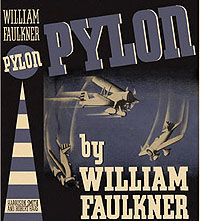 On the tapes you’ll hear a lot of questions about the meaning of specific symbols in specific texts. This focus was a
symptom of the times, not the place. In 1959, for example, Flannery O’Connor met with teachers and students at Wesleyan;
her report of the event suggests how in college classrooms across the U.S. in the Fifties the study of literature emphasized the
interpretation of symbols: “Week before last I went to Wesleyan and read A Good Man Is Hard To Find. After it I went to
one of the classes where I was asked questions. There were a couple of young teachers there and one of them, an earnest type,
started asking the questions. ‘Miss O’Connor,’ he said, ‘why was the Misfit’s
hat black?’ I said most countrymen in Georgia wore black hats. He looked pretty disappointed. Then he said,
‘Miss O’Connor, the Misfit represents Christ, does he not?’ He does not. He said, ‘what it
is the significance of the Misfit’s hat?’ I said it was to cover his head; and after that he left me alone.
Anyway, that’s what’s happening to the teaching of literature.”
*
Faulkner sometimes sounds equally tired of similar questions about his work
On the tapes you’ll hear a lot of questions about the meaning of specific symbols in specific texts. This focus was a
symptom of the times, not the place. In 1959, for example, Flannery O’Connor met with teachers and students at Wesleyan;
her report of the event suggests how in college classrooms across the U.S. in the Fifties the study of literature emphasized the
interpretation of symbols: “Week before last I went to Wesleyan and read A Good Man Is Hard To Find. After it I went to
one of the classes where I was asked questions. There were a couple of young teachers there and one of them, an earnest type,
started asking the questions. ‘Miss O’Connor,’ he said, ‘why was the Misfit’s
hat black?’ I said most countrymen in Georgia wore black hats. He looked pretty disappointed. Then he said,
‘Miss O’Connor, the Misfit represents Christ, does he not?’ He does not. He said, ‘what it
is the significance of the Misfit’s hat?’ I said it was to cover his head; and after that he left me alone.
Anyway, that’s what’s happening to the teaching of literature.”
*
Faulkner sometimes sounds equally tired of similar questions about his work
 , though his answers, while often evasive, are always courteous.
, though his answers, while often evasive, are always courteous.
While UVA students may have studied literature in much the same way as students elsewhere in the country, in most respects the environment on the Grounds was very provincial. In some respects Faulkner and his voice fit right into this picture. At the beginning of his stay Faulkner announced that one of his goals in coming to Virginia was “to help create an atmosphere.” He didn’t elaborate, but at least one of the students who was here at the time, Gerald Cooper, believes that Faulkner’s presence made students more likely to realize that there was a larger world and other ways of thinking and acting about it and in it.
“The University in the Late Fifties,” by Ken Ringle (UVA ’61)
Images from Corks and Curls, the UVA yearbook —
Images from UVA Prints Collection, Alderman Library —
The “Jim Crow Issue” of Virginia Spectator (May 1957):
Images from the “Jim Crow Issue” —
Articles from the “Jim Crow Issue” —
- Up and Down from Slavery (issue introduction)
- Keynote (introduction to the essays (issue introduction)
- Why I Believe in Integration, by Sarah Patton Boyle
- Integration in Virginia, by Edwin B. Henderson
- Letter to the North, by William Faulkner
- Segregation or Death, by John Kasper
- Integration Means Degeneration, by Floyd Fleming
- Sutee, by Thomas Hawley (story)
- The Workout, by B. B. Schwartz (story)
- La Tour Abolie, by John H. Sacks (story)
- Crassingwick, by James McNally (poem)
Articles about integration (including women) from The Cavalier Daily —
- Legislature Passes Segregation Plan After Bitter Struggle (25 September 1956)
- Anti-Integration Blast Rocks Clinton Negroes (28 September 1956)
- Yale's Co-ed Panic (10 October 1956)
- Three Professors Argue for Integration (17 November 1956)
- Clinton Classroom Integrated Quietly (11 December 1956)
- Prominent Integration Leader Boyle Decries 'Cool' Motives Of Virginians (4 January 1957)
- Mrs. Boyle's Letter Called 'Paradoxical' (5 January 1957)
- Writer Hits Violence In Racial Issue (19 February 1957)
- Letter To The Editor [Clinton Bomb photo] (26 February 1957)
- Integration Leader Attacked By Whites (7 March 1957)
- High Court Refuses To Change Virginia Desegregation Rulings (26 March 1957)
- The Order To Desegregate (26 March 1957)
- Mistaken Invitation And A Damaged Reputation (16 April 1957)
- SC Examines Spectator/Council To Investigate 'Segregation' Issue (8 May 1958)
- Council Investigates Spectator (8 May 1957)
- Opinion Poll Next Week (10 May 1957)
- Cavalier Daily Will Conduct Poll On Integration (14 May 1957)
- Tomorrow's Poll (14 May 1957)
- Cavalier Daily Conducts Poll On Segregation (15 May 1957)
- Important Choice (15 May 1957)
- Sparse Voting Endorses Gray Plan (16 May 1957)
- Opinion Poll (16 May 1957)
- Letter to Editor [Opinion Poll] (17 May 1957)
- Law School Team Banned From Field (17 May 1957)
- Integration Report In Social Functions At U Given By Student Council (22 May 1957)
- Desegregation At The University (22 May 1957)
- Segregation: More Understanding Needed (17 September 1957)
- The Old States' Rights Question (24 September 1957)
- The Little Rock Fiasco (26 September 1957)
- Student Legal Forum Sponsors Discussion of Civil Rights (26 September 1957)
- The Female Equivalent (12 October 1957)
- Segregation Statement Issued by Copeley Hill (7 November 1957)
- Women, Wahoos and Words (12 February 1958)
- Darden Says Christianity Only Force That Can Combat Communist Threat (1 May 1958)
- Charlottesville Showdown (14 May 1958)
Below: "Registration and Orientation at Memorial Gymnasium," Ralph Thompson photo from UVA Prints Collection [Image Filename: prints01717; undated, but late 1950s]. Caption on back: "Students line up for courses at registration."

Below: Delta Kappa Epsilon fraternity, from Corks & Curls, the UVA yearbook (1957 edition, vol. 69, p. 85).
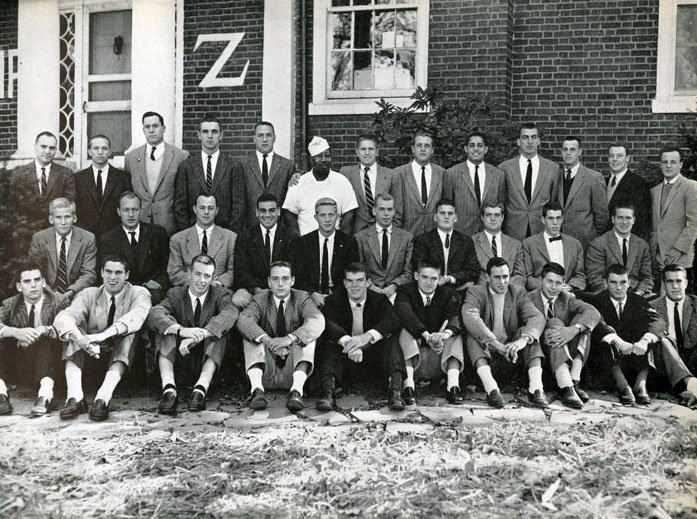
The Cavalier Daily 22 May 1957: 2
Desegregation at the University
Last year's Student Council drafted a statement setting forth their position regarding social integration of the white and Negro races in University-connected activities (See text of statement on Page 1). The document has just been released for publication.
From beginning to end, this Council paper exhibits calm judgement which makes it a refreshing change from much of what we hear relative to the problem of racial integration in the South today. Rather than try to write rules and regulations covering the situation, the Council calls for nothing more than wise discretion on the parts of all students.
We feel that the success or failure of race relations at the University now rests largely in the hands of Negro students enrolled. Desegregation has gone over smoothly here because it has not been rushed by the colored race and because it has not caused social mixing between white and Negro. Even when the two have attended dances together in Memorial Gymnasium, there has been not the slightest hint of trouble or violence.
Any attempt at exploiting this situation by either race will destroy this atmosphere of calm and good will and result in conflict which will bring both chaos and disgrace to the University. We hope that the same mature judgement and good sense will prevail in the future which we have witnessed in the past and that other colleges and universities will take note of the progress which this attitude has caused here. Both races can be justly proud of racial relations between students of this University.
©1957 The Cavalier Daily
Below: Cover from the "Jim Crow Issue" of the Virginia Spectator monthly magazine (May 1957; vol. 118, no. 8).
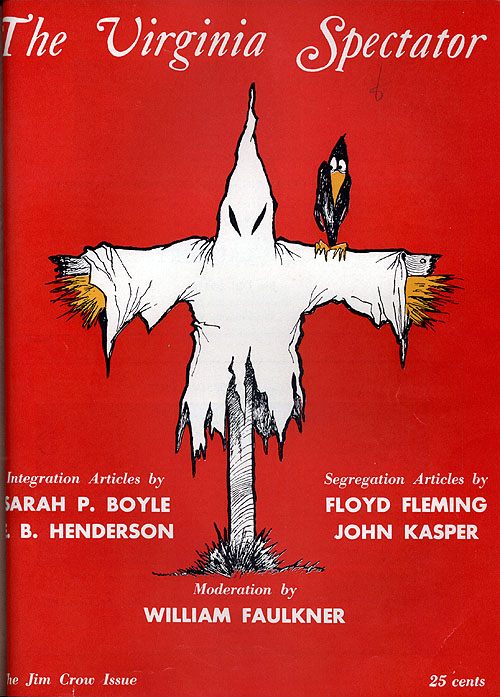
The Cavalier Daily 8 May 1957: 2
Council Investigates Spectator
An important decision was made in Monday night's meeting of the Student Council. Four Councilmen have been assigned to investigate the forthcoming issue of the Virginia Spectator due on the stands Friday. The magazine will be devoted to a study of racial segregation. The Council decision to look into this matter is one which has taken courage and which reflects deep concern over the potentialities of such a magazine.
Five articles will be presented. John Kasper, arch-segregationist of Clinton, Tennessee, and Charlottesville notoriety, has written an argument in favor of separation entitled "Segregation or Death." This is the first piece written for publication by this person.
A second pro-segregation article, "Segregation Means Degeneration," has been submitted by Floyd Fleming, Vice-President of the Seaboard White Citizens Council on which Kasper is Executive Secretary.
Two authors have written pro-integration articles. Sarah Patton Boyle of Charlottesville has contributed "Why I Believe in Integration" and Virginia NAACP president Edwin B. Henderson has submitted "Integration in Virginia."
William Faulkner, noted author and University Writer-in-Residence, has written a "middle-of-the-road" stand which previously appeared in Life Magazine, "A Letter to the North." There is little doubt that this issue of the Spectator will receive wide attention and comment.
We say that the Council decision to investigate was courageous because another course of action (or inaction) was available to them. They could just as easily have ignored this matter and waited to see what reaction it would cause after the Spectator had gone on sale. In taking the more positive approach and looking into this magazine before it reaches the public, the Council not only risks charges of interfering with the free press (which they are in no way doing) but more important, they fore themselves into the position where they must publicly go on record either in favor of or opposed to publication of the issue. This is not an envious position but, as several Councilmen stated, one to which they are obligated by virtue of the office to which they were elected.
It is one thing to investigate and another to act. If the Student Council finds this magazine unacceptable to the University, what measures can they take against the Spectator Corporation? Two regulations seem to apply–one a Council bylaw and the other a University regulation. Section 5 of Bylaw IV states,
"All student organizations excepting the Honor Committee, the Judiciary Committee, and self-governing groups hold their power from the Student Council and are subject to the regulations of the Council."
University regulations as set forth in the University of Virginia Record specify, after referring to a list of approved publications, that:
"...students who wish to publish, distribute or sell any other publication must first obtain approval of the Student Council..."
(The reference to "other" publications would at first imply that the Council authority extended only to activities not included in the above-mentioned list of approved publications. But, authority over one such organization certainly implies authority over them all in a case such as this.)
We hope that there will be no need to use either of these rules against the Spectator. Presentation of this issue, if handled intelligently and maturely, can make the magazine a genuine contribution to the study of racial segregation and integration and a credit to the University. Anything short of this however, can make it a disaster. In this fact is found justification for the Council's choice to investigate. The handling of this matter calls for thought and good judgement on the parts of all persons concerned. We believe it will receive just this.
©1957 The Cavalier Daily
The Cavalier Daily 10 May 1957: 2
Opinion Poll Next Week
William Faulkner said yesterday, "I'd like to see more undergraduates of this University express their opinions on topics of wide interest." In this short statement, Mr. Faulkner probably struck the principal failing of this student body. It gets back to the old problem of apathy, or whatever else one might wish to label it.
Today's Spectator marks somewhat of a departure from this silence and it has been the policy of this newspaper to comment on any and all such issues as they arise. What is missing however, is response from readers and members of the student body.
We hope to correct this on at least one problem–school segregation in Virginia–through a University-wide poll in one of next week's publications. The student body will be asked its opinion on the methods in which the state government is currently handling the school problem as it faces us today. If the response from this poll is as complete as was the one from last year's straw ballot on the Presidential election, a valuable service will have been done in showing how the younger people of this state react to what we believe is Virginia's gravest problem.
©1957 The Cavalier Daily
The Cavalier Daily 15 May 1957: 2
Important Choice
Since May 17, 1954, when the U.S. Supreme Court decided that the practice of school segregation by race was illegal, many plans have been proposed as solutions to the problem which has arisen. Among these many, two have received wide attention in Virginia–the Gray Plan and the Stanley Plan.
The first was approved in a statewide referendum of January 9, 1956 and the second became state law when enacted by the Virginia General Assembly last summer.
Gray Plan
The Gray Plan was submitted to Governor Stanley in the fall of 1955 by the Commission on Public Education, headed by State Senator Garland Gray. It was designed to place barriers in the path of school integration but, at the same time, to allow some degree of desegregation in areas where it was felt that such a plan would be acceptable to parents of school children.
In cases where children would have been forced into integrated schools against their wills, however, a financial grant would have been provided to be used toward the private school education of these students.
The plan was originally accepted by the Governor Stanley who then submitted it to the people for approval in the statewide referendum. It then received a 2 to 1 endorsement by the voters of Virginia.
Between the time of its popular approval and its official enactment into law by the General Assembly, apparent resentment grew over the section of this plan which allowed limited desegregation in certain areas and which accepted the principle of racial integration. Out of this resentment came a second plan different from the first in that it allowed no integration in any school and set the state directly in defiance of the court order to desegregate. This was the Stanley Plan, introduced by Governor Thomas B. Stanley.
Stanley Plan
The Stanley Plan withdrew pupil assignment authority from the local school boards and vested it in a central Placement Board, appointed by the Governor. It further provided that no state funds would go to any white school which enrolled a Negro pupil. In this way, no such school could operate as a part of the Virginia system when its classes were desegregated.
Some have argued that the Stanley Plan is unconstitutional and will lead the state to massive integration and a wrecked school system after the plan has failed in the courts. These persons contend that a policy of limited desegregation, even if this means only a handful of cases in the next decade, will be regarded by the Federal courts as sufficient progress in the right direction and that court pressure to integrate will therefore be lifted.
Advocates of the Stanley Plan on the other hand, believe that even token acceptance of integration will lead to its mass application in the schools of Virginia. They feel that any integration anywhere will destroy the public school system of our state.
To Prevent Integration
Both plans have a common goal–prevention of racial integration in the public schools. Where they differ is in this point. The Gray Plan says that the Supreme Court decision must be complied with if we are to avoid violent and forced integration in the schools. The Stanley Plan, however, favors open defiance of integration everywhere. It does not recognize the Supreme Court decision as law, and its proponents believe that "massive resistance" will nullify its effects on Virginia's schools.
The decision we, as students of this University, must make in today's poll is of vital importance. Whatever course is elected by our state leaders today will have to be applied by us tomorrow. If our state legislators are wise, they will regard what we decide here with seriousness. The problem is in their hands now but its effects will fall on our generation later. Because of this, we have a right to be instrumental in its solution.
©1957 The Cavalier Daily
The Cavalier Daily 16 May 1957: 1
Sparse Voting Endorses Gray Plan
Students Favor Bill By Two-To-One Edge
'Limited Desegregation' Gets Nod; Poll Parallels Statewide Opinion
University students participating in yesterday's Cavalier Daily Opinion Poll endorsed the Gray Plan over the Stanley Plan by over a 2 to 1 margin. A total vote of only 488 was cast in the elections, which was considered "disappointing" by sponsors of the school segregation poll.
The two plans voted upon were measures considered in Virginia to meet the current school problems. The Stanley Plan, now law in the state, proposes total resistance against racial integration in the schools, whereas the heavily favored Gray Plan accepted a pupil assignment policy which would permit limited desegregation in certain areas.
The Gray Plan had been approved in a statewide referendum during January of 1956 an later disregarded in favor of the Stanley Plan when the legislature expressed the opinion that limited integration would be intolerable in Virginia schools.
Virginians favored the Gray Plan by approximately the same majority it received in the total student vote. Northerners voted Gray 3 to 1 and out-of-state Southerners were 3 to 2 in favor of the Gray Plan.
Totals were 312 Gray to 143 Stanley with 33 voting "neither" for the whole University. In-state students chose the Gray Plan 195 to 96 for Stanley. Out-of-state Southerners were [illegible] Gray and 25 Stanley. Northerners favored Gray 71 to 23.
Several ballots state that neither plan was constitutional, one said "we must have complete integration," and two called both plans incapable of stopping desegregation.
The vote from Virginians was nearly double that of out-of-state students, this margin being 291 to 156.
In total votes cast, the College led with 223, with Engineering casting 61, Law 52, Commerce 34, Education 25, Medical 15 and Graduate Business 11. 67 votes were cast in the Commons box.
The school most heavily favoring the Gray Plan was the Law where 35 voted with the Gray Plan, 6 for Stanley and 11 for "neither."
Alone among the other schools, the School of Medicine favored the defeated Stanley Plan 8 to 7.
This poll is the first one of its kind known to have been taken at a college or university on the subject of school segregation.
©1957 The Cavalier Daily
The Cavalier Daily 17 May 1957: 2
Letter to the Editor
Dear Sirs,
In regards to your last poll, I believe that the lack of voting was not due to the dis-interest of the student body but rather to the haphazard way in which you organized your polling system. Due to your insufficient number, poor locations, and unmanned stations, the poll became a failure.
Sincerely, Fim Feeley
Editor's note—Ten ballot boxes were distributed throughout the University covering every school with the exception of the School of Architecture which, through an unfortunate error, was missed in the box placement. It would be difficult to administer a more comprehensive poll than this and we must conclude that it was more a lack of interest in the question asked than any other factor which contributed to the poor response.
©1957 The Cavalier Daily
Below: Students walking from dorms to class, from Corks & Curls, the UVA yearbook (1957 edition, vol. 69, pp. 68).
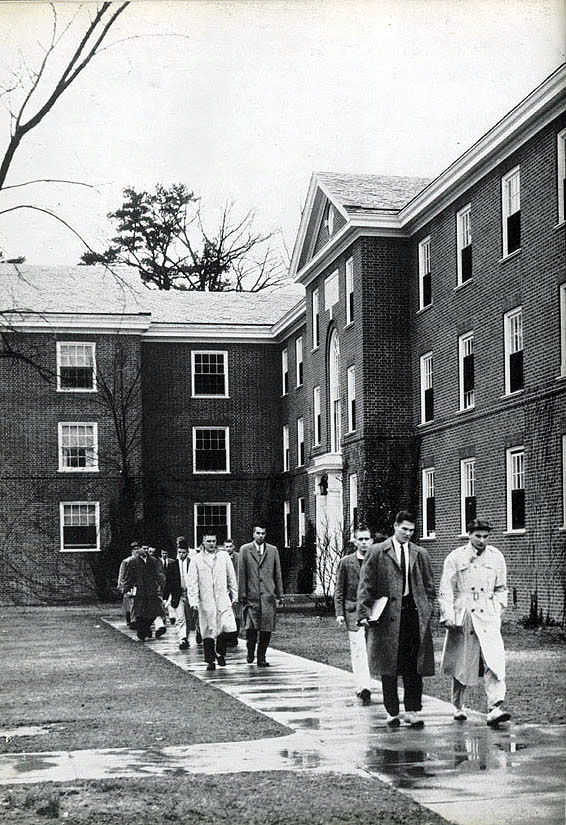
Below: The photo that appeared on the front page of UVA's student newspaper, The Cavalier Daily, on 21 February 1958, the morning after Faulkner gave his speech on integration, titled "A Word to Virginians."
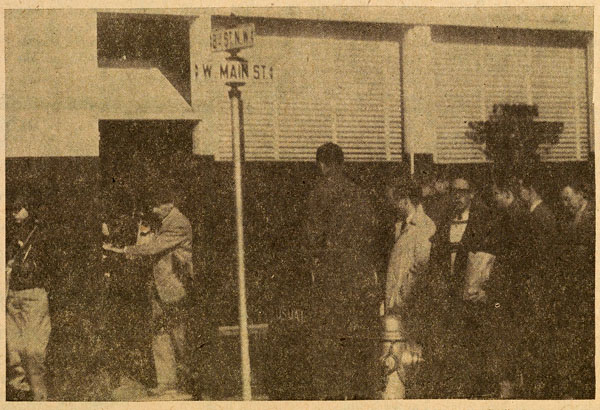
Caption: "BOYS CLUB CLIENTELE— Author William Faulkner (exiting door, with package) leaves the Virginia Alcoholic Beverage Control Board establishment at 8th and Main Streets. Group of unidentified University students loiter nearby. Man on far right reads Spectator Magazine's new issue. Store is one of two in Charlottesville. — Staff Photo by Behlen."
The Grounds and the Fury: William Faulkner at the University, 1958
By Ken Ringle (College ’61)
God obviously created William Faulkner to explain the American South. He may have regretted it, because then He needed an army of scholars, critics and teachers to explain William Faulkner.
Those of us who found ourselves on the same campus with him half a century ago in Charlottesville needed at least that much aid. Faulkner himself was not much help at all. It wasn’t for lack of availability. The agreement that made him the University of Virginia’s first writer in residence in 1957 and 1958 specified that he keep regular office hours something like once a week. Those of us hoping to write our own selves into immortality (or at least into the arms of English majors at Sweet Briar) would show up to sit at his feet and study the muse.
Surprisingly, the regulars were a pretty small group, perhaps because the novelist rarely said much. He would lean back in his chair in his tweed sport coat, khakis and a green wool tie with little fox heads on it, then puff on his pipe and make infrequent gnomic pronouncements. We would sit there gaping, wracking our under-booked brains for some question that wouldn’t make us look stupid.
“Mr. Faulkner, in your short story ‘The Bear,’ do you consider the bear a positive nature symbol or a negative nature symbol or a symbol both positive and negative like the white whale in Moby-Dick?”
“Oh,” he’d eventually say in his thin, reedy voice, after puffing on his pipe long enough to raise the suspense: “That’s just a story about a bear.”
I was usually too intimidated to ask anything. Though I was certain I was destined to write the Great American Novel, I was mortified that I found his work unfathomable. How could I write a novel when I couldn’t even read his?
“Mr. Faulkner, how do you start a novel? How do you even know what you want to write about?”
Pause while he stroked his gray mustache.
“M’boy you have to write because you can’t not write. You have to be demon-driven by what’s inside you.” More pipe puffing. What the hell did that mean? It was years before I’d learn.
Stalking him for clues became a passion. Once, on my job shelving books at Alderman Library, I borrowed the key to the room in the stacks where he wrote. He’d just finished The Mansion and I thought the pictures on the wall, the books he used for reference, his general writing environment would give me clues on how to be a writer. I found the answer, but not the one I expected. The room was absolutely bare. There was nothing in it but one of the library’s standard oak tables and a chair, an upright Underwood typewriter and a big stack of writing paper. Nothing else. No books, no pictures or posters on the wall, no jottings, no comfy sweaters, not even a dictionary. It was all in his head. How depressing.
Undeterred, I soldiered on. Faulkner liked to wander around the university grounds and observe things, usually from beneath one of those little green Tyrolean hats with the shaving brush in the hatband. I would run across him regularly near Lambeth Field, where he used to idle at track practice. He showed little interest in the major university sports of football and lacrosse, but would spend hours timing sprinters and hurdlers with two stop watches that never seemed to agree.
I pondered that for clues. Maybe it had something to do with the horses in his books and stories. He rode to hounds with the Farmington Hunt and always rode horses too big for him, which greatly excited Freudians in the English department. But I wasn’t sure what it told me.
He didn’t appear demon-driven whenever I saw him. Just a meditative onlooker, galloping somewhere deep in his imagination.
Not all our encounters were planned. In the winter of 1958, as a photographer for the Cavalier Daily, I was stationed across from the Virginia ABC store on Charlottesville’s Main Street to get a shot of students stocking up for Midwinters weekend. I was framing the line snaking into the door on the right when out of the door on the left came William Faulkner. Wholly dwarfed by his enormous burden of bottle-packed shopping bags.
In those days college drinking was a source of more celebration than hand-wringing, particularly at Virginia, and we merrily ran the picture on the CD’s front page. The English department faculty was horrified. Faulkner was not. “They caught me,” he said with a grin.
The faculty reaction was symptomatic. In those days novelists didn’t hang around campuses much, believing real life a more profitable laboratory for observation. Faulkner was such a prize that obsequious professors all but laid their coats over puddles in his path. The writer himself, who lacked even a high school diploma and was famously disdainful of academics, remained polite but distant, countering scholars’ questions with mischievously opaque replies.
His agreement with the university specified that he was required to give no more than an occasional speech and no classroom lectures at all. But, in addition to keeping office hours, he was to answer questions periodically from both graduate and undergraduate students in a classroom setting. Thus he was regularly led before us like a trained bear to deepen the mystery of just what he meant by the biblical allusions in Light in August or the stained-glass imagery in Go Down, Moses. There was much tape-recording of all this, the results appeared years later in Frederick L. Gwynn and Joseph Blotner’s book Faulkner in the University. But Gwynn and Blotner edited out much of the mischief.
Unenlightened by such sessions and despairing of unlocking Faulkner on my own, I sought out a superb young English instructor named John Graham, who was far more passionate about nourishing learning than about nourishing cults of celebrity.
“I’m not surprised you found Faulkner difficult,” he said. ”You probably started off trying to read The Sound and the Fury.” I had. “Everyone does that. It’s his best-known book. But it’s also his most difficult.”
The way to read and appreciate William Faulkner, he said, was to take one of two routes. To just sample his power with language and as a teller of tales, he said, read “Old Man.” It’s a mesmerizing short novel – originally part of The Wild Palms – about the 1927 Mississippi flood and a convict trapped therein with a pregnant woman who, in one of literature’s great Gothic sequences, gives birth in a swamp atop an Indian mound aswarm with cottonmouth water moccasins.
To go further and understand Faulkner’s panoramic sweep of history, he said, one should start with The Unvanquished, a historical novel that’s one of his most accessible. It deals with the earliest years in his saga of the Southern aristocracy. Then read Absalom, Absalom! and Go Down, Moses, which continue the story of the aristocratic decline and focus on how that affects blacks. Then The Hamlet, which charts the rise of the poor white Snopes clan. Then, he said, you’re steeped in Faulkner’s mythical Yoknapatawpha County and its secrets of blood and history, and ready for all his other books, which weave in and out of the cultural stream he chronicles with such power.
Graham’s insight, which I’ve never seen published anywhere, finally unlocked William Faulkner for me. And as it did, his books became a passion and the writer himself seemed to open up. One day as we talked in his office, he presented me with an insight as valuable today as it was then.
“Mr. Faulkner,” I asked him “In your book As I Lay Dying, most of the characters are socially pretty reprehensible. The only one with any kind of sensitivity or nobility is Addie Bundren, the schoolteacher. Yet you have her marry Anse Bundren, absolutely the most dreadful of the whole lot. How can you justify that?” Faulkner rubbed his mustache and re-lit his pipe, then looked at me a long, long time.
“My boy,” he finally said in his slow drawl. “Haven’t you ever heard the story of the beautiful butterfly? That flitted from flower to flower? And lit at last on a horse turd?”
Despite the courtly charm with which he inevitably responded to those who approached him, Faulkner was normally reserved and, though he basically liked students, he appeared somewhat remote and most held him in awe.
But not all students were so cowed.
One who wasn’t was a fraternity brother of mine named Zeke Waters. Zeke was a jovial good-hearted guy but, like most of us then, did not over-exert himself in the classroom. He was always looking for shortcuts.
One spring evening we were lounging in he sun on the porch of the Beta House next to Beta Bridge before dinner. Zeke was panicked. He was an English major and the next day faced the dreaded senior “comprehensives”, the do-or-die examinations which in those days tested every student facing graduation on the entire body of knowledge absorbed in his major field of study over four years. Zeke was weak on American literature, and was looking for some quick fix to repair the situation. Where could he find it? he asked us. He got a few opinions but mostly shrugs. Then, from the direction of the Rotunda he spotted William Faulkner, walking home to his house up Rugby Road.
“That’s it!” said Zeke. “Faulkner knows all about American literature! He can tell me what I need to know!”
Now, I’m pretty sure Zeke had never read a line of Faulkner’s, but he was the most amiable and approachable of souls, and could make friends with a tree. He loped across Rugby road, greeted Faulkner and soon they disappeared together up the road and over the hill chatting, tall and lanky Zeke with his arm around Faulkner who was a kind of splendidly dapper but miniature man.
An hour or more went by. Zeke did not appear and we Betas went in to dinner without him. Finally, after dinner, Zeke showed up.
How did it go? we all wanted to know. Did Faulkner give you the keys to American literature?
“Well, not exactly,” said Zeke. “He couldn’t have been nicer and we talked about all sorts of things. But I never quite got him around to where I could ask the right question.”
It turned out Faulkner appeared glad to meet Zeke and grateful for the company on his homeward stroll. They chatted about the weather, the football weekend, where Zeke was from and other topics. When they got to Faulkner’s house, he asked Zeke in. He said his wife was away, the housekeeper was fixing dinner but he was going to have a drink first. Would Zeke like one too?
Zeke, like most students, never turned down a drink and soon they were seated companionably in Faulkner’s living room sipping good bourbon. The talk turned to horses, the pictures on the wall, the house – Faulkner liked Charlottesville because his daughter lived there – and so on. Faulkner suggested a second drink. Zeke accepted. There may have been a third.
“I was trying to think how to get him around to the literature question when the housekeeper came in and said dinner was ready,” Zeke said. “Faulkner is just the most courteous man in the world. He asked me to stay to dinner, saying there was plenty to eat. I protested no, I couldn’t do that, I was expected back at the Beta house. But I said I would come in the dining room with him and finish my drink while he ate. I was still trying to work him around to American literature.”
The housekeeper had arranged the small dining room beautifully, Zeke reported, with crystal, wine glasses, a vase of flowers and so on, all set off by a splendid white table cloth. Faulkner sat down and began spooning his soup. Zeke stood against the wall with his glass of bourbon, making conversation, trying desperately to turn the talk to books.
“That’s when it happened,” Zeke said. “For some reason I crossed my legs while I was standing there talking and thinking, and I lost my balance.”
Down he slowly toppled, grabbing desperately for support. He caught the end of the tablecloth. Off came the tablecloth, the vase, the glasses, the flowers, Faulkner’s soup, everything. The sound of crashing crockery and glass, Zeke said, seemed to go on forever.
Faulkner, who had somehow escaped both injury and stains, was unconcerned by the mess. He was worried Zeke might have hurt himself. He picked Zeke up, brushed him off, apologized for the incident and asked once again if Zeke wouldn’t stay and share the rest of the dinner.
“But I decided it was time to leave,” Zeke said. “Because even though I hadn’t had a chance to ask him about literature and even though Faulkner could not have been nicer, that housekeeper was really, REALLY pissed off.”
I can’t remember if Zeke passed his comprehensives.
©2009 Ken Ringle
Ken Ringle retired in 2003 after 33 years as a writer, editor, essayist and critic for The Washington Post. His work has also appeared in The National Geographic, Smithsonian, European Affairs and other publications, and he has been a writer-in-residence himself as a Washington Post Fellow at Duke University.
The Cavalier Daily 25 February 1958: 2
Mr. Faulkner On Segregation
To all who heard William Faulkner speak last Thursday night on the subject of segregation, it was readily apparent that our writer-in-residence is no orator. Mr. Faulkner was able to stretch his speech out to only fifteen minutes, which was disappointing to us, for his speech was widely publicized and his audience was composed of the most distinguished citizenry of the University community. And Faulkner read his speech, an unforgivable sin in oratorical circles.
BUT THE evening was not totally disappointing. Regardless of his speaking ability, the novelist did offer what we believe to be the only working solution to the biggest social problem in the South in the text of his speech and during the questioning period. Faulkner's main premise for his proposals can be summed up in one word, "education." And we have been stressing the value of that premise for the last three weeks.
Faulkner's proposals were based on his observations of Negroes from Mississippi to Virginia. Considering his insight into human nature as evidenced in his novels, and his acquaintance with Negroes and their problems (we have heard that he sits on a nail keg down by the liquor store on Vinegar Hill observing and taking notes) we feel that his proposals have much merit and are worthy of review.
In his speech, Faulkner offered the view that the Negro wants the right to decide for himself whether to mix. And this cannot be done without education. The Negro, Faulkner pointed out, believes the white schools are fundamentally better than Negro schools, and that is his reason for wanting integration.
And he also pointed out that economic equality should be the goal to be strived for, rather than social equality. The author believed that once the Negro did obtain economic equality, which can only be accomplished through education, then he would have the right to decide for himself whether to mix, and probably would defend segregation when he could decide for himself.
As for integrating schools, Faulkner indicated that Negro students should be given the right to choose between white and Negro schools, and that qualified Negroes should be allowed to go to white schools. Such qualification would be based on entrance examinations. And he also observed that no one, not even white people, should be forced to go to school, and that laws requiring education should be abolished. The writer reserved a half century for any such educational program or educational equality to establish itself.
WE FEEL that Faulkner's proposal offers the compromise between the dogmatism of the North and the South on the subject. And we could remind the North again that the problem is fundamentally our own, and that helpful advice will do more to alleviate the situation rather than biased and unsound criticism.
Mr. Faulkner's speech, entitled "A Message to Virginians" was directed toward the prominence which Virginia has held and still holds in the South as a leader. His idea was that it was up to the "Old Dominion" state to take up the banner of education for the Negro and assume its position of leadership in solving this century old problem.
Two points which Mr. Faulkner only briefly touched were the educational problems of white people in the South and the failure of Virginia in the immediate past to assume its rightful position of leadership of the Southern states. We intend to discuss, in subsequent editorials, these two subjects.
©1958 The Cavalier Daily
Below: the Department of English at the University of Virginia in 1960, two years after Faulkner finished his second term as Writer-in-Residence. By this time Frederick Gwynn has left UVA, as probably have several other faculty members, and some of the men in this photo probably weren't in the Department in 1957-1958. Names of the instructors whose voices have been identified on the tapes are in bold. The two women in the picture were departmental secretaries.
Top row: John Carter, William Manierre, William Mosler, John Graham, Nolan Smith, Robert Kellogg, Lee Potter,
Rex Worthington
Middle row: Adele Hall, Calhoun Winton, Joseph Blotner, John Coleman, Robert Scholes,
Robert Ganz, Irby Cauthen, James Colvert, Charlotte Lauck
Bottom row: Robert West, Floyd Stovall, Archibald Shepperson, Edgar Shannon,
Atcheson Hench, Arthur Kyle Davis, Fredson Bowers
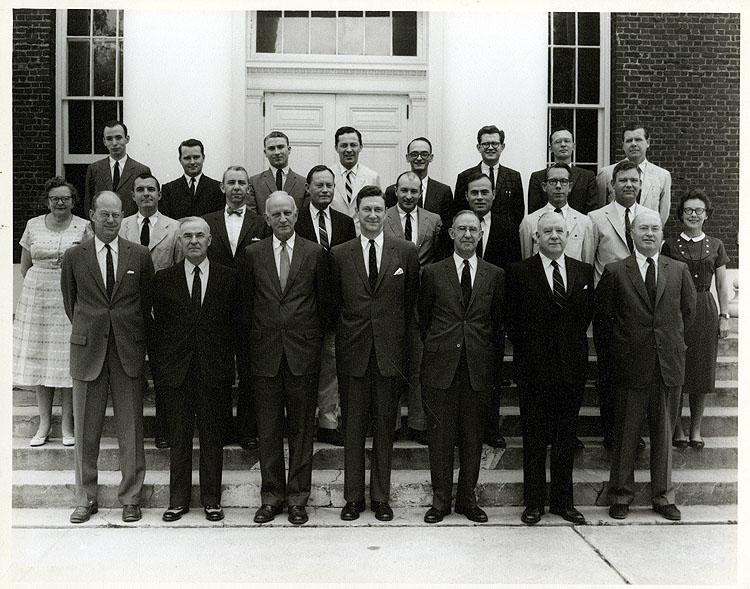
Below: the dust jacket of the first edition of Pylon (1935), with a representation of the pylon the pilots race around on its spine:
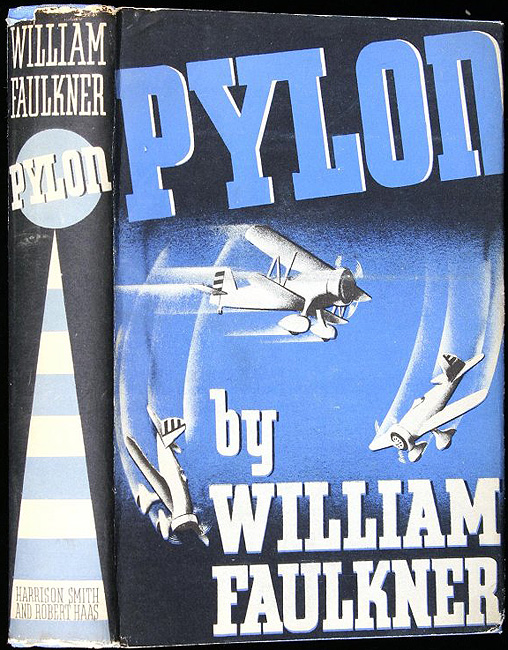
The Cavalier Daily 16 February 1957: 1
Faulkner Begins Stay As Writer-In-Residence
Author Gives Press Conference; Goal Is Helping Student Writers
By Andrew Ruckman, II
Author William Faulkner yesterday initiated his stay at the University as writer-in-residence with a morning press conference, during which newsmen fired a variety of questions at the Nobel and Pulitzer prize winner.
Faulkner, wearing a collegiate tweed suit, sat quietly while a battery of photographers took numerous pictures of him and the bristling mustache and pipe that are his trademarks. He then replied to queries about his opinions on topics ranging from writing to integration and international politics.
The author described his goal during his residence at the University as a desire to help students interested in creative writing "out of my experience as a writer, and to help create an atmosphere."
Speaks Informally
Faulkner, seated at a conference table in a crowded Cabell Hall classroom, spoke informally and without notes. In addition to his literary achievements, he serves the U.S. State Department in an advisory capacity.
He answered a question about the mid-Eastern situation by stating that "What we need now is not a golf player but a good poker player" in the White House.
The writer-in-residence categorized the "greatest" American novelists according to the unique standard of "the splendor of their failures to attain the dream which all first-rate writers hold."
High On Own List
In descending order of greatness, Faulkner listed Thomas Wolfe, himself, John Dos Passos, Erskine Caldwell, and Ernest Hemingway. He described the most important considerations in literary craftsmanship as "characters, ideas, and the plot."
At least two of Faulkner's works feature one character who attended the University of Virginia, but the author stated that most of the figures in his works are not actually persons of his acquaintance, but rather composites taken from "observation and impression."
No College Education
Faulkner spoke of himself as "not a literary man." In reply to a question about the value of a college education to a prospective writer, he said "No man can write who is not first a humanitarian. If he is such, college can be of infinite importance. But I don't think that college makes a writer." Faulkner also pointed out that he himself had not gone to college
He told reporters that he has "never written the one that suits me," and said that all "first rate" authors strive for a goal that is impossible for them to realize. Faulkner added, "I'm lazy . . . writing is work, but simply will not let me rest in peace. It worries me sometimes." He did feel that writers such as Cervantes, Shakespeare, and Homer had achieved the elusive goal.
A newsman asked Faulkner if he wrote "more easily" than he did when he was younger, and the author replied that "I fumble less now, but put (working) off more. I'm convinced that I'll live to be 100."
The Mississippi-born author, famed for his penetrating portrayals of the South, spoke at length on the current integration of schools. "The schools are poor, and should be improved to the standards of the best students, no matter what color," he said.
"The negro must earn the responsibility to be equal. There is more to a right than just the gift of it. We should not bother keeping the negro out, but should raise the standards and possibly keep some of the whites out," Faulkner added.
©1957 The Cavalier Daily
Faulkner and an Undergraduate
By Gerald L. Cooper (College ’58, M.Ed. Guidance ’69)
Upon graduation from Christchurch School in June 1953, I entered and quickly left Princeton University in September, disenchanted. I attended the College of William and Mary for three semesters happily, and then transferred to the University of Virginia in January 1955, to pursue a major in English. A year or so later I found myself in a small lecture hall, straining to hear a world-renowned writer-in-residence who spoke in an almost inaudible voice using an extraordinary accent. He described a mythical place with an Indian-sounding name: Yoknapatawpha. That reminded me of my own place of origin: the shores of the Rappahannock.
The speaker was William Faulkner, whom I had heard of from another native Mississippian, Robert M. Yarbrough Jr., instructor in senior English at Christchurch. Bob had introduced me to Faulkner’s novels The Sound and the Fury and As I Lay Dying outside of class.
Someone in the audience that day in 1957 at the University of Virginia asked Mr. Faulkner to give his view of promising young American writers. Violating his policy against endorsing writers, he replied that one of the best was from right here in Virginia: “His name is William Styron, and his book is titled Lie Down In Darkness.” Deciphering Faulkner’s low-pitched, Miss’sippi drawl with no amplification from my seat on the back row of the small auditorium in Rouss Hall, I realized he had spoken the name of a graduate of my old school – William Styron, known to his Christchurch classmates as “Sty.” I had attended the graduation of the Class of 1942 at Christchurch, to honor my friend and mentor, Jim Davenport, a member of that class, along with Styron and about fourteen others. By 1957 I had also read Lie Down In Darkness, Styron’s first book, that he published in 1951 and that won the Prix de Rome.
Several daily newspapers reported Faulkner’s public recognition of William Styron, including the Washington Post and the Richmond Times-Dispatch. Thereafter I found it more comfortable to mention around the Grounds that I was a graduate of Christchurch. Both the University’s English professors and my fellow students, some of whom were graduates of well-known prep schools like Woodberry Forest, Episcopal High, and Lawrenceville, suddenly sounded respectful of Christchurch, that unpretentious school with the million-dollar view on a bank overlooking the Rappahannock River.
I completed a bachelor’s degree in English at the University of Virginia in December 1957, a year after William Faulkner arrived as writer-in-residence. I had several opportunities to hear Mr. Faulkner discuss his writing between January and December of 1957. Although I was not among the favorites of the English department’s English majors, and therefore not invited to special gatherings with Mr. Faulkner, it was possible nonetheless to find “Old Bill” around the Grounds, occasionally at fraternities. I remember his quiet presence one evening in the Serpentine Club, at the back of the Quadrangle. (I knew the location of every fraternity because one of my part-time jobs was delivering beer kegs to the fraternities from Carroll’s Tea Room.)
In that setting Mr. Faulkner was less reticent than he was in small English seminars or honors classes. His painful shyness in one-to-one settings became well-known in New Cabell Hall, and not many students signed up for those uncomfortable meetings. Perhaps he was under-utilized, as some have suggested.
Even peripheral undergraduate students such as I were aware that factions within the English department – and perhaps among the entire University administration – were in disagreement over the value of Mr. Faulkner’s presence and usefulness on the Grounds. Former professor of English Joseph Blotner has captured much of the color, along with some of the political issues, of that era at the University in his autobiographical work, An Unexpected Life, published in 2005. The chapter titled “The University and Mr. Faulkner” might more accurately be titled “The Faulkner Era at the University of Virginia.”
Despite the politics and controversy, William Faulkner had a remarkable impact in the brief period of his presence in Charlottesville. His time on the Grounds is comparable to the presence of Edgar Allan Poe, who was enrolled for one academic year, beginning February 1, 1826, in just the University’s second session.
The University of Virginia’s first president, Edwin A. Alderman, wrote in 1925 a convincing essay on Edgar Allan Poe’s tenure as a student. He describes how Poe, despite a short stay and a less than exemplary lifestyle, had symbolized the presence of a “world poet” at the University. Alderman concludes that Poe “has contributed an irreducible total of good to the spirit which men breathe [at the University] as well as a wide fame to his alma mater that will outlive all disaster, or change, or ill-fortune.” Alderman defines the effect that a true artistic talent may have upon a community of scholars – even when that presence is brief and controversial.
Blotner and others have reported that President Colgate Darden was lukewarm to Faulkner’s writer-in-residence status because he questioned that the University needed the national attention that Faulkner’s visit would bring. But from my point of view, William Faulkner’s presence on the grounds had the effect of opening a window onto a larger world for UVA students in the late 1950s. It is difficult for students in the 21st century to imagine what a great gulf existed between the Grounds and the larger worlds of government, commerce and especially the arts, before the advent of mass communications. No national media coverage originated in Charlottesville, and even Washington, D.C. offered little or no live theatre, at least until the Kennedy Center opened in 1971. Thus to have a person of international stature in the world of letters – a Nobel laureate – walking the Grounds daily over a period of months and years demonstrated that the University of Virginia had not lost sight of the world-class ambitions of its founder.
I’ve had an enduring interest in the University of Virginia ever since I arrived on the Grounds some fifty-three years ago as a “transfer” from another college. Perhaps that’s why I view the University from a different perspective than does the typical alumnus of any era before the 1970s. I have devoted a chapter in my ebook to the University of today, titled “Leading to Diversity,” highlighting the changes that I see as having occurred under the leadership of President John T. Casteen III.
I am happy to observe that gone are the days of a stereotyped faculty and student body, and of a laissez faire attitude toward diverse students that I experienced when I attended in the 1950s. As Mr. Jefferson the Francophile might have said, Vive la difference!
Gerald L. Cooper divided his 43-year career as an administrator, counselor and teacher among four preparatory schools, two colleges, and finally as executive director of a college access program [501 (c) (3)] that served ten public high schools in Norfolk, Portsmouth, and Virginia Beach. This essay derives from his ebook, On Scholarship – From An Empty Room at Princeton, available in PDF format online at “http://www.talkeetna.com/OnScholarship/index.html” . In it he describes his personal experiences with financial aid: receiving it, granting it, fundraising for it, and finding it for needy students.
President Alderman’s remarks about Poe can be found in “Edgar Allan Poe and the University of Virginia” (The Virginia Quarterly Review, spring 1925), reprinted in We Write for Our Own Time: Selected Essays from the Virginia Quarterly Review (Charlottesville, 2000).
©2010 Gerald L. Cooper
Faulkner and an Undergraduate
By Gerald L. Cooper (College ’58, M.Ed. Guidance ’69)
Upon graduation from Christchurch School in June 1953, I entered and quickly left Princeton University in September, disenchanted. I attended the College of William and Mary for three semesters happily, and then transferred to the University of Virginia in January 1955, to pursue a major in English. A year or so later I found myself in a small lecture hall, straining to hear a world-renowned writer-in-residence who spoke in an almost inaudible voice using an extraordinary accent. He described a mythical place with an Indian-sounding name: Yoknapatawpha. That reminded me of my own place of origin: the shores of the Rappahannock.
The speaker was William Faulkner, whom I had heard of from another native Mississippian, Robert M. Yarbrough Jr., instructor in senior English at Christchurch. Bob had introduced me to Faulkner’s novels The Sound and the Fury and As I Lay Dying outside of class.
Someone in the audience that day in 1957 at the University of Virginia asked Mr. Faulkner to give his view of promising young American writers. Violating his policy against endorsing writers, he replied that one of the best was from right here in Virginia: “His name is William Styron, and his book is titled Lie Down In Darkness.” Deciphering Faulkner’s low-pitched, Miss’sippi drawl with no amplification from my seat on the back row of the small auditorium in Rouss Hall, I realized he had spoken the name of a graduate of my old school – William Styron, known to his Christchurch classmates as “Sty.” I had attended the graduation of the Class of 1942 at Christchurch, to honor my friend and mentor, Jim Davenport, a member of that class, along with Styron and about fourteen others. By 1957 I had also read Lie Down In Darkness, Styron’s first book, that he published in 1951 and that won the Prix de Rome.
Several daily newspapers reported Faulkner’s public recognition of William Styron, including the Washington Post and the Richmond Times-Dispatch. Thereafter I found it more comfortable to mention around the Grounds that I was a graduate of Christchurch. Both the University’s English professors and my fellow students, some of whom were graduates of well-known prep schools like Woodberry Forest, Episcopal High, and Lawrenceville, suddenly sounded respectful of Christchurch, that unpretentious school with the million-dollar view on a bank overlooking the Rappahannock River.
I completed a bachelor’s degree in English at the University of Virginia in December 1957, a year after William Faulkner arrived as writer-in-residence. I had several opportunities to hear Mr. Faulkner discuss his writing between January and December of 1957. I was not among the elect of the English department’s English majors, and therefore I was not invited to special gatherings with Mr. Faulkner. It was possible nonetheless to find “Old Bill” around the Grounds, occasionally at fraternities. I remember his quiet presence one evening in the Serpentine Club, at the back of the Quadrangle. (I knew the location of every fraternity because one of my part-time jobs was delivering beer kegs to the fraternities from Carroll’s Tea Room.)
In that setting Mr. Faulkner was less reticent than he was in small English seminars or honors classes. His painful shyness in one-to-one settings became well-known in New Cabell Hall, and not many students signed up for those uncomfortable meetings. Perhaps he was under-utilized, as some have suggested.
Even peripheral undergraduate students such as I were aware that factions within the English department – and perhaps among the entire University administration – were in disagreement over the value of Mr. Faulkner’s presence and usefulness on the Grounds. Former professor of English Joseph Blotner has captured much of the color, along with some of the political issues, of that era at the University in his autobiographical work, An Unexpected Life, published in 2005. The chapter titled “The University and Mr. Faulkner” might more accurately be titled “The Faulkner Era at the University of Virginia.”
Despite the politics and controversy, William Faulkner had a remarkable impact in the brief period of his presence in Charlottesville. His time on the Grounds is comparable to the presence of Edgar Allan Poe, who was enrolled for just one academic year, beginning February 1, 1826, in the second session at the University of Virginia.
The University of Virginia’s first president, Edwin A. Alderman, wrote in 1925 a convincing essay on Edgar Allan Poe’s brief time as a student at the University. He described how Poe, despite a short stay and a less than exemplary lifestyle, had symbolized the presence of a “world poet” at the University. Alderman concluded that Poe “has contributed an irreducible total of good to the spirit which men breathe [at the University] as well as a wide fame to his alma mater that will outlive all disaster, or change, or ill-fortune.” Alderman defined the effect that a true artistic talent may have upon a community of scholars – even when that presence is brief and controversial.
Mr. Faulkner’s arrival on the Grounds signaled the presence of another “world writer” equal in stature to Edgar Allan Poe and Thomas Jefferson, who had dominated the University of Virginia’s pantheon of genius for generations. Blotner and others reported that President Colgate Darden was lukewarm to Faulkner’s writer-in-residence status because he questioned that the University needed the national attention that Faulkner’s visit would bring.
I’ve had an enduring interest in the University of Virginia ever since I arrived on the Grounds some fifty-three years ago as a “transfer” from another college. Perhaps that’s why I view the University from a different perspective than does the typical alumnus of any era before the 1970s. I have devoted a chapter in my forthcoming book to the University of today, titled “Leading to Diversity,” highlighting the changes that I see as having occurred under the leadership of President John T. Casteen III.
I am happy to observe that gone are the days of a stereotyped faculty and student body, and of a laissez faire attitude toward diverse students that I experienced when I attended in the 1950s. As I see it today:
John Casteen as president has influenced the entire University of Virginia community to draw on the distinctive attributes of its past – including the genius of its founder, Thomas Jefferson – and also to make changes in its practices for the future, aiming to set standards for measurably higher achievement in the twenty-first century. In the twenty years that he has been president, Casteen has gathered a diverse group of persons to the University’s faculty, administration and student body, and he has nurtured them in their new environment. Apparently the Board of Visitors shares this commitment to diversity.
As Mr. Jefferson the Francophile might have said, Vive la difference!
Gerald L. Cooper divided his 43-year career as an administrator, counselor and teacher among four preparatory schools, two colleges, and finally as executive director of a college access program [501 (c) (3)] that served ten public high schools in Norfolk, Portsmouth, and Virginia Beach. This essay derives from his forthcoming book, On Scholarship – From An Empty Room at Princeton, about his personal experiences with financial aid: receiving it, granting it, fundraising for it, and finding it for needy students.
President Alderman’s remarks about Poe can be found in “Edgar Allan Poe and the University of Virginia” (The Virginia Quarterly Review, spring 1925), reprinted in We Write for Our Own Time: Selected Essays from the Virginia Quarterly Review (Charlottesville, 2000).
©2010 Gerald L. Cooper
The University in the Late Fifties
By Ken Ringle (College ’61)
To Be a Virginian, either by Birth, Marriage, Adoption, or even on one’s Mother’s side, is an Introduction to any State in the Union, a Passport to any Foreign Country, and a Benediction from Above. — “The Virginia Creed,” Anonymous
Elitism is a dirty word in academia today. At the University in the 1950s it was what we were all about. Not that our attitude was particularly justified. Though the law, medical, engineering and architecture schools were first rate, the College of Arts and Sciences was only so-so, many key professorships were held by stuffy old pedants living off past laurels and social ties. Academically the school wasn’t terribly demanding. Some students strung their years in Charlottesville out for nearly a decade.
Never mind. Wahoos defined themselves less by what they were, than by what they were not. We were not a “State U” – the dreaded apparition of proletarian banality occupied by VPI (nobody then called it Virginia Tech) and the V-necked, marching band megaversities of the Southeast and the Big 10.
We were smaller (the entire university, including graduate schools, was only about 6,500 students when I entered in 1957), we were older (1819), and we had both Thomas Jefferson and his architecture. Though we did most of the same stupid things college students have always done and do today, we considered ourselves more sophisticated and more adult. We had an honor code. We wore coats and ties to class. And we had fewer rules: almost the only one was that we were to “conduct ourselves at all times as gentlemen.” We could drink anywhere, even in class. Needless to say the student body was all male, but then so were Harvard, Yale, Princeton and most of the Ivy League colleges. We considered ourselves one of them, at least socially. The student government, fraternities and honor societies were dominated by graduates of Virginia boarding schools like Episcopal High, St. Christophers and Woodberry Forest, but New England schools like Choate and Kent were represented, too. I remember two of my classmates from New England telling me separately that their parents had sent them to Virginia because they had failed to get into Harvard and U.Va. was “the only other socially acceptable school.” What other state university had a polo team?
The late CBS correspondent Charles Kuralt once wrote me a letter at the time describing a U.Va. diploma as “not only scholarly but patrician” – a distinction, he said, “that has always escaped Chapel Hill where I went to school.”
Part of this sense of exclusivity grew out of the self-satisfaction embodied in the only partly tongue-in-cheek Virginia Creed quoted above. In those days many Virginians, particularly old family Richmonders, took it seriously. I remember one of my classmates – otherwise quite a sane and genial fellow – telling me that whenever his family visited Europe and were asked if they were Americans, they replied “No, we’re Virginians.”
Yet if the University was unchallenged as the principal college in the Old Dominion (bumper stickers said simply “THE University”), nearly one-third of the students came, as I did, from out-of-state. This was less to leaven any sense of provincialism in the student body than to help pay the freight. The General Assembly was famously parsimonious in funding education, and out-of-state students paid twice the tuition of in-staters.
Obviously the Commonwealth then was very different. The Washington suburbs which so dominate it today were almost invisible at the University in the 1950s. The Old Dominion was still largely a state of rural counties and small towns. Most of the students, whether in-state or imported, had some sort of tie to the land.
One index of that demographic difference was the firearm. A great many Virginia students in the 1950s – maybe even most – owned firearms and kept them in their rooms. Most of these were shotguns or rifles used for hunting – I had two fraternity brothers who regularly went quail hunting after classes in the fall and I remember seeing a deer carcass hanging by its heels from the porch of the Sigma Pi house – but there were plenty of pistols around as well. These last were used for target shooting, beer can plinking and general hilarity. We still had a few World War II and Korean War veterans in the student body who would pack their service .45s on road trips and regularly shoot out the gate lights at Sweet Briar. A fraternity brother of mine from Savannah, “Crazy Harry” Strahan, disturbed one night by the glare from the light in the showers of the D.U. House next door, pulled out the .357 magnum he kept in his bedside table and shot out the offending bulb. When Dean B.F.D. Runk learned of that the following morning, Harry was instantly expelled from the University. Even such impressive marksmanship was NOT deemed “gentlemanly behavior.” But no rule was enacted to restrict firearms. Because, as amazing as it seems today – after horrors like Columbine and Virginia Tech – I never remember hearing of a single case, before, during or after my years at Virginia – not a single one! – when any student gun was employed – or even displayed – as a weapon. There were the usual number of drunken brawls then as there doubtless are now on party weekends. But using a gun to settle one would never have occurred to anyone. It would have been considered cowardly and unmanly. It was just unthinkable.
Another major difference between the University in the ’50s and the University of today was political. However lethargic today’s students may appear, they are bombarded constantly with news updates and media messages from TV, computers, cell phones, PDAs and the like, none of which, of course, we had. And aside from the usual tiny minority of campus Democrats and Republicans (most of them political science majors and/or budding lawyers), we didn’t have a political clue. We were scarcely a decade from the victory in World War II, Eisenhower, who had led that victory, was president and we were largely content to let him and the other leaders elected by our parents make all governmental decisions without input from us. A few impatient faculty members chided us for such apathy and compared us unfavorably to students in Latin America and Europe who always seemed to be rioting for some cause. But at the University – and in most other American colleges in that era – we were largely unconcerned with politics and public affairs.
That this was true at Virginia seems particularly bizarre now, since the state was then roiling with debate over school desegregation. The U.S. Supreme Court’s Brown vs. Board decision had been handed down in 1954, and in 1956 U.S. Sen Harry F. Byrd, whose political machine dominated Virginia, called for “Massive Resistance” to the decision by closing any public school ordered to integrate. One of the first such locality was Charlottesville. But University students were largely oblivious to the political turmoil.
Most of us had been raised with racial segregation and were at least passively in favor of the system. Though few would have denied its legal injustice, its effects appeared largely benign to our socially myopic adolescent eyes. Almost all of us had grown up with blacks, but few of us had ever known any who weren’t servants or laborers or had any education at all. It wasn’t so much that we wanted to continue segregation: we just couldn’t imagine how society would function without it. It was all we’d known. Furthermore, the blacks we saw every day in Charlottesville seemed to accept it without complaint. I had an aunt in Mississippi where I had witnessed casual brutality and a bitter kind of racial hatred that I found as scary as it was repellent. But nothing like that was visible in Charlottesville or, for that matter, in the part of Louisiana where I’d grown up. Racism at the University manifested itself largely in Step’n Fetchit jokes and racial stereotyping. Plus tiresome Confederate flag-wavng at football games when the pep band at least once a half played “Dixie.” The cheering at this was largely pro forma.
Yet the University also was edging very, very quietly toward racial change. Though it was technically supposed to be segregated, we had a half-dozen black students enrolled, most, as I remember, in the professional schools. I don’t think they lived in the dormitories – I don’t remember where they lived – but they ate in the dining halls with us and otherwise moved around the grounds without apparent incident. One faculty wife, Sarah Patton Boyle, wrote about this approvingly for “The Saturday Evening Post” and received some subsequent threats, though not from any students. Her recently republished memoir – “The Desegregated Heart” paints a revealing portrait of this time of racial transition.
Boyle’s writing, together with Faulkner’s, finally helped awaken in me a shamefully-delayed understanding of segregation’s crippling effects. John F. Kennedy’s election as president in 1960 led me and others as well to a political awakening after which the University was never again quite the monument to apathy it had been for most of the 1950s. But when Ed Lovern of Lynchburg and I attempted in 1961 to charter a University chapter of the Virginia Council on Human Relations – an early but hardly revolutionary civil rights group – the student council turned us down and I was accused of Communist sympathies by a fraternity brother from Farmville. It would take the students of the 1960s to make the real difference.
The final and most obvious difference between the University of Faulkner’s day and today’s involved women. Essentially, we had none. Aside from a sprinkling of would-be schoolteachers in the education school, almost the only women on the Grounds were the student nurses who lived in McKim Hall. These were convenient but tended toward understandable resentment when dated only during the week and left behind on party weekends. In general, one had to go Down The Road.
Freshmen girls were bused in occasionally for “mixers” from women’s schools like Sweet Briar (62 miles away), Randolph-Macon Woman’s College (74) and Mary Washington (78) and road trips to these schools were a regular feature both during the week and on weekends. Hollins girls were considered highly desireable but, at 110 miles distant, required a more serious time commitment, particularly during the week. Longwood and Radford girls were visited as merry sports, but not always girls you would bring home to mother.
And that, in some weird way, seemed to be important. In the preppier-than-thou culture in which we operated, most dating was considered at least a quasi-courtship, particularly by the women involved, most of whom were far more interested – it was a sign of the times – in getting married than considering a career. And of course, since the birth control Pill was at least five years in the future, most girls made a fairly serious effort at staying virgin, and an even more serious effort at appearing one.
All the girls colleges had curfews – usually midnight, no boys on dorm – and surreal combinations of rules governing “ladylike” behavior. Randolph-Macon girls were forbidden to drink within 20 miles of the campus. Radford girls were forbidden to wear slacks, etc. Since Virginia in those days prohibited liquor-by-the-drink, the frequent date of choice was “boon docking” with a blanket and a fifth of bourbon at some woodsy place like Amherst Wayside or dancing to a jukebox at some filling station/beer hall like Brants near Lynchburg. If you think that sounds contradictory, you’d be right.
When invited for party weekends at the University, it was understood that girls would pay their own way to and from Charlottesville by bus, train or car as well as paying for their lodging at one of the chaperoned guest houses in town approved by their individual school. Motels were a no-no. Their date would meet all other costs of the weekend. Attire for the weekend was taken VERY seriously by the women, with the usual goal being to look enough like wife material so they COULD be taken home to mother. Such garments were considered so important in Virginia in those days that many big city deparment stores employed student advisorettes – “college boards” – to counsel girls heading off to college on the virtual trousseau of skirts, sweaters, blouses, dresses, overcoats, shoes and boots they would need for the anticipated social whirl accompanying their higher education. The de rigeur female uniform for informal dates consisted of a white blouse with a McMullen collar beneath a crew neck sweater, combined with a plaid kilt held together at the knee by a giant safety pin, knee socks and Weejun loafers. All set off by a circle pin and a scarab bracelet. And maybe a headband. This was a virtual uniform, particularly for Sweet Briar and Hollins girls. Wahoo garb was no less predictable – tweed sport coat, khakis, Oxford cloth button down shirt, rep tie and Weejuns.
As might be expected, the University’s social life involved a lot of drinking. In fact, alcohol and U. Va. have been intertwined since Edgar Allan Poe boozed his way out of the school in 1826. In the 1950s we drank bourbon over ice in the stands at football games, Scotch and soda while bopping to blues bands in sweaty, smoke-filled fraternity houses, gin and juice and bloody marys at Sunday polo games and we drank occasional wine and lots of beer with meals. We also drank an alarming amount while driving hundreds of miles to and from women’s colleges on winding, hilly two-lane roads, and why no student died in a car accident during my four years, God only knows. But one reason may have been that the culture governing drinking then was patently different than that governing it today. Not that students were always moderate in their consumption, far from it. There were always some students intent on wrecking themselves, throwing up, passing out, being obnoxious. It was a rite of passage then as it is today.
But the social ideal in those days was to be “able to hold your liquor” – to be genial and colorful and amusing, but still keep a rein on your self-control. For men it was a sign of machismo. For women it was both a sign of femininity and means of self-defense. Not everybody met the ideal. Women were generally better at it than men, in part because a woman reported to have been drunk and out-of-control would usually be put on “social probation” by her school and restricted to campus or even suspended. But the self-knowledge both acquired in the liquor-washed University of the 1950s had to do with learning one’s capacity and taking responsibility for oneself. That was the real elitism we cultivated on the grounds in those days. Whether that same ethos reigns today in Charlottesville, only those there can say.
©2009 Ken Ringle
Ken Ringle retired in 2003 after 33 years as a writer, editor, essayist and critic for The Washington Post. His work has also appeared in The National Geographic, Smithsonian, European Affairs and other publications, and he has been a writer-in-residence himself as a Washington Post Fellow at Duke University.
Below: The south Lawn between classes, from Corks & Curls, the UVA yearbook (1957 edition, vol. 69, pp. 16-17).
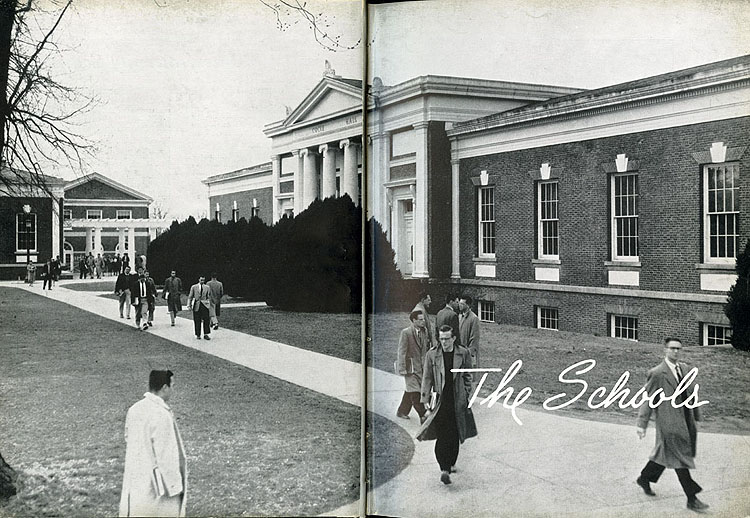
Below: Science class, from "Classes" titlepage, Corks & Curls, the UVA yearbook (1957 edition, vol. 69).

Below: Students walking from dorms to class, from Corks & Curls, the UVA yearbook (1957 edition, vol. 69, pp. 68).

Below: Delta Kappa Epsilon fraternity, from Corks & Curls, the UVA yearbook (1957 edition, vol. 69, p. 85).

Below: The one full page in the 1957 UVA Yearbook, Corks & Curls, devoted to the organizations for women students — there were 24 pages of men's fraternities (1957 edition, vol. 69, pp. 142-43).
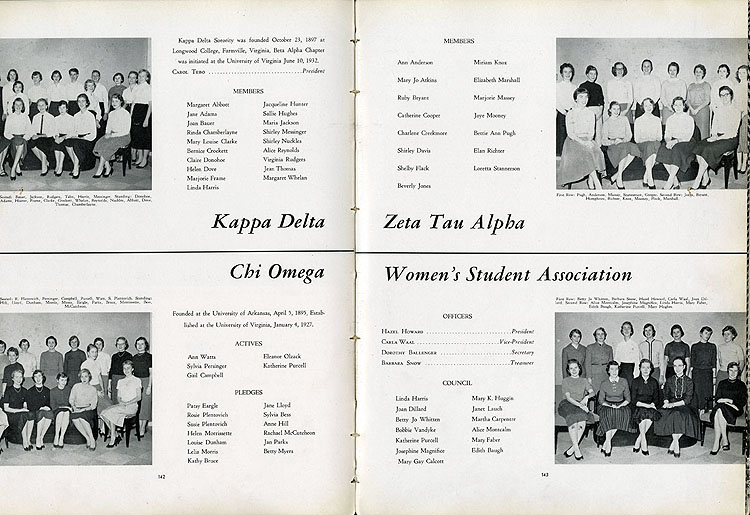
Below: Page from the "Features" section of Corks & Curls, the UVA yearbook, highlighting memorable moments from Easters weekend, at which Duke Ellington and his band were the featured musicians (1957 edition, vol. 69).

Below: Page from the "Features" section of Corks & Curls, the UVA yearbook, highlighting memorable moments from home football game days (1957 edition, vol. 69).
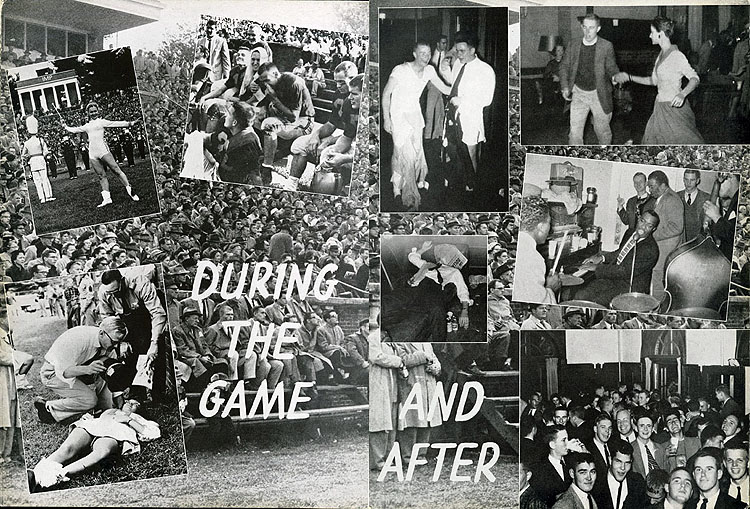
Below: Page from the "Features" section of Corks & Curls, the UVA yearbook, featuring highlights from Openings weekend (1957 edition, vol. 69).
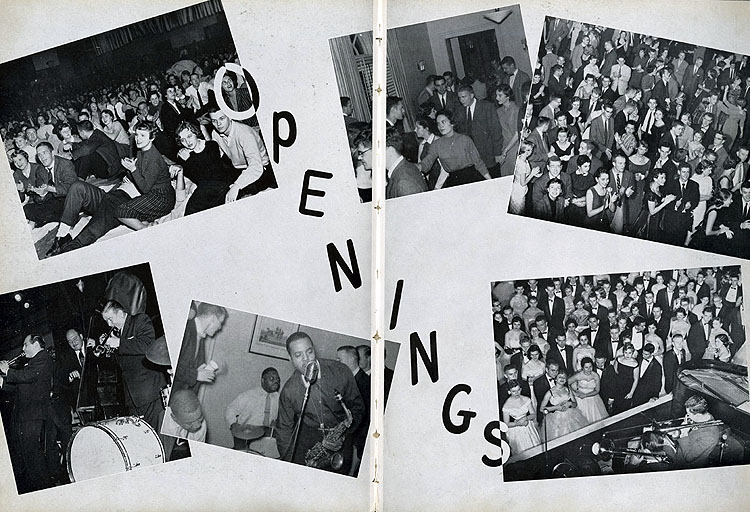
Below: Page from the "Features" section of Corks & Curls, the UVA yearbook, featuring representative scenes of student social life (1957 edition, vol. 69).
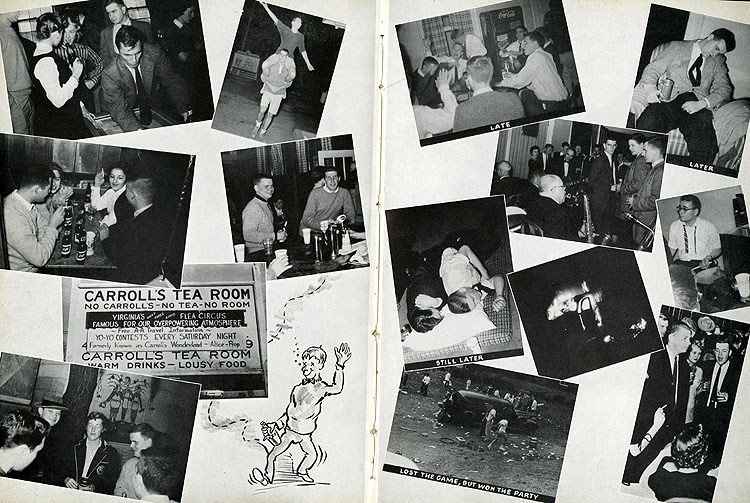
Below: Page from the "Features" section of Corks & Curls, the UVA yearbook, highlighting memorable moments from Midwinters weekend, at which Louis Armstrong (popularly nicknamed "Sachmo") was the featured musician (1957 edition, vol. 69).

Below: Page from the "Features" section of Corks & Curls, the UVA yearbook. The left page features highlights from this year's Beaux Arts ball; the right, other images from the academic year, including two (far right) that star Faulkner (1957 edition, vol. 69).
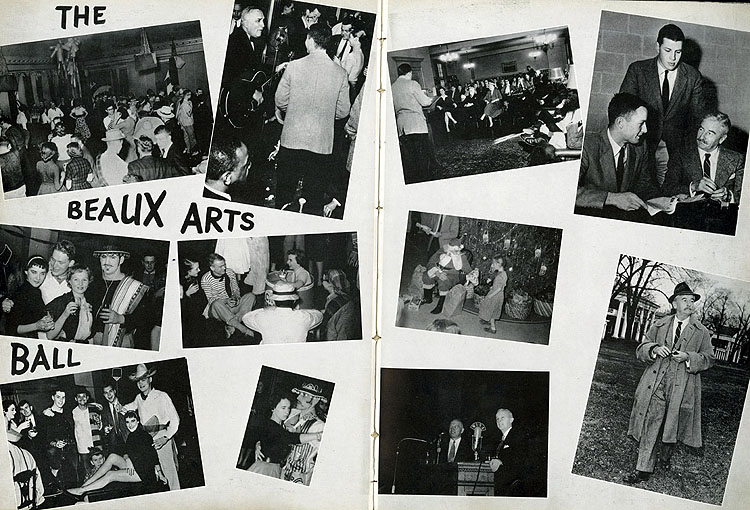
Below: Page from the "Features" section of Corks & Curls, the UVA yearbook, featuring highlights of Easters weekend, at which Lionel Hampton was the star performer (1958 edition, vol. 70).
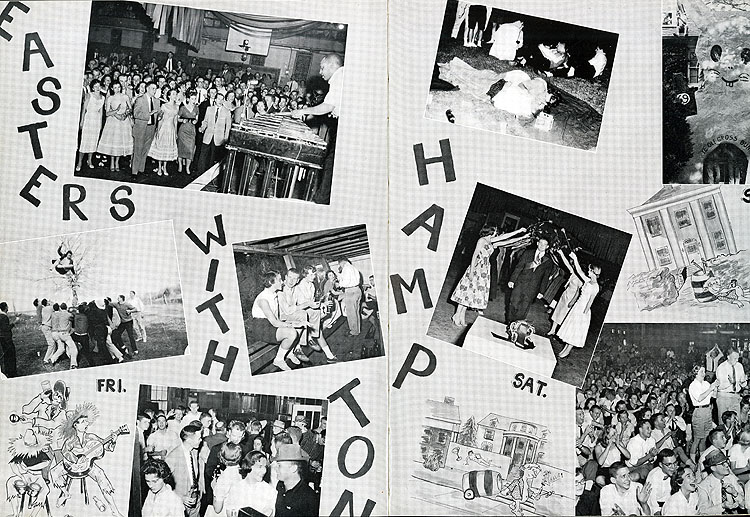
Below: Page from the "Features" section of Corks & Curls, the UVA yearbook, featuring highlights from home football game weekends (1958 edition, vol. 70).

Below: Page from the "Features" section of Corks & Curls, the UVA yearbook. The left page features highlights from this year's Beaux Arts ball. The theme for this year – "Back to the Jungle" – allowed at least several of the students to wear blackface. On the right, other scenes from student life throughout the year (1958 edition, vol. 70).
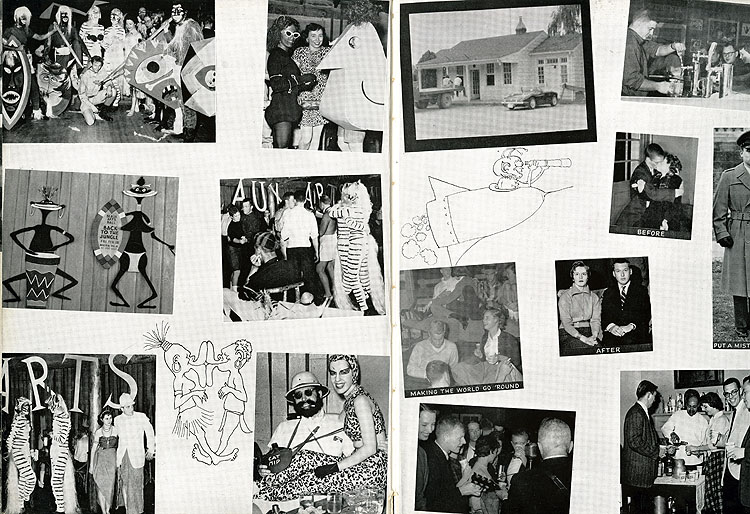
Below: Title page from the "Organizations" section of Corks & Curls, the UVA yearbook (1958 edition, vol. 70).
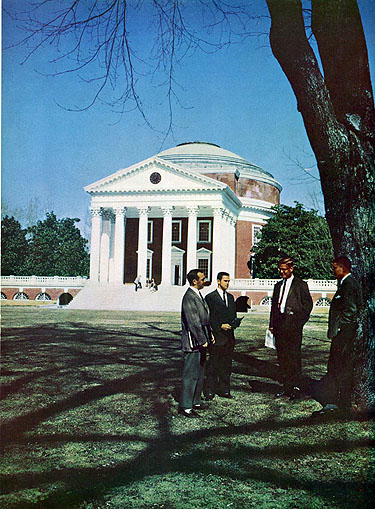
Below: Page from the "Organizations" section of Corks & Curls, the UVA yearbook, featuring the Jefferson Society – one of the groups that officially sponsored Faulkner's February "Word to Virginia" about integration (1958 edition, vol. 70).

Below: Page from Corks & Curls, the UVA yearbook, featuring the previous year's track team. In the photo at the upper right Dave Bloor, one of the stars of the team, "breaks the tape"; Joseph Blotner watches while Faulkner, a fixture at track events that spring, times the race (1959 edition, vol. 71).
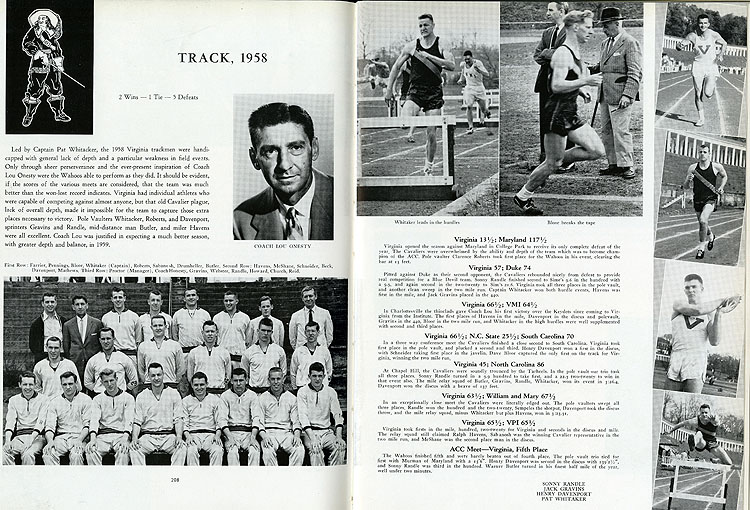
Below: "Registration and Orientation at Memorial Gymnasium," Ralph Thompson photo from UVA Prints Collection [Image Filename: prints01717; undated, but late 1950s]. Caption on back: "Students line up for courses at registration."

Below: Students between classes, Ralph Thompson photo from UVA Prints Collection [Image Filename: prints01421; undated, but late 1950s]. Caption on back: "Minor Hall, music and drama building in the background, and the McIntire Amphitheatre, used for outdoor gatherings."
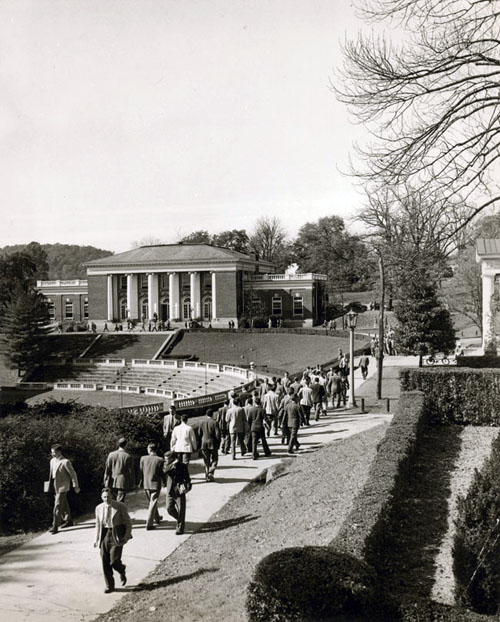
Below: Virginia Players scene from "Rollo's Wild Oat," photo by unidentified photographer from UVA Prints Collection [Image Filename: prints02038; 1956]. Caption on back: "The last players production with an all-male cast."
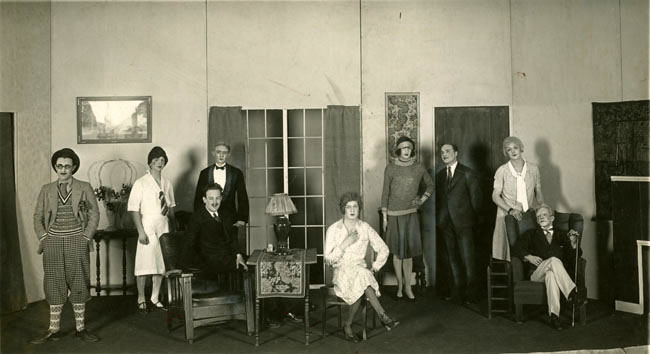
Below: "University of Virginia football game," photo by James Netherwood, Jr. from UVA Prints Collection [Image Filename: prints00759; 1956]. Caption on back: "Rooting Section — The University of Virginia's football captain, Jim Bakhtiar, had a personal rooting section in the stands at Scott Stadium, Charlottesville, on Saturday during the Cavaliers' meeting with the alumni squad. Jim's mother, Mrs. James Bakhtiar, of Washington, and his three sisters all were on hand to see him score twice and lead the Varsity to a 20-0 victory. From the left: Mrs. Bakhtiar, Mrs. Bryce Blair, Miss Mary Nell Bakhtiar and Mrs. Fred McNair, all of Washington."
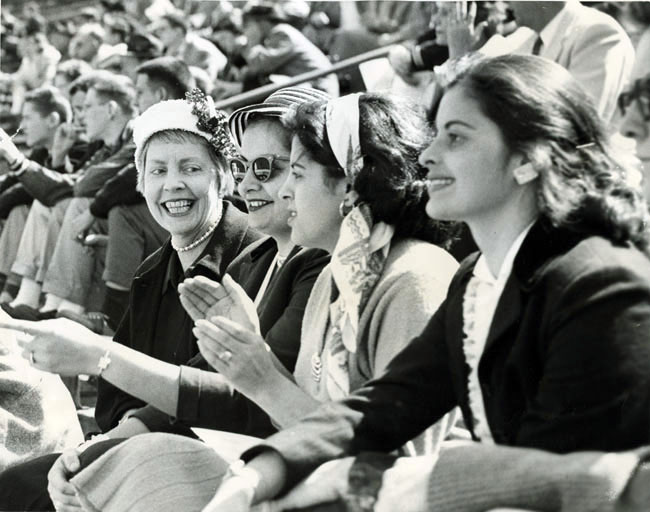
Below: "Midwinters 1955," photo by Ralph Thompson from UVA Prints Collection [Image Filename: prints08130; 1955]. Caption on back: "Tommy Dorsey orchestra in Memorial Gymnasium."

Below: "Dances and parties," photo by Ralph Thompson from UVA Prints Collection [Image Filename: prints08131; undated, but late 1950s]. Caption on back: "This is an informal student party held by a Law School fraternity. The parties were in a Quonset hut built on the Washington Road a few miles north of Charlottesville."
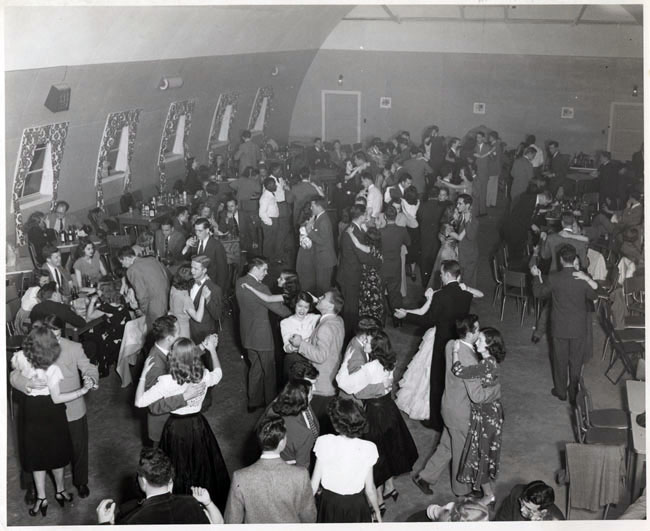
Below: Cover from the "Jim Crow Issue" of the Virginia Spectator monthly magazine (May 1957; vol. 118, no. 8).

Below: Sarah Patton Boyle's article from the "Jim Crow Issue" of the Virginia Spectator monthly magazine (May 1957; vol. 118, no. 8, p. 18).
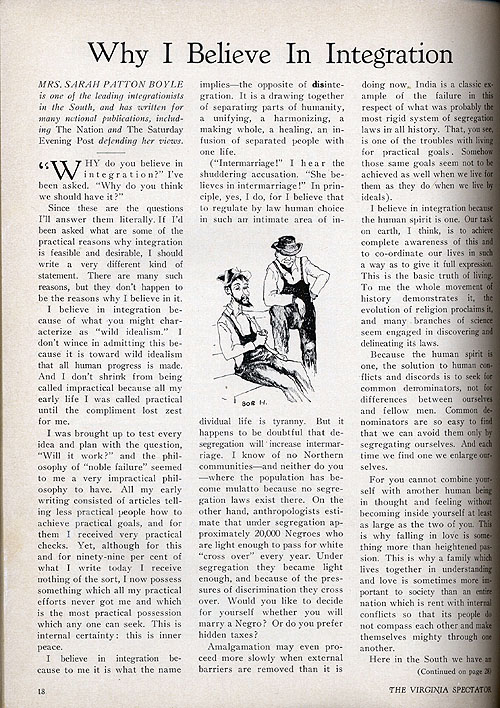
Below: Edwin B. Henderson's article from the "Jim Crow Issue" of the Virginia Spectator monthly magazine (May 1957; vol. 118, no. 8, p. 19).
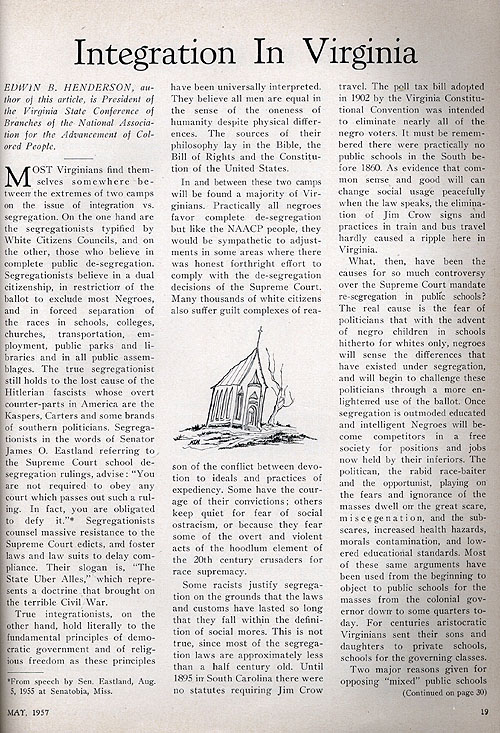
Below: William Faulkner's article from the "Jim Crow Issue" of the Virginia Spectator monthly magazine (May 1957; vol. 118, no. 8, p. 20).
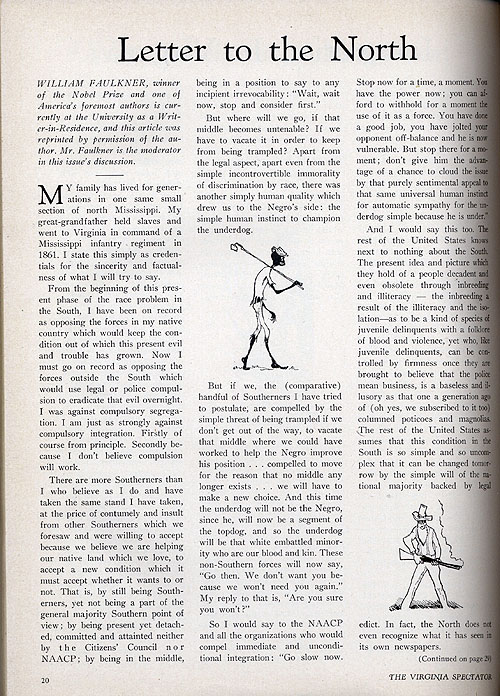
Below: John Kasper's article from the "Jim Crow Issue" of the Virginia Spectator monthly magazine (May 1957; vol. 118, no. 8, p. 21).

Below: Floyd Fleming's article from the "Jim Crow Issue" of the Virginia Spectator monthly magazine (May 1957; vol. 118, no. 8, p. 22).

The Virginia Spectator Jim Crow Issue (May 1957, vol. 118, no. 8, pp. 2-4)
Up And Down From Slavery
By Pablo & Carlos
DUE to the increasing interest in the inter-racial problem in the South today, we of the SPECTATOR have taken it upon ourselves to scientifically ascertain the position held by the great unwashed in regard to this matter. The first victims of our interrogation were several of the elite social organizations of Mad Bowl and Carr's Hill.
When the question of, "What do you think of integration?" was first posed to the St. Elmos they pleaded that old Fifth Amendment. Furthermore, we were told that the SPECTATOR was overstepping its limits by meddling with matters outside its jurisdiction. Now we do not wish to infer anything, but could it be the St. Elmos practice underground integration?
The St. A. House was next our list, and they were a bit more co-operative. After informing us that charter laws were classified, the "Spooks" told us that they would pledge a negro only if they could bump the Phi Kaps; [Footnote: By the way, the Phi Kap comment was, "How bourgeois can those Spooks in the Hall get?"] but, they were afraid he might refuse the bid. We then asked them what they would think of starting a colored fraternity. Following a few moments of silent meditation they replied, "It would be colorful as hell." (And so it would.)
Next, we put the question to the Phi Psi's, asking them if they would allow a colored person in their modest edifice. To this they replied, "Oh yes, we need a boy, and would gladly put an advertisement in the SPECTATOR for such." "No," we replied, "you have the wrong idea. We mean take on a negro pledge." "Like we said before, we need a boy."
Last on the list came the ATO's, the Phi Delt's and the DKE's. It seems that ATO has a charter by-law which states that one pledging ATO must be a white male Christian. The Phi Delts have a by-law that reads, "Every pledge must be a person acceptable to all the other chapters," . . . if you don't believe us just ask the boys at Amherst. On the other hand, DKE has no by-laws in their national, and they told us, "If he's a good jock, then why the hell not?"
Despairing from the sophistication of "Boozers' Alley," we decided to question some of the leading (or otherwise) individuals who either sweat for or inhabit the "U." First on this list of distinguished gentlemen was the director of admissions, Dr. R. C. Bice. Naturally, we thought he would have a good deal to say regarding the admission of a colored boy to the College of Arts and Science. However he only squelched us, for as long as he can remember, never has a negro applied. Of course there are some negroes in engineering, but then, there is a lot else in engineering as well. Further questioning of Dr. Bice only led to a discussion concerning the consumption of liquor . . . did you know negroes can drink more? Only, they go more for quantity rather than quality. We think it was very clever of Dr. Bice, the way he avoided our interrogation; being a Phd. in psychology sure payed off.
Col. Tash of the Air Force R. O. T. C. unit was our next victim. It seems as though the A. F. R. O. T. C. is responsible to two bosses, WASHINGTON and Dean Runk. Neither, as of yet, has placed any restriction on race or religion, hence there are four colored cadets in the Air Force.
In asking several of the colored people around the grounds what they thought of the situation, we received varied answers. One said, "We is happy the way we is." Another favored integration, but he stated that "Time, and only time, will solve the problem."
Another student, whose name we shall not reveal, took the point of view of State – total segregation.
"After all, it is a State's right to have segregation just as much as it is a State's right to set the laws regarding divorce, liquor and automobiles. Damn Sam, if the federal government is going to be despotic, why don't they take over everything and save the states the expense of running their so-called privileges. At the rate things are going, it probably won't be long before State's rights cease to exist. And as for those who don't like the South, then damnit all, let them move – I can't see that we are paying them to stay here and bitch about our methods."
Well good people, we of the SPECTATOR just like to thank all of you who were involved in our research for your co-operation. Think, Gentlemen, think. Never shirk the great privilege endowed unto us by our forefathers. Amen.
©1957 The University of Virginia
The Virginia Spectator Jim Crow Issue (May 1957, vol. 118, no. 8, p. 17)
Keynote
By J[ames].C.P[lowden]-W[ardlaw, Editor-in-Chief]
In this issue we have collected the viewpoints of persons on both sides of the segregation question which we felt would be of interest, and perhaps benefit, to our readers. Although most of our authors here presented are nationally known, we do not necessarily presume to call them spokesmen for their particular side of the argument. Rather they were chosen because we felt each one represented a particular aspect of either segregationist or integrationist thought. If some points of view are missing, it is because many of the authors whom we solicited for articles refused, for reasons best known to themselves, to contribute to a magazine dealing with this important problem. Nevertheless, we sincerely feel that the articles here presented will be of definite interest to every reader.
The SPECTATOR itself offers neither advice nor solutions to the problem. We are, and most assuredly intend to remain, completely neutral, favoring neither one side nor the other. Nor are we attempting to set ourselves up as the voice of the students of the University of Virginia. Rather we are presenting the opinions of people who are taking an active part in the momentous struggle which faces the people of the South while we ourselves play the role of court jester, spoofing both integrationists and segregationists alike.
It is our aim to supply our readers, especially our own generation, with opinions which they may find useful, if only as negative psychology, in helping them make the important decisions which we feel lie ahead. We have not tried to resolve the problem, for that is not our function, but we have done our best to cast the torch into the cave.
The Virginia Spectator Jim Crow Issue (May 1957, vol. 118, no. 8, pp. 18, 28)
Why I Believe in Integration
By Sarah Patton Boyle
MRS. SARAH PATTON BOYLE is one of the leading integrationists in the South, and has written for many national publications, including The Nation and The Saturday Evening Post defending her views.
"Why do you believe in integration?" I've been asked. "Why do you think we should have it?"
Since these are the questions I'll answer them literally. If I'd been asked what are some of the practical reasons why integration is feasible and desirable, I should write a very different kind of statement. There are many such reasons, but they don't happen to be the reasons why I believe in it.
I believe in integration because of what you might characterize as "wild idealism." I don't wince in admitting this because it is toward wild idealism that all human progress is made. And I don't shrink from being called impractical because all my early life I was called practical until the compliment lost zest for me.
I was brought up to test every idea and plan with the question, "Will it work?" and the philosophy of "noble failure" seemed to me a very impractical philosophy to have. All my early writing consisted of articles telling less practical people how to achieve practical goals, and for them I received very practical checks. Yet, although for this and for ninety-nine percent of what I write today I receive nothing of the sort, I now possess something which all my practical efforts never got me and which is the most practical possession which any one can seek. This is internal certainty: this is inner peace.
I believe in integration because to me it is what the name applies – the opposite of disintegration. It is a drawing together of separating parts of humanity, a unifying, a harmonizing, a making whole, a healing, an infusion of separated people with one life.
("Intermarriage!" I hear the shuddering accusation. "She believes in intermarriage!" In principle, yes, I do, for I believe that to regulate by law human choice in such an intimate area of individual life is tyranny. But it happens to be doubtful that desegregation will increase intermarriage. I know of no Northern communities – and neither do you – where the population has become mulatto because no segregation laws exist there. On the other hand, anthropologists estimate that under segregation approximately 20,000 Negroes who are light enough to pass for white "cross over" every year. Under segregation they became light enough, and because of the pressures of discrimination they cross over. Would you like to decide for yourself whether you will marry a Negro? Or do you prefer hidden taxes?
Amalgamation may even proceed more slowly when external barriers are removed than it is doing now. India is a classic example of the failure in this respect of what was probably the most rigid system of segregation laws in all history. That, you see, is one of the troubles with living for practical goals. Somehow those same goals seem not to be achieved as well when we live for them as they do when we live by ideals.)
I believe in integration because the human spirit is one. Our task on earth, I think, is to achieve complete awareness of this and to co-ordinate our lives in such a way as to give it full expression. This is the basic truth of living. To me the whole movement of history demonstrates it, the evolution of religion proclaims it, and many branches of science seem engaged in discovering and delineating its laws.
Because the human spirit is one, the solution to human conflicts and discords is to seek for common denominators, not for differences between ourselves and fellow men. Common denominators are so easy to find that we can avoid them only by segregating ourselves. And each time we find one we enlarge ourselves.
For you cannot combine yourself with another human being in thought and feeling without becoming inside yourself at least as large as the two of you. This is why falling in love is something more than heightened passion. This is why a family which lives together in understanding and love is sometimes more important to society than an entire nation which is rent with internal conflicts so that its people do not compass each other and make themselves mighty through one another.
Here in the South we have an opportunity for greatness. In other parts of the nation this is true, too, but here in the South the opportunity is hammering at our door. It should be easy for us to open it, for deep within most Southerners, colored and white, there is a yearning toward this greatness. Indeed I think that some of the violence of segregationists arises from a conflict between this yearning and the harsh fear that its satisfaction would bring impractical results. We who have looked since babyhood into the eyes of our colored neighbors know that we are one in spirit with them. You cannot look again and again into the eyes of another human being without discerning this, no matter how often current custom tells you to think of his clothes, his behavior, his language.
We know we are one in spirit with our colored neighbors. And somewhere inside us is the knowledge that this is a great truth which motivates human progress. We know that clothes, behavior, language change from generation to generation – even from decade to decade. But the oneness of the human spirit goes on from age to age.
Some of our colored neighbors – though by no means all – are different from us in other ways than skin color. But is the difference in dress greater than that between the sweeping elegant apparel of our grandmothers and the incredible dungarees and pin curls of our teen-age sirens? And isn't the same thing true of behavior and language? How our conduct and language grates on the ears and hearts of our near ancestors! Such things change too easily for there to be either security or cause for fear in likenesses and differences such as these. Their roots are too shallow.
Indeed, the roots of all differences are shallow. The differences between human beings are like particles of the earth blasted upward in an explosion. Scattered, separated, the spaces between them widen for a time. But soon all curve over and return to one world.
Don't imagine that I have not known the exhilaration of such explosion. How momentarily good it is to feel completely apart; to feel, "I, I, I, – there's no one else like me. And, oh, God, How I thank thee that I'm not as other men!" Yet I was not sorry when I felt the pull of gravity and the curve in my flight – when I felt my ego going down, down, down until I was a part of the earth from which I came.
All at once I was glad – because I wanted to be glad, and not sorry in the inevitable. It was then that I learned that to be glad in the earth is to be found in it, not lost in it. I knew that to be a rebellious part of a whole is to be imprisoned within it, but to be a joyous part of a whole is to include that whole within oneself.
In understanding, in empathy, in love lie the total freedom of the human spirit. For that which we love, that which we compass in empathy, that which we understand is an extension of ourselves, a true part of our being. Let's not be afraid to experience these things in every direction we look, for through them there is no evil which is not redeemed.
I think we should have integration because it is the next rung up the ladder of man's liberation from captivity within his tiny self. It is the next rung up toward the highest that we can conceive in our image of what man might be. It is a good and sturdy rung to clutch in our rather slow climb toward the day when every man is great because – through understanding, empathy and love – he contains the whole being of every other man within himself, and there is no door he cannot enter and no vista he cannot see.
©1957 The University of Virginia
The Virginia Spectator Jim Crow Issue (May 1957, vol. 118, no. 8, pp. 19, 30-33)
Integration in Virginia
By Edwin B. Henderson
EDWIN B. HENDERSON, author of this article, is President of the Virginia State Conference of Branches of the National Association for the Advancement of Colored People.
Most Virginians find themselves somewhere between the extremes of two camps on the issue of integration vs. segregation. On the one hand are the segregationists typified by White Citizens Councils, and on the other, those who believe in complete public desegregation. Segregationists believe in a dual citizenship, in restriction of the ballot to exclude most Negroes, and in forced separation of the races in schools, colleges, churches, transportation, employment, public parks and libraries and in all public assemblages. The true segregationist still holds to the lost cause of the Hitlerian fascists whose overt counter-parts in America are the Kaspers, Carters and some brands of southern politicians. Segregationists in the words of Senator James O. Eastland referring to the Supreme Court school desegregation rulings, advise: "You are not required to obey any court which passes out such a ruling. In fact, you are obliged to defy it."* [footnote: From speech by Sen. Eastland, Aug. 5, 1955 at Senatobia, Miss.] Segregationists counsel massive resistance to the Supreme Court edicts, and foster laws and law suits to delay compliance. Their slogan is, "The State Uber Alles," which represents a doctrine that brought on the terrible Civil War.
True integrationists, on the other hand, hold literally to the fundamental principles of democratic government and of religious freedom as those principles have been universally interpreted. They believe all men are equal in the sense of the oneness of humanity despite physical differences. The sources of their philosophy lay in the Bible, the Bill of Rights, and the Constitution of the United States.
In and between these two camps will be found a majority of Virginians. Practically all negroes favor complete de-segregation but like the NAACP people, they would be sympathetic to adjustments in some areas where there was honest forthright effort to comply with the Supreme Court. Many thousands of white citizens also suffer guilt complexes of reasons of the conflict between devotion to the ideals and practices of expediency. Some have the courage of their convictions; others keep quiet for fear of social ostracism, or because they fear some of the overt and violent acts of the hoodlum element of the 20th century crusaders for race supremacy.
Some racists justify segregation on the grounds that the laws and customs have lasted so long that they fall within the definition of social mores. This not true, since most of the segregation laws are approximately less than a half century old. Until 1895 in South Carolina there were no statutes requiring Jim Crow travel. The poll tax bill adopted in 1902 by the Virginia Constitutional Convention was intended to eliminate nearly all of the negro voters. It must be remembered there were practically no public schools in the South before 1860. As evidence that common sense and good will can change social usage peacefully when the law speaks, the elimination of Jim Crow signs and practices in train and bus travel hardly caused a ripple here in Virginia.
What, then, have been the causes for so much controversy over the Supreme Court mandate re-segregation in public schools? The real cause is the fear of politicians that with the advent of negro children in schools hitherto for whites only, negroes will sense the differences that have existed under segregation, and will begin to challenge these politicians through a more enlightened use of the ballot. Once segregation is outmoded educated and intelligent Negroes will become competitors in a free society for positions and jobs now held by their inferiors. The politician, the rabid race-baiter and the opportunist, playing on the fears and ignorance of the masses dwell on the great scare, miscegenation, and the sub-scares, increased health hazards, morals contamination, and lowered educational standards. Most of these same arguments have been used from the beginning to object to public schools for the masses from the colonial governor down to some quarters today. For centuries aristocratic Virginians sent their sons and daughters to private schools, schools for the governing classes.
Two major reasons given for opposing "mixed" public schools are the fears of increasing health hazards and of lowering educational standards. Health department statistics do show that negroes bear a large share of certain infectious diseases, but these statistics came from clinics and free hospitals which the poor are obligated to attend. For many years no private physician listed his venereal disease patients by name or race in public records. Many who oppose children attending the same school will employ the mothers or sisters of colored children all day in the closer contacts of the homes as domestics.
Negro children, the products of segregated education, do on tests show less achievement per upper grade than white children. For years negro teachers had larger classes and shorter periods to teach. Only recently have facilities for negroes approximated those for whites. When negro children approaching high school realized that only a few job opportunities outside the veil of segregation would be open to them, does anyone wonder that they would lose motivation for high grade achievement? It may take a few years to overcome the blight of segregation but there are educational methods which can remedy retardation caused by faulty facilities and poor environment for learning by the time Virginia accepts fully the inevitable integration of public schools, negro children will like others be achieving in proportion to their native intelligence quotients.
This trumped up fear of mongrelization of the races as a real danger can be dismissed as a consequence of integrated schools. Millions of Negro-Americans are unrecognizable as negroes by skin color, texture of hair or other features. There are few pure African types in the United States today due to the fact that so-called mongrelization has come about, not through school contacts, but by many of the same people or their ancestors who cry out loudly about the scare crow, miscegenation. Segregation laws have favored miscegenation in that they were meant to protect the white male while affording no protection to the colored female.
We hear much about the breaking down of "good race relations" that presumably existed before the Supreme Court decisions. These "good relations" are the same kind that exist today in colonial nations, in Russia and its satellites between those who rule by power and those who must submit without effective means of protest. Good race relations existed between slave and master before 1865, and a similar deception is fostered by economic dependence today. But even during the period of slavery there were over 800 recorded uprisings and rebellions usually aborted by patrols of a police state. "Good relations" have existed only as surface indications. Negroes have been willing to trust to their supreme faith in God and justice and are seeking their legal and civil rights through process of petition to the courts of law.
The attempt to stifle the protest and aspirations of a beleaguered people by outlawing the National Association for the Advancement of Colored People is doomed to failure because the only way to destroy it is to destroy all the sacred rights vouchsafed by the constitutions of Virginia and of the United States. The NAACP has been charged with being subversive and revolutionary. Yet its national board of directors include some of the great patriots of America, both white and negro. J. Edgar Hoover, a Southerner, Director of the F.B.I., is on record as in these words, "Equality, freedom, and tolerance are essential in a democratic government. The NAACP has done much to preserve these principals and to perpetuate the desires of our founding fathers." The NAACP has never been listed by the Department of Justice among subversive organizations. Its methods and its objectives are in ever sense truly American. It is possible that here and there under false cover some communist may have joined, just as some may have infiltrated our churches, our government, the Klan and even possibly the FBI.
The laws passed in Virginia and other southern states to hamstring the organizations seeking to bring about brotherhood and tolerance show how easily otherwise intelligent people can be goaded into action that defies reason and common sense. As presently worded these acts negate some of the fundamental principles of our free society. These laws would prevent a citizen of little financial means from seeking to obtain some of his rights through his day in court. Barratry is defined as stirring up litigation although the commonly accepted definition is the stirring up of "groundless" litigation. Laws have been passed that militate against individuals or organizations whose function may be to ameliorate injustices against citizens caused by reason of their "race or color." The requirement that the names of members of such organizations be made public is solely for the purpose of submitting these members to social or economic reprisals, just as the late Senator Glass said the poll tax was intended, to get rid of the Negro vote without "materially impairing the numerical strength of the white electorate."
One reason demagogues can be effective in the south is because of low scale of education afforded the masses of people. It was for this reason the colonial Governor Berkeley hoped that universal or public education would not come to Virginia for a hundred years. Virginia ranks near the bottom of the ladder in the money allotted by states for public schools. Although much progress has been made in the last few years, illiteracy is still high and is evidenced by the speech and actions of most of those who join the ranks of bigotry. As late as 1837, Governor Campbell of Virginia reported that one-fourth of all white persons applying for marriage licenses in 93 Virginia counties could not sign their names. In 1850, whereas New England state had an illiteracy ratio among the native white population over 20 years of age of only .42 percent, and in the Middle Atlantic States of only 3 percent, Southern states had an illiteracy ratio of 20.3 percent. Under such conditions demagogues and opportunists like Carter and Kasper can incite the more ignorant masses.
Many Virginians seem unconcerned or unaware that great statesmen like Jefferson and Mason warned of tyranny against the Negro. Once, in writing against deprivation of Negro slaves of liberty, he wrote, "I tremble for my country when I reflect that God is just, and that his justice cannot sleep forever." Chancellor Williams in his book, "The Raven," quotes Edgar Allen [sic] Poe, then a student at the University of Virginia, as asking Jefferson, "Are All Men Equal, Did you founding fathers mean just that?" Jefferson was quoted as replying, "Yes, we mean exactly that. All men are created equal. . . . Some men are born deformed. Some with defective minds, some deaf, dumb and blind. Others like the colored people, for example, differ from us in the color of their skins and the texture of their hair, but the doctrines of equality stands steadfast and immovable, for it rests upon the fundamentals of human existence. . .We poke fun at our African slaves, at their ignorance and insist they are an inferior people. OF COURSE THEY ARE. We keep them that way. But I dare you free them and give them equal opportunities. They will rise as high as the white man as surely as God reigns."
This writer has long hoped for the day when the conscience of Virginia would seek to make amends for the years of bad treatment of its Negro citizens who have done so much by their work and in defense of our nation to deserve full citizenship. The only time in more than three score years that I have ever been able to appreciate the full blessings of American citizenship has been when I travelled in a foreign country where race nor color were barriers. I know no other country. My great grandfather was a proud member of Powhatan's dynasty. My mother's father was one of Williamsburg's aristocratic slave holders. My ancestors for hundreds of years were Virginians. My entire life has been subjected to the indignities suffered by every Negro citizen who lives where the practices and laws discriminate against him by reason of the accident of birth. Now that at long last the highest court in the land has declared state imposed discrimination unconstitutional, I and every other liberty loving Negro will continue to fight against segregation even in the face of violence. We shall do this in the faith that sooner or later more southerners will realize how are some of the fears that bigots have imposed upon them. When the South complies with the supreme laws of the land an era of progress will take shape and many of our social and economic problems will be on the way to solution. More important sectionalism will disappear and our nation will become unified and stronger to meet the challenge to democracy by our national enemies. By eliminating these laws that insult people of color in America we will win friends among the non-white races of mankind around the world and add them in the struggle against Godless communism.
©1957 The University of Virginia
The Virginia Spectator Jim Crow Issue (May 1957, vol. 118, no. 8, pp. 19, 29-30)
Letter to the North
By William Faulkner
WILLIAM FAULKNER, winner of the Nobel Prize and one of America's foremost authors, is currently at the University as a Writer-in-Residence, and this article was reprinted by permission of the author. Mr. Faulkner is the moderator in this issue's discussion.
MY family has lived for generations in one same small section of north Mississippi. My great-grandfather held slaves and went to Virginia in command of a Mississippi infantry regiment in 1861. I state this simply as credentials for the sincerity and factualness of what I will try to say.
From the beginning of this present phase of the race problem in the South, I have been on record as opposing the forces in my native country which would keep the condition out of which this present evil and trouble has grown. Now I must go on record as opposing the forces outside the South which would use legal or police compulsion to eradicate that evil overnight. I was against compulsory segregation. I am just as strongly against compulsory integration. Firstly of course from principle. Secondly because I don't believe compulsion will work.
There are more Southerners than I who believe as I do and have taken the same stand I have taken, at the price of contumely and insult from other Southerners which we foresaw and were willing to accept because we believe we are helping our native land which we love, to accept a new condition which it must accept whether it wants to or not. That is, by still being Southerners, yet not being a part of the general majority Southern point of view; by being present yet detached, committed and attainted neither by the Citizens' Council nor NAACP; by being in the middle, being in a position to say to any incipient irrevocability: "Wait, wait now, stop and consider first."
But where will we go, if that middle becomes untenable? If we have to vacate it in order to keep from being trampled? Apart from the legal aspect, apart even from the simple incontrovertible immorality of discrimination by race, there was another simply human quality which drew us to the Negro's side: the simple human instinct to champion the underdog.
But if we, the (comparative) handful of Southerners I have tried to postulate, are compelled by the simple threat of being trampled if we don't get out of the way, to vacate that middle where we could have worked to help the Negro improve his position . . . compelled to move for the reason that no middle any longer exists . . . we will have to make a new choice. And this time the underdog will not be the Negro, since he, will now be a segment of the topdog, and so the underdog will be that white embattled minority who are our blood and kin. These non-Southern forces will now say, "Go then. We don't want you because we won't need you again." My reply to that is, "Are you sure you won't?"
So I would say to the NAACP and all the organizations who would compel immediate and unconditional integration: "Go slow now. Stop now for a time, a moment. You have the power now; you can afford to withhold for a moment the use of it as a force. You have done a good job, you have jolted your opponent off-balance and he is now vulnerable. But stop there for a moment; don't give him the advantage of a chance to cloud the issue by that purely sentimental appeal to that same universal human instinct for automatic sympathy for the underdog simple because he is under."
And I would say this too. The rest of the United States knows next to nothing about the South. The present idea and picture which they hold of a people decadent and even obsolete through inbreeding and illiteracy – the inbreeding a result of the illiteracy and the isolation – as to be a kind of species of juvenile delinquents with a folklore of blood and violence, yet who, like juvenile delinquents, can be controlled by firmness once they are brought to believe that the police mean business, is a baseless and illusory as that one a generation ago of (oh yes, we subscribed to it too) columned poticoes and magnolias. The rest of the United States assumes that this condition in the South is so simple and so uncomplex that it can be changed tomorrow by the simple will of the national majority backed by legal edict. In fact, the North does not even recognize what it has seen in its own newspapers.
I have at hand an editorial from the New York Times of February 10 on the rioting at the University of Alabama because of the admission of Miss Lucy, a Negro. The editorial said: "This is the first time that force and violence have become part of the question." That is not correct. To all Southerners, no matter which side of the question of racial equality they supported, the first implication, and – to the Southerner – even promise, of force and violence was the Supreme Court decision itself. After that, by any standards at all and following as inevitably as night and day, was the case of the three white teen-agers, members of a field trip group from a Mississippi high school (and, as teen-agers do, probably wearing the bright, parti-colored blazers or jackets blazoned across the back with the name of the school) who were stabbed in passing on a Washington street by Negroes they had never seen before and who apparently had never seen them before either; and that of the Till boy and the two Mississippi juries who freed the defendants from both charges; and of the Mississippi garage attendant killed by a white man because, according to the white man, the Negro filled the tank of the white man's car full of gasoline when all the white man wanted was two dollar's worth.
This problem is far beyond a mere legal one. It is even far beyond the moral one it is and still was a hundred years ago in 1860, when many Southerners, including Robert Lee, recognized it as a moral one at the very instant when they in turn elected to champion the underdog because that underdog was blood and kin and home. The Northerner is not even aware yet of what that war really proved. He assumes that it merely proved to the Southerner that he was wrong. It didn't do that because the Southerner already knew he was wrong and accepted that gambit even when he knew it was the fatal one. What that war should have done, but failed to do, was to prove to the North that the South will go to any length, even that fatal and already doomed one, before it will accept alteration of its racial condition by mere force of law or economic threat.
Since I went on record as being opposed to compulsory racial inequality, I have received many letters. A few of them approved. But most of them were in opposition. And a few of these were from Southern Negroes, the only difference being that they were polite and courteous instead of being threats and insults, saying in effect: "Please, Mr. Faulkner, stop talking and be quiet. You are a good man and you think you are helping us. But you are not helping us. You are playing into the hands of the NAACP so that they are using you to make trouble for our race that we don't want. Please hush, you look after your white folks' troubles and let us take care of ours." This one in particular was a long one, from a woman who was writing for and in the name of the pastor and the entire congregation of her church. It went on to say that the Till boy got exactly what he asked for, coming down there with his Chicago ideas, and that all his mother wanted was to make money out of the role of her bereavement. Which sounds exactly like the white people in the South who justified and even defended the crime by declining to find that it was one.
We have had many violent inexcusable personal crimes of race against race in the South, but since 1919 the major examples of communal race tension have been more prevalent in the North, like the Negro family who were refused acceptance in the white residential district in Chicago, and the Korean-American who suffered for the same reason in Anaheim, Calif. Maybe it is because our solidarity is not racial, but instead is the majority white segregationist plus the Negro minority like my correspondent above, who prefer peace to equality. But suppose the line of demarcation should become one of the race; the white minority like myself compelled to join the white segregation majority no matter how much we oppose the principle of inequality; the Negro minority who want peace compelled to join the Negro majority who advocate force, no matter how much the minority wanted only peace.
So the Northerner, the liberal, does not know the South. He can't know it from his distance. He assumes that he is dealing with a simple legal theory and a simple moral idea. He is not. He is dealing with fact: the fact of an emotional condition of such fierce unanimity as to scorn the fact that it is a minority and which will go to any length and against any odds at this moment to justify and, if necessary, defend that condition and its right to it.
So I would say to all the organizations and groups which would force integration on the South by legal process: "Stop now for a moment. You have shown the Southerner what you can do and what you will do if necessary; give him a space in which to get his breath and assimilate that knowledge; to look about and see that (1) Nobody is going to force integration on him from the outside; (2) That he himself faces an obsolescence in his own land which only he can cure; a moral condition which not only must be cured but a physical condition which has got to be cured if he, the white Southerner, is to have any peace, is not to be faced with another legal process or maneuver every year, year after year, for the rest of his life."
[Faulkner's essay originally appeared in Life magazine.]
The Virginia Spectator Jim Crow Issue (May 1957, vol. 118, no. 8, pp. 21. 34-37)
Segregation or Death
By John Kasper
JOHN KASPER has recently gained much publicity as the result of his oratorical exploits in Clinton, Tenn., and elsewhere in the South. Secretary of the Seaboard White Citizens' Councils, this is the first article Mr. Kasper has ever written for publication in a magazine.
OUR movement arises from a deep-seated belief in the diverse natures of animals and plants. This diversity exists through the Creative Power of the Intelligence working in Nature; God, the gods, Divine Providence. Any man is suspect who would suppress a physical or moral fact. Facts are sacred: they are the words of God. Any man who fails to distinguish between this thing and that thing may be called ignorant and lacking in all reverence. Distinctions come from awareness; they come from respect for intelligence and the process of intelligence. Not able to disassociate one thing from another, not able to place things in their proper spheres and categories, such a man has not got a first-class mind; in fact, has not even the rudiments for modern thinking.
There are those who proclaim the "dignity of man" and urge acceptance for the idea that Man is not a part of the animal creation as established by the Supreme Intelligence. Man is a part of the animal creation, the highest and ULTIMATE achievement of the intelligence working in Nature. Man is therefore subject to all the laws, responsibilities, and consequences of Nature and Nature's process. In defiance of the arbitrary decisions of the Almighty, expressed in Nature, men who obscure or obliterate natural distinctions are not only blasphemous of the works of God, they also are condeming themselves and their children to certain doom. The penalty exacted by Nature for ignorng abundant life and continuing generations, carefully delineated along fixed geographical and racial limits, the punishment from Nature, herself, is eventual sterility, physical weakness and sloth, and finally effacement from life's intricate patterns.
Man stands at the head of the animal creation. The rest of the animal and plant kingdoms are subservient to man. Man is the only cosmopolite who can live anywhere, if necessary, even when not intended by the arbitrary geographical distribution of animals and plants established by the Creator. The Creator has endowed Man with an "inner life," a soul, whereby man can rise higher than the next highest animal, or through neglect and corruption, can sink lower than the lowest creatures. This is the moral nature of Man and it belongs exclusively to Man. It is what we call personal character.
Animals have no moral nature as they live only by instinct and are unable to transmit to succeeding generations what they have learned about their natures. We affirm that all movement in history, the historical process, results from race and personal character. acter. In the flow and surge of mankind there is only the inborn natures of men, and the devotion which they give to the inborn nature. War, economic struggle, art, and benevolent thought are only expressions of the inborn nature of man.
The genius of the Greek and Chinese is moderation, proportion, and balance. The African genius is in agriculture. The Hindu is tolerance for every living thing. The Nordic peoples have developed representative government.
Only an imbecile or a liar will deny the validity of race; the separate and distinct races of mankind. Revolutionary communism proclaimed by a Jew, Karl Marx, in 1848 calls for "the brotherhood of man." This same unnatural doctrine proclaims the non-existence of race. Yet, since its beginnings, alert observers have noted the steady progress of communism as an expression of Jewish aspirations and see communism as a subversive doctrine which has served exclusively the Jewish interests, the Jewish race, in a fanatic effort to subvert existing Gentile order everywhere. The proof of this is the abnormally high percentage of Jews who stand in every country as the leadership of world communism, and the nearly 100% Jew involvement in communist espionage directed toward matters relating to atomic fission. While denying race in one breath, the race fanatics are helping themselves to the loot and booty of the thousand year old civilizations of all races and nationalities, to benefit exclusively their own race, the Jewish.
He who denies race also denies the important qualities of individuals as both race and individuality are qualities of the blood, not language, environment, or common living space. Both individuals and race are products of Nature. He who denies race denies the power of intelligence, imagination, and creative power in the individual; perhaps most importantly: individual courage.
The professional blockheads, liars, and reds who state that we who demand legal segregtaion OF ALL RACES in the United States with the sole aim of keeping the Nigra, Puerto Rican, or Mexican in the condition of perpetual servitude, economic slavery, and ignorance, these perjurers are unfit to hold public office of any kind in this country. They are fully aware of the mutual respect of the White and Nigra races in the South. They know full well the facts regarding public schools, public transportation, public recreational facilities for Nigras, all built at the expense of the white American taxpayer.
Yet it is obvious that the destructive work of the Marxist-Jew has had a harmful effect on the Nigra. Today we find large segments of the Nigra population alienated and hostile to the great mass of America, represented by "loyal Americans," and through red-controlled organizations, the Nigra has become hated in many areas of the nation where formerly respected. Today the Nigra is regarded as a subversive, sharply un-American in character. He is felt in many quarters to be a stooge of world-Jewry, blindly led into the vortex of Jewish power, dedicated to overthrowing all existing order.
As nationalists, we consider it our duty to go among the Nigra population and break the grip of the reds on their people until they are organized harmoniously and in a solid line against the race-hating, nation-destroying schemes of the NAACP and the red Sanhedrin. Failing to do this, the Nigra will lose his own identity as a race and his own unique contribution to world culture will be lost. The Nigra will lose out either through the race-mongrelization, or a desperate White population which will rise up and legally expel the Ngra from their midst.
The only defect in segregation a a national policy, a policy of government, is that it does not go far enough. Not only should the Nigras not be taught in the same schools with members of the White races, but they should not even be taught what the White children are taught, at least in cultural matters. The Niggra's origins are African and by denying the Nigra that heritage, by denying the Nigra knowledge of his African sources and background, he exists in this country as a rootess people, easily misunderstood and more easily exploited by devilish Jews and degenerate whites.
More than 50 years have passed and one still has to read Leo Frobenius in his own language? "Because English and American professors are moles." Frobenius, a German, made direct expeditions into Africa (1897-1937) for more than 40 years. He recorded accurately all the different cultural manifestations of DIFFERENT KINDS OF NIGRAS, their habits, ways of making a living, beliefs, arts, religions, etc. He is undoubtedly the greatest cultural anthropologist who ever lived and without knowledge of his work, no book in the Western hemisphere can be related to any other properly. Frobenius' work is the starting point of the Nigra. Every Nigra should be thoroughly familiar with his work.
Otherwise the history of the Nigra begins in 1865 instead of thousands of years ago. The Nigra cannot be expected to absorb and understand the basic attitude of the Anglo-Saxon who has spilled blood for trial by jury, habeus corpus, secret ballot, and representation in government. Nor can the White understand the Nigra without understanding his entire racial background, which at present remains untranslated from the German. Certainly in our present state of knowledge, the White people cannot understand the joy a Nigra experiences in jumping around a campfire all night making weird sounds he calls music.
Nigras must be taught the constitution and NIGRA subjects, Nigra history, Nigra studies, Nigra arts, and Nigra livelihood.
In the Seaboard White Citizens' Councils and as nationalists, we view government as an organic construction which takes unto itself the highest duty of protecting the various racial components which make up the nation, allowing each to develop according to its highest destiny, without at anytime interfering with the unimpeded development of any other. The government also makes and administers law under the Constitution. It does not interfere with the racial composition of the United States, except insofar as to protect the highest, most energetic racial energies from parasites and secondary, less virile racial energies, which would tend to unnaturally alter, even prevent, a wholesome continuous development of the entire nation according to its highest destiny.
The government does not oppress the people! What the government DOES NOT do is oppress the people. It must serve them.
In 168 years of government (The Republic) since ratification of the Constitution, all races have shown ability to live in mutual harmony with each other; all save one: the Jew. The Jewish problem has been with us in more or less aggravated form since the War Between the States and has greatly accelerated since the beginning of the Woodrow Wilson-F. Roosevelt era. A realistic and permanent solution of the Jewish problem will relieve instantly the present crisis over the Nigra, as the Nigra has been agitated into demands "for equality" chiefly through Jewish efforts. This is a complex problem and requires only the most determined energy and incessant will to overcome the present dangers confronting the American nation, particularly within our own borders. It will require only the most forcefully dedicated patriots to redeem our country from the brink of the abyss on which it now stands. Ultimately, we, in our young movement, envision the complete legal disenfranchisement and legal expulsion of the Jew from American national life.
As to the Federal judiciary, we have seen continuous treason from that branch of government since Roosevelt came into power. The 9 swine on the U. S. Supreme Court, the present Attorney-General Brownell, Federal Judge Robert Taylor at Knoxville, Federal Judge Hoffman in Virginia, Federal Judge Rives of Montgomery, Alabama (race-mixing on buses infamy), and more than 75% of the present Federal judiciary should be tried for treason to the American people, for treason to the Constitution of the United States, and for attempted genocide, as this same Court once decreed in Nuremberg. Once convicted they should be "publicly hanged until dead, dead, dead," and drawn and quartered in some prominent public place (in front of the White House) to remind the public of the fate of judicial tyrants, all in the best Anglo-Saxon tradition. History shows that when despots set themselves up and flaunt the people by loving what they hate, or hating what they love, their natures become twisted and they come to a bad end, violent end, because they are acting contrary to Nature. In this struggle, wishful thinking is a decadent vice: it matters not one jot to us if these evil men ultimately meet death in a natural manner, by their own hand, or from an infuriated populace, or a murderous assassin. We believe by being organized we can keep down violence or prevent it altogether. We are now dedicated to regaining our nation by purely political and educational means, as they are the means whereby a powerfully organized enemy nearly slipped the American Constitution away from us. The right aim of law is to prevent coercion either by force or by fraud. This is our battle-cry, and we are absolutely confident we shall restore respect for the Federal judiciary by replacing today's evil members with Americans. We shall see men on the Supreme Court of the United States who feel to their nerve ends the high responsibility of their office to guard the Constitution, and to continue in the spirit of the Founding Fathers, and the American tradition of equal justice under the law.
Our movement is young and growing. We are aimed toward the youth. Our methods are scientific: observation and comparison. We are an attack program. We hold ourselves to be the guardians of order; the promoters of order where now reigns chaos and confusion. We seek to regain local control of local affairs, realizing there can be no local control of local affairs without local control of local purchasing power. We define liberty as a very simple thing, though difficult to come by: the right to choose or refuse one thing at a time, or better: the right to do that which harms not others. We aim to protect positive Christianity. We have peldged our very lives to this mightiest of all tasks: the redemption of the United States from the hands of its enemies. We do not yield the Constitution as our basic instrument of government. We will never yield it. We will not yield segregation as the only known means, proven by all historical evidence for keeping blood-lines pure, races vital, individuals self-respecting, and diverse people living in mutual harmony and understanding.
We will not fail in this struggle, even in death. To those who oppose us, Marxist, usurer, race-mixer, degenerate politician, we pledge eternal vigilance, eternal combativeness, even death!
©1957 The University of Virginia
The Virginia Spectator Jim Crow Issue (May 1957, vol. 118, no. 8, pp. 22, 42-43)
Integration Means Degeneration
By Floyd Fleming
FLOYD FLEMING is currently the Vice-President of the Seaboard White Citizens' Council, located at 3204 M Street, N. W., Washington, D. C.
IN order to reach a sound conclusion on a given situation, it is necessary to have authentic facts on the situation. Therefore, to determine the consequences of intermingling white and colored students in the class rooms, let's take a look at some known facts. Since this article is written by a white man, my objections to integration are based upon the deficiencies of the colored people. In other words, when intermingling, mixing or integrating you first want to know the grade of the animal you are going to mix and then you can ascertain whether the offspring will likely be superior or inferior to the parents. If you say integration will not lead to inter-marriage, then this article will also deal with the question of whether a segregated or an integrated school is better.
A congressional committee recently issued a report based upon its investigation of the public schools in the District of Columbia. That report is entitled "Report of the subcommittee to investigate public school standards and conditions, and juvenile delinquency in the District of Columbia of the Committee on the District of Columbia, House of Representatives, 84th Congress, 2nd Session." (Your congressman will send you a copy upon request.)
That report covers 47 printed pages, so no effort will be made in this article to discuss it in detail. The report, among many other things, in its "Findings and Conclusions" stated:
(2) page 44. The forced integration of the schools in the District of Columbia greatly accelerated the exodus of white residents to the suburban areas of Virginia and Maryland.
(4) page 45. The wide disparity in mental ability to learn and educational achievement between the white and negro students has created a most difficult teaching situation in the integrated schools.
(6) page 45. Discipline problems and delinquency resulting from the integration of the schools have been appalling.
(7) page 45. That sex problems in the predominately integrated schools (some D. C. schools have not been integrated – more about that later) have become a matter of vital concern to the parents. One out of every four negro children born in the District of Columbia is illegitimate. The number of cases of veneral disease among negroes of school age has been found to be astounding and tragic. The negro has demonstrated a sex attitude from the primary to high school grades that has greatly alarmed white parents and is a contributing cause of the exodus of the white residents of the District of Columbia. The integrated schools have found it necessary to curtail greatly, and in many cases eliminate completely social activities formerly considered a vital element in the education of students in the segregated schools.
The aforesaid Committee was composed of six congressmen (Democrats and Republicans) and four recommended "that racially separate public schools be reestablished for the education of white and negro pupils in the District of Columbia, and that such schools be maintained on a completely separate and equal basis." The two congressmen who wrote a minority report stated that the re-establishment of segregated schools (page 48) "obviously cannot be done without a constitutional amendment." The two minority members did not find fault with this recommendation as far as its desirability is concerned, but simply said a constitutional amendment would be necessary to accomplish it. Since the four majority members did not mention the mechanics legally required to accomplish this result, it can be concluded that the report unanimously approved the desirability of reestablishing segregated schools in the District of Columbia.
It should be remembered that the population of the District is approximately 50 per cent white and 50 per cent black, but there are more negro children of school age. This indicates the problems in the South where the white and negro ratios approach the 50-50 basis.
Some more facts and figures are interesting. The "Uniform Crime Reports for the United States" issued by the Federal Bureau of Investigation, Department of Justice, Vol. XXV No. 2, Annual Report for 1954, lists the following arrest records for the year 1954:
70% arrested for gambling were negroes
63% arrested for murder were negroes
63% arrested for dope violations were negroes
63% arrested for aggravated assaults were negroes
262% [sic] arrested for prostitution and vice were negroes
55% arrested for possession of deadly weapons were negroes
53% arrested for robbery were negroes
43% arrested for all other assaults were negroes
41% arrested for liquor violations were negroes
40% arrested for rape were negroes
35% arrested for receiving stolen property were negroes
33% arrested for burglaries Ñbreaking and entering were negroes
33% arrested for disorderly conduct were negroes
31% arrested for larceny were negroes
29% arrested for suspicion were negroes
28% arrested for offenses against children and family were negroes
2% arrested for all other sex offenses were negroes
Now, remember too that the 1950 U. S. Census showed that negroes constituted less than 10% of our population.
This now gives you some insight into the people you and your children will intermingle with when schools are integrated. The schools, especially in the South, are the focal point for social activity. For instance, when a senior class is about to graduate, different ones give parties and dances for the seniors, to mention one time when social activity is accented. Class parties are often given, PTA dances where the parents meet and mingle. Children enjoy class dances and parties and must attend official school parties and dances. If a negro boy sits in classroom, eats in the cafeteria, and otherwise mingles with your daughter, will he not ask her for a date for the school party? If he is too shy, to ask her for a date to take her, will he not ask her for a dance at the party? You say not right away but maybe years later. Your answer is wrong; here in the District of Columbia these things occurred immediately after integration. If your daughter does not agree, then he likely will make snide remarks such as, "You think you are too good for me," etc. A question here – why is it that parents sit idly by and let their children be placed in this social environment and yet they would not think of inviting negroes in to have lunch or to dance with them?
The point I am making is that in this environment of race mixing there will rapidly come the time (if the trend continues) when it will not be too obnoxious for white and black to marry. It is a known fact that where there is fraternization there follows intermarriage. The recent wars prove that.
Now to come back to why all of the District of Columbia public schools are not integrated. Let's take one, it being the most important because Vice-President Nixon and Vice-President candiate (recently) Kefauver send their children to that school. It is the Horace Mann public elemenary school in "Spring Valley" in the District of Columbia. There are no negro students or teachers in that school. You say "That is because there are no negroes in the area" and that is correct. The reason is that when that sub-division was recorded there were covenants placed on the lots that they could not be sold to negroes or Jews. To protect that covenant against the Supreme Court ruling that such covenants are not enforceable, one other covenant was placed on the lots, namely, that if a person wanted to resell his house and lot, the purchaser must first be approved and the sale be cleared through W. C. & A. N. Miller Development Co., and the real estate company will not approve a negro or a Jew.
In the last presidential campaign, did you see that publicized in the newspapers? Of course not, but if Coleman Andrews or any other prominent segregationist was in such a situation, it would be headlined.
Now, there is another elementary school in the District of Columbia where the enrollment is about 700 white and 12 negro children. There are 32 teachers. Of the 32 teachers, 13 are negroes. There are many other schools having a much higher ratio of negro teachers than negro pupils. Why is it that no negro teachers were assigned to the Horace Mann School? Even a congressional committee, the one making the Report mentioned herein, could not get any answers to that question. The reason no answer could be obtained was that it was covered up by the "high ups." Yet, Nixon and Kefauver pretend (for national political reasons) that they are so pure in their "bleeding hearts" for the "equality of the races." Nixon said in the campaign "my own children attend the integrated schools in the District of Columbia." Was he truthful when he said that? Of course not. Both he and Kefauver are as phony on the race question as a $3.00 bill.
The next move the NAACP will make after it can get breathing time from its fight to integrate the schools, will be to challenge the validity of state statutes which preclude intermarriage between whites and blacks. They want intermarriage, make no mistake about that. That is what integration in the schools leads to and as that comes to pass, the white race becomes a mongrelized race and history records that the breeding is downward instead of upward.
Integration means denegration.
©1957 The University of Virginia
The Virginia Spectator Jim Crow Issue (May 1957, vol. 118, no. 8, pp. 9-10, 33, 37)
Sutee
By Thomas Hawley
A vision of a brown, warm, and desirable female body followed Peter Johnson wherever he went. Even in sleep, the vision would follow him through the night and he would awake to see her on his companion's bunk.
Desire began to formulate in his mind and body. It grew until the screaming of his nerves threw him exhausted on the ground. His fellow soldiers had the same desire but only Peter had the vision. The vision was his. He guarded it continually and never once would mention his vision to companions.
There were few women in India. Few, that is, that were available to comfort the soldiers of the British Army. Under sentence of death, the soldiers were not to molest the native population. The religions of the country and their women would be respected.
Not that it was always true. Quite often at night the men would hear the laughter of a female voice coming from the major's room. They would gather around and discuss the situation.
"Some black bitch," the sargeant said, "the country is full of them – and of the french disease."
Disease, filth, or odor could not stop speculation. Women were the topic of conversation and remained so. Everyone would relate some amorous adventure except Peter Johnson. He had his vision.
Quite often Peter thought about entering the conversation and relating the story of his brown vision. Now, in the barracks, he did not want the scorn and disbelief which would follow his words. Better, Peter decided, to keep it to himself.
This was early. Peter had not taken into account the desire which grew in him, spread from his arms to his legs, and never left his mind. Then, Peter knew. He must possess this vision. She must be his. But how?
Peter had been in India only two weeks when he first saw her. He had walked toward the Hindu colony late one night. It had been a holy day and few of the natives were on the streets.
A single light had shown through a window and Peter had been drawn to the light as a fly is drawn toward the web of a spider. Peter knew he was risking death if caught but a brown image had flinted across the open space. Silently Peter moved himself into a position where he could observe.
A young Hindu wife was washing herself with oil. Moving from one part of the room to another, she had disrobed. Peter felt a hot flush run up his back and spread over his body. He tried to turn away but the fly was in the web.
The spider moved around in a slow sexual dance. The warm curves meshed together until they formed a single spot in Peter's mind and then the spot burst. The image had been planted. It would follow Peter through drills, patrols, night, and until death.
Desire came later. Peter had saturated himself before leaving London. For a time the empty caravans of desire had been filled.
Whenever desire came upon Peter, he would return to the window. Every night the spider would draw the fly closer into her net. When the spider had become aware of the fly, she smiled to herself and continued to spin the net. Then, there was the moment when the spider looked toward the fly and smiled.
It was then that Peter knew the vision could be his. The method was something which must be worked out.
From an occasional question, he learned that her husband was a member of the scouts of the British garrison. If he were killed, Peter thought, then she could be mine. Arrangements could be made for a meeting. Even the window was large enough to crawl through.
But the husband was not killed on patrol. Even after Peter had managed to be assigned to the same unit, he had no chance. The scouts rode far in advance of the regular column. After three weeks of active soldiering in the Sudan, Peter knew that death must come to the husband at home.
Death was necessary to complete the union of Peter and his vision. He knew she wanted him. She had smiled at him, continued to torment him with her body. Yes, she wants me as much as I want her, Peter thought.
One day while watching the scouts return from patrol and leave the barracks, Peter hit upon the answer. Someway, he must get into the house prior to the arrival of the patrol and poison his food. But, there would be a chance that he would detect the glass. Something better, what, what, what?
The sargeant answered the question. Peter was sent to the cook room for a tour of duty. There he saw the cooks place a poison in the corners of the store room for rats. It was a simple matter for him to put a small bottle of the liquid in his pocket. Peter was jubilant. He had the answer.
That night he went to the Hindu colony early. He watched for his chance and slipped in the window. The spider was not there. From another room, Peter heard the chants of the Hindu tongue as the family went through their religious rites.
Peter had poured the remains of the bottle into the strong drink that sat in front of the table. Custom placed the husband of the home in the honored position. The women ate at the feet of their men. There would be no chance for the wife to drink.
It had been simple to slip out of the window into the narrow street and return to the barracks. Peter had gathered the reputation of a "loner" since his arrival. Now, he must be with the rest of the men.
That night Peter dreamed of his vision. The warm curves of her body drew closer and closer until he reached for her. She moved away and he followed. Somewhere in the background the death song of the Hindu was being chanted. It grew louder and louder as the vision faded away. Suddenly Peter awoke.
Other members of the barracks were up. Several were crowded near the door of the barracks. Lights flared from the Hindu colony and the sargaent confirmed Peter's hopes.
"Someone is dead out there," he said, "they always behave in that manner."
Early in the morning, the troops were informed that one of their scouts had died early in the night. Peter smiled to himself. The vision was his. Now, the desire could be killed. The woman was his.
At dusk that night Peter started for the Hindu colony. As he walked into the narrow streets, he saw that a large funeral pyre had been constructed on the outskirts. The wrapped body of a man lay on top and the priests were arranging the wood.
A soldier standing nearby told Peter that they always burned their dead. It was the custom.
From the end of the group came a terrible scream. As the crowd parted Peter saw three male Hindus dragging a woman toward the fire. Peter looked twice and, then, saw the truth. It was her. His vision. His woman. What were they doing?
As Peter watched from another world, they tied her with ropes and placed her on top of the pyre with her dead husband. Horrified, he watched as they tied her arms around her husband and started the fire.
His vision was screaming. Suddenly Peter was screaming at the people.
"Turn her loose you damn fools," he shouted. She's mine, he told himself, this is a nightmare, I'll wake up soon.
As the heat of the fire seeped into the face of Peter he knew his vision was burning. The smell of the flesh broke his trance.
Peter ran forward and started pulling the burning wood from the fire. As he threw the second one into the face of the priest, he was caught from behind by four soldiers and dragged off to the sidelines.
The old sargeant spoke gently to Peter.
"It is 'Sutee.' Quiet lad, it is their custom to burn the wives with the dead husbands."
©1957 The University of Virginia
The Virginia Spectator Jim Crow Issue (May 1957, vol. 118, no. 8, pp. 11, 41-42)
The Workout
By B. B. Schwartz
The warm summer sun was big and orange and sent long shadows racing ahead as they set off for the park. The boy ran ahead and dropped a pass thrown by his father. "Throw me another, this time not so hard," he yelled as he threw the ball back awkwardly. The ball felt good in Tom's hand as he balanced it and sent it spiraling above his son's head. He watched the boy run after the ball and attempt to kick it back. It angled off the small foot and bounced erratically into the street. "Be careful, Tommie. Watch out for cars."
They walked together along the dirt path in the park until they came to a large flat clearing. "Catch me, Daddy," and he was off, his thin legs carrying him swiftly down the field. Behind him his father ran in a steady, reined-in stride. The dew was beginning to form on the damp grass and trailing behind the pair, their footprints traced a tangled path. "You're too fast for me Tommie. Run down to the other end of the field and I'll kick the ball to you and you can kick it back." Tom hefted the ball and slowly stepped forward with the ball held in front of him to get the feel and timing. Then, as his son waited, he backed up and kicked off. The ball fell from his hands, hit his instep at the right spot, and was lifted into the air. Arcing, it fell beyond the boy. "Not so bad," thought Tom, "I haven't lost the old touch. If that black bastard hadn't piled on, I'd have made a great pro player." He watched his son kick the ball a short distance, pick it up and kick it again. After many attempts he was halfway up the field, and he tried to throw it the rest of the way. The ball angled into the bushes and bounced back followed by two boys the size of Tommie. They spurted out chasing the ball and all three boys scrambled to recover it. "Your ball?" "Yeah," said Tommie, "want to play?" The three ran parallel to each other, tossing the ball back and forth and falling on it as it slipped out of their hands. "You kids want to play two hand touch? You two against us," said Tommie's father. "Sure, kick off." The two boys ran backwards to the opposite end of the field, as though they expected the ball to be kicked while they were going to their positions. Tom kicked the ball and they waited under it. The boy that caught the ball hesitated while the other ran ahead as interference. At the middle of the field father and son waited for them. Young Tom ran to the ball carrier, hands outstretched for the tag, and was blocked away by the lead runner. The ball carrier ran straight for Tom Sr., moved to the right, then to the left, then to the right again, and ran straight ahead yelling "touchdown, six points." Tom stood in his tracks, bewildered by the speed and agility of the boy. He laughed and trotted to the other end of the field. "Come on son. They really faked me out on that one." "Ready?" yelled the boy with the ball. "Kick off," yelled Tom. The ball came hopping down the field and Tom slapped his son's bottom and said, "Let's go. Pick up that ball and make a score." No sooner had Tommie picked up the ball than two hands slapped him on the back. He stopped, put the ball down and huddled with his father behind the line of scrimmage. He nodded his head as his father told him, "You center the ball and run out for a pass." Tommie looked through his legs at his father and on the signal pushed the ball backwards and ran ahead. Tom held the ball lightly. He sidestepped the boy rushing him and with poise and care cocked his arm and threw the ball. "Catch it," he shouted. His son stood, arms outstretched, waiting for the ball to arrive. Just as it was on him a flash of arms appeared and the ball was intercepted. Again Tom was faked out and again the yell. . ."touchdown, six points."
The father and son slowly walked to the opposite end of the field. "I'll take care of this one, son," he said. Tom scooped up the ball on its third bounce, lowered his head, and ran straight forward. As he neared the other end of the field, he felt two hands slap at his waist, but he kept on running. "Touchdown," he rasped, "six to twelve." "I got you back here, mister," said one boy standing on the spot. "Only with one hand though," said Tom. "No sir," said the other boy. "I saw him get you with two hands. You must not have felt it." Tom walked toward them slowly. The muscles at the angles of his jaws contracted and relaxed. "Are you two niggers arguing with me?" He stood over them. "I said it was one hand, and one hand it was. Now get to the other end of the field and wait for the kickoff." The two boys looked at each other and one said, "It's late and we have to go home now." "Like hell. Get your black asses down to the other end of the field." They walked slowly to the opposite end of the clearing, and Tom kicked off. One caught the ball, and slowly and together they hesitatingly ran up the field. There was no attempt at speed, evasion or strategy. Tom ran toward them, his jaws set. His two hands slammed the shoulders of the ball carrier, and the boy fell, dropping the ball. Tom snatched the bobbling ball and ran to the goal. "Another touchdown," he cried. "Twelve to twelve." The fallen boy rose slowly and saw that the evening dew had wet his shirt and trousers. "Tell your father that we have to go home now," he said to Tommie. The two boys ran out of the clearing into the brush. Tom trotted back to his son. "Come on, Tommie, let's go home. It's getting late." As they walked out of the park toward home, the streetlights came on. "Why did you get mad at those two kids, daddy?" "I don't know son. I really don't know. Run down, and I'll throw you a pass."
©1957 The University of Virginia
The Virginia Spectator Jim Crow Issue (May 1957, vol. 118, no. 8, pp. 14-15, 43-44)
La Tour Abolie
By John H. Sacks
Stop! – for thy tread is on an Empire's dust!
Childe Harold's Pilgrimage.
BRRPPP...frpp...fripp...frllp
— Christ. Never win. Losing big now. Stop. Maybe win some back. Fifty dollars. Jesus. Old man'll go nuts.
"That was a nice one."
"Well, they're out."
"Gin."
—Damn. Should have taken that card.
Brrppp...frpp
—If only he'll let me owe. God, where'll I get the money? Have to owe it to him. Won't pay. Gambling debt. Hell, Honor System. Got to pay. My turn.
"Do you want that card or not?"
Yeah."
—Stinks in here. Smoke. Dizzy. Tell him I can't pay that's what; mothers gotta have operation or something. That' it. Lie, lie, lie. Honor System here he's got to believe it. I can get away with it. The Honor System forbids lying, cheating, or stealing. Lying, lying. God he'll never know. Besides, what the hell is honor anyway?
"Hey, you gonna play or dream? Come on, I'm just getting hot."
—Why doesn't he shut his fat mouth? God. I hate him. How'd I ever get sucked into this game anyway?
"Gin! Guess that makes fifty dollars you owe me, Ben. Wanna give me a check for it?
—Got to do it now. Lie.
"Say, look Cray, could I talk to you outside for a minute? O.K.?"
Sure Ben, O.K."
Hey Cray, you leavin' the game?"
"Yeah. I'll be back. It's only seven. We'll play all night.
Th land began to form in Ben's mind. Sure, that was it. He knew he could talk his way out of it. Sure it meant lying, but what the hell. The two of them walked out into the hall.
"Listen," Ben said, "Cray, I went in way over my head. Look, things are terrible at home. You got ot give me a break. I know I shouldn't have gotten into the game. Please, Cray, you've got to let me go."
—That's it. I know I can put it over on the slob. The indecent bastard living off other guys. Christ, I hate the slob.
"Look, let me off the hook. No one will ever know. Listen, my old man's had to cut my allowance, no kiddin'. My mother's due for a serious operation. They think it's cancer. Please. Try to understand."
Dammit Ben, a debt's a debt. If what you say is true. Hell, I ain't a bastard but..."
"It is! It is! O God I swear it is. I'll never play again. Please, Cray, let me off."
Well, O.K. Ben, but don't ever let me catch you playing again."
—There, the slob. Knew I could bring it off. See. It's easy to lie. Nothing to it. God. Feel great. See what time. Only seven-thirty. I know. Go drink a few. Call Polly. Jesus I feel like.
Just then a figure appeared down the hall. Upon seeing Ben it quickened its sneaker-quiet step.
"Ben! Ben! Wait a minute!" Robbie caught up with Ben.
"You and Polly coming over to the house tonight, aren't you? Jimbo'll be there. It'll be a hair."
"Sure, Robbie. Hey, how about Carroll's for a few brews first?."
"Great idea, Ben. C'mon my car's right outside."
Can you wait a minute? I've got to call Polly and tell her what time I'll be by."
shppp...drrp...Shpp...drrp...Brrr...brrr..."Hello?"
"Hello, Polly. This is Ben. Look, you all set for tonight? There's a party at the house. Pick you up about nine-thirty. Now? Seven-thirty? O.K.? Alright."
—This has got to be it. Feel it. Can't figure it out. Love her. Yes. No. Do I? Tonight. Bank night. Hairs. Anything goes. Two months. Been working two months on it. Loves me. I know. What if difficult. I know. Key. Pin. No. Honor. Hell.
"O.K. Robbie, get the roach and let's go."
* * * *
"Yeah?"
"Hey, Richie, lemme have a draft, will you? C'mon, are you gonna work or just get down to some serious drinking?"
"Look, anytime I get a buck I'm taking it, Ben. Hi, Noel." Ben motioned to Robbie and they sat down in a booth.
"Robbie, I'm getting drunk out of my mind. How long've we been here?"
"Bout anhouranahalf. God, Ben, you've already had six. How many more can you drink?" Ben smiled. "An infinite amount."
Robbie looked at his watch. "Ben, I've got to go. Got to pick the beast up half an hour ago. Are you going to be alright? See you at the house. O.K.?"
Alone. Always alone. Bottle my only friend. God that's immature but what the hell.
In the booth across the way some blonde-haired, blue-eyed preppy in his idiotic uniform was discussing his spring vacation plans.
O Hoi te toi. I'm going to Bermuda for vacation. Father's got a house there, you know. Go to Bermuda you idiot. Go to hell for all I care. Window. No. No. No room. Duck. Polo.
Someone put a nickel in the juke-box and bananas were being sold.
—How'm I going to pay for this brew. Money also for tonight. No money in the bank. What'll I do? Do. Jesus this place stinks. Oh hello there Julius Schwartz. Fat louse. Lacrosse. Soccer. Smash. Bad check. No. Bad Check Committee. All those damn straight arrows. Hell yes. Hell with'm all.
"Hey Richie, cash a check for ten for me?"
"Sure."
Ben smiled. "C'mon, have another drink."
"Really, I don't want one," Polly said.
"Are you glad to be here?"
"Oh, God, Ben you know I'm glad to be anywhere you are."
"Damn, things are really beginning to move now, Polly."
Just then big fat Jimbo broke out with one of his raunchy songs.
Damn, that nigger sings. Makes me really want it. Thinks I love her. Polly. Is she getting tight? I am. Hell. I wonder. Say they'll do it for love. I love you. No? Key. Pin.
"Polly, let's shake this party. Richie and a couple of the guys want to have a little blast at his place. C'mon."
"Oh Ben, no. I want to stay. I've got to be in by two. Let's stay."
"Look, this thing's gonna be over in a little while – C'mon."
"Alright, alright. Wait till I get my coat."
* * * *
Christ. Been trying for an hour. Got to sock it. How. Maybe tell her I love her. But I don't. I don't. BIG BEN TELLS ANOTHER LIE. LIE. LIE.
"Oh God, Polly, I love you. I really do. I've never loved anybody like I love you."
Swish. Uunhh. Umph.
Damn dress makes so much noise. I wonder if that did any good. God she's a slob. So damn drunk. Horny too. But what resistance. Got to go through with it. Got to.
"No, don't, Ben. I can't. If only we were...Oh Lord, I can't."
Can't. Hell. What'll I do now. Only one thing left. Pin. Key. No. Can't. Sacred. Pledge on oath. The badge is never to be given to anyone except to one betrothed in marriage. I pledged on my honor. Honor. Honor. What the hell is honor anyway. I will. It'll work. I know.
"Look Polly, we'll get married. I promise you." Ben fumbled in the dark for the pin in his shirt. "Polly, Polly, I want you to have this pin. Wear it! Polly, believe me. I love you so."
"Ben! Ben. Oh, God, Ben I love you. I'd do anything for you..."
* * * *
"Ooh."
Christ, what time is it. Jesus, four o'clock. Oh, God, what a night. Slept till four o'clock Sunday afternoon. Last night. I shouldn't have done it. Suppose something happened. Daaady. No, no, it can't have. Oh the dumb slob. Why? Why'd I do it? Why'd I tell her I love her? Oh, no. She's got my pin too.
Just then there was a knock on the door. It opened and Robbie entered in his torn pink shirt, khaki's, and sneaks.
"Hey sack-head, are you going to sleep all day? Shape up! Where's J. label?"
Ben looked up from the rumpled bed with his bleary eyes and squinted at this new apparition.
"Down at the corner, I guess. Hairs, what a grubby night I had last night. That damn Polly is a real hair, Robbie. Listen, wait'll I get up and we'll get some dinner, O.K.?"
"Right, Ben. Say, you all set for the quiz tomorrow?"
Ben winced. "What quiz?"
"The history quiz tomorrow. Haven't you started studying for it yet?"
Ben put up his hands to his head groaning, "Oooh. No. I'd forgotten about the damn thing. I haven't even cracked a book. How'll I ever cram it in. Damn, it's the last quiz too. The damn grader hates me and I've got an F average. Lord. I'll have to pull an all-nighter. Even then, I don't see how I can do it...unless..."
"Unless what, Ben?"
"Nothing. Forget it!"
* * * *
Dinner now over, Ben and Robbie walked back to the dorms. Once in his room Ben began to frantically pore over what few books and fewer notes he had. Somebody down the hall was telling raunchy jokes. The guy next door kept blowing his nose like he expected fifty-cent pieces to come out of it. Time wore on. It got to be one o'clock. Ben had absolutely no idea of what he was studying.
No way possible to ever learn this stuff. Why'n hell was history ever invented. O Mother of God. What'll I ever do. Fail this quiz and I fail the course. Lord, it would be easy to fake it. Cheat. God, what'm I thinking of. No damnit. Honor system. Still. So easy. Let's see. Write dates and answers on paper. Put'm in my pocket. Then during the quiz I could walk into the head. Pretend I had to go. The one on the first floor. No one ever goes there. I could...Not. No. Still, so easy. Lying, stealing, cheating, I never got caught. Cray. Carroll's. Polly. Easy. No. Easy.
* * * *
"Say, Robbie, where's Ben been for the last three days?"
"I dunno, John, I haven't seen him myself since Sunday. Is that today's C.D. you've got?"
"Yeah."
Robbie took the paper and scanned it, his eyes finally coming to rest on the little black-edged box in the lower right-hand corner. "The Honor Committee regrets to announce..." the notice said. He knew where Ben was.
©1957 The University of Virginia
The Virginia Spectator Jim Crow Issue (May 1957, vol. 118, no. 8, p. 15)
Crassingwick
By James McNally
Crassingwick, alluvial aristocracy's last delta –
Owners of prize animals and horsey daughters –
Repudiates the catalytic honesty of fact
In fustian pride that no Jews are members
And that the only Negroes who attend are
servants.
Its members snug in the season's fashions
Pinch out with pink imperious fingers,
Green by green, glass by
glass, chat by chat,
The higher human hope of decency and merit,
Nibbling on the terraces of retreated minds
With
platitudes from pampered lips
Travesty of the anthems of the race –
Station above honor, creed above man.
Their liberties are not civil,
They want freedom only for themselves.
©1957 The University of Virginia
The Cavalier Daily 25 September 1956: 1, 4
Legislature Passes Segregation Plan After Bitter Struggle
Stanley Plan Will Completely Bar Integration Everywhere In Virginia
By THOMAS MARTIN
Since Virginia's General Assembly went into special session on August 27, debate over how to meet the effect of the Supreme Court racial desegregation order on the State public schools has split the legislature into bitterly opposed factions and drawn the controversy into its fourth week of argument.
In the early hours of Saturday morning, one of these factions became victorious and the Assembly gave its stamp of approval to a plan to deal with the crisis designed by the Governor, Thomas B. Stanley, and his supporters.
What is this plan and what will be its effect on the system of public education in Virginia? Many Virginians are deeply concerned with these questions now that Governor Stanley's bill has been given the final seal of approval by the lawmakers of the State.
In its simplest form, the Stanley Plan is a package of bills designed to completely bar any racial integration anywhere in Virginia. This has been the avowed aim of its supporters ever since the plan was first mentioned before the Assembly last month.
The following steps compose the Stanley Plan and are outlined in 15 separate bills which were passed together over opposition from the element favoring token compliance with the Court decision in the form of limited desegregation.
1. Assignment to segregated schools
2. Requirement that appeals go through the Governor, then State courts and finally Federal courts in a time-consuming process
3. Closure of schools integrated after appeals
4. Withdrawal of State funds from these schools should they not be reopened on a segregated basis
5. Approval of tuition grants for students of closed schools or the reorganization of the local system under police powers of the State on a segregated basis.
Initially, a three-member State Enrollment Board will be appointed by the Governor which will be empowered with the authority to assign all students entering a school for the first time. Students presently enrolled in a school are to remain where they are. Transfer students will be subject to enrollment by the board.
The board will be instructed to make no assignments which permit racial mixing on the premise that this will destroy the efficiency of the schools. The General Assembly is required under the Code of Virginia (Section 129) to "maintain an efficient system of free public schools."
Appeals of pupil assignments by the Governor's board must go through the Governor himself as the first step along a route of legal hurdles which it is estimated will take two years to complete. From the Governor, they must go to Virginia courts and finally to the Supreme Court of the U.S.
Should an appeal clear the above channels and a Negro be assigned to a white school, the Stanley Plan will then close the integrated school. In this eventuality, the Governor would go to the local area where the school has been closed and attempt to reopen the schools on a segregated basis by either persuading the newly-assigned Negro to return to his colored school or opening a new school for all the white students and operating it under the police powers of the State.
On petition of the locality or if the above efforts seemed to be in vain, the Governor would then withdraw from the area and cut off State funds to the effected elementary or secondary schools. It most parts of the State, it is considered that this act would close the integrated schools.
After closing the schools, public funds would be made available in the form of tuition aid grants for private non-sectarian education. It would also be possible for the locality to have its schools withdrawn from the Virginia Public System and operated by the Governor in the name of the General Assembly on a segregated basis. These schools, being a function of the State, would be beyond reach of the Federal courts, proponents of the plan contend.
Opposition to the Plan is based on the belief that the bills will be declared unconstitutional upon their first test in Federal courts, that they offer no aid to the five Virginia localities already under the gun of Federal court action, that they offer no flexibility to the plan for State action even though the problem varies considerably from county to county, and principally that a serious threat to public education in the State is created by the parts of the plan which allow schools to close if integrated.
©1956 The Cavalier Daily
The Cavalier Daily 28 September 1956: 1, 4
Anti-Integration Blast Rocks Clinton Negroes
CLINTON, TENN., Sept. 27—(U.P.)—Officers today called an explosion that rocked this town's Negro community an effort to intimidate parents who send their children to integrated Clinton High School.
Sheriff Glad Woodward expressed fears that the blast, which caused little damage, was part of a "continuing series" of anti-Negro incidents that reached a climax in tumultuous rioting less than a month ago.
The explosions, believed set off by dynamite packed in two beer cans, tore a six-inch hole last night in the ground of a vacant lot and shattered a window n [sic] one nearby house.
Woodward said he believed the explosion was intended to "throw a fright" into Negroes. Officers have reported stepped-up meetings of pro-segregation groups in the county.
"It looks like a case of intimidation," chief deputy sherrif Robert Arnett said. The explosion "could just as easily have been thrown into somebody's front yard."
The father of one of the Negro pupils enrolled at the school was arrested shortly after the blast and charged with carrying a weapon. He was identified as Herbert Allen, about 40, the father of JoAnn Allen, a junior.
A window was shattered in the house of Sterling Weaver, a rail-road employee. The explosion showered dirt and debris on the homes of Ronald Hayden and Rev. O. W. Willis. Hayden's son Ronnie is a student at Clinton High School.
Officers said the blast blew a fence post 40 feet and rattled windows throughout this city of 4,000 population. Allen was going to the site of the explosion to investigate when officers picked him up.
Arnett said Allen apparently had "some idea of being ready to defend his home." He was charged with carrying a .38 pistol and released under $250 bond, Arnett said.
Twelve Negro children who were admitted to the school Au. 27 under a federal court integration order showed up for classes today.
Their attendance sparked unruly demonstrations and mob activity that had to be quelled by Tennessee National Guardsmen sent in by Governor Frank Clement during the labor day weekend.
A headwaiter at a restaurant in nearby Oak Ridge, Allen is considered to be of good reputation. His daughter, 14 year old Jo Ann, and a white classmate appeared on a television panel show Sunday at Washington with U. S. Attorney General Herbert Brownell, Jr. Jo Ann is vice-president of her homeroom.
Meanwhile at Mobile, Alabama, city police and a state fire marshal studied the apparent arsonist burning of a Negro's home in a white neighborhood. The home of Booker T. Gulley, 37, was damaged last night after the Negro and his family had left the house because three shotgun blasts were fired into it earlier in the day.
©1956 The Cavalier Daily
The Cavalier Daily 10 October 1956: 2
Yale's Co-ed Panic
False though it ultimately proved to be, the rumor news that Yale would admit women undergraduates set off a wave of surprise interest through out the country and resounding shriek of outrage from the Eli student body. The rumor, which was started last week, was officially squelched Friday when President Griswold announced that "we are nowhere near deciding the question." The possibility of co-ed enrollment in the future has not been closed, however.
Yale students are none too happy over an invasion by female classmates. As the Yale Daily News editorialized, they do not want to "spend our 25th reunion drinking with overweight matrons and their husbands who went to Hofstra" nor to see "Mory's on Friday afternoon . . . the scene of chattering bridge parties." "Save us! Oh save us!" cried the News "from the giggling crowds, and the home economics lecture."
Men of Yale, you have the sympathies of those who have fought the same battle but have lost. May you successfully defend the last bulwark of the all-male college against the bobby-sox and hairpins. May you keep Mory's safe for beer and preserve the purity of your 25th reunion.
©1956 The Cavalier Daily
The Cavalier Daily 17 November 1956: 1
Three Professors Argue for Integration
At Virginia Human Relations Council Panel
Three University faculty members appeared Thursday on the first of a series of panel discussions sponsored by the Charlottesville-Albemarle Chapter of pro-integration Virginia Council on Human Relations.
Eric R. Wolf, assistant professor of Anthropology, Arthur J. Backrack, director of the Division of Clinical and Medical Psychology at the University Hospital, and David C. Wilson, professor of Neurology and Psychiatry, addressed the first of three discussions, held at the Thomas Jefferson Memorial Unitarian Church.
Speaking first on the program, Wolf reviewed "real and imaginary racial differences" with special emphasis on whites and Negroes. "Modern races of Man," he said, "are not species but variations of the same species. The differences (between races) are all secondary ones."
In comparing characteristics he pointed out that "while it's true that the white man's brain averages larger in size than the Negro's, this seemingly has no bearing on the intelligence of either group. American Indians, Eskimos and others have larger brains than most whites."
Wolf cited tests to measure the differences in the mental abilities of races. He stated that the results of these tests over many years indicate that mental ability is more related to environment and personal experience than to race.
Director Backrack spoke second. He said "that the segregation issue would be ultimately decided on scientific and legal rather than emotional grounds, and that he would confine his remarks to the scientific aspects." He defined the nature of prejudice, and reviewed the factors involved in group prejudice. "Prejudgments become prejudice only if they are not modified when exposed to new knowledge."
Dr. Wilson concluded the platform discussion, with a talk on "Why Segregation is a Mental Health Problem." He spoke of segregation in groups other than the Negro, noting that segregation of women is still practiced in some societies. He outlined the "history of segregation of American Negroes," and quoted findings of a survey of admissions to mental hospitals in Virginia and other states. He also presented a report of criminal arrests in this state.
He concluded that "segregation as a method of solving human problems merely blocks constructive efforts to reach a solution and causes greater problems. Certain forms of mental disease," he continued, "are known to be the result of persons being placed in an isolated or segregated situation. These diseases are found to be 3 to 5 times greater among Negroes than among whites, and have been on the steady rise. Segregation as a method is outmoded."
©1956 The Cavalier Daily
The Cavalier Daily 11 December 1956: 1
Clinton Classroom Integrated Quietly
CLINTON, Tenn., Dec. 10—(U.P.)—Eight Negro children and 591 whites returned quietly to integrated Clinton High School today ending a five day classroom shutdown caused by racial strife.
Students returned without incident and when school was dismissed at 3:30 p.m. they also went home without trouble. The eight negro students gathered outside the main entrance and walked unescorted to Foley Hill where they live.
One negro, asked how things went today, replied "just fine."
Meanwhile at Knoxville, 20 miles to the southeast, 16 persons pleaded innocent in U.S. District Court to instigating anti-integration activities at the school in violation of a federal injunction.
Judge Robert L. Taylor set their trials for the week of Jan. 28. Defense attorneys indicated the sympathetic Dixie officials were ready to make a major legal stand against the breakdown of segregation barriers in the south.
The attorneys for the defendants moved orally to have the "whole proceeding" dismissed on grounds on the charges are "so indefinite that we don't know how to defend the case." Judge Taylor gave them until Jan. 12 to file written motions for dismissal.
The 16 persons, including two women, were rounded up by U.S. marshals last week after a white Baptist preacher was beaten for escorting Negroes to school and teen-age segregationists tried to invade classrooms to "get those niggers."
©1956 The Cavalier Daily
The Cavalier Daily 4 January 1957: 2
Prominent Integration Leader Boyle Decries 'Cool' Motives Of Virginians
Dear sir:
Down the months of 1956 I've noted a steady increase in the tendency of white Virginians to defend integration only on the grounds of obedience to the Supreme Court, of preserving our schools, and of other cool reasons – all remote from a natural heart warming outreach toward others and from a normal identification of human beings with each other in their sorrows and their problems.
I recognize complicated, and at many points worthy motivation for this outward shift toward the chill, and I am aware that it is not an inward shift. Yet I think it is wrong for many reasons. (1) It is a concession to hatred and prejudice which none should make. (2) The simple, honest, uncalculating truth, spoken from the heart, has more power to sway than all the careful wording of a thousand tactical experts. And (3) the expression of personal, individual feeling is important on any issue and especially on this, and should not vanish from the Southern press.
And so I shall start the new year by saying that I work for integration not because it is inevitable (though it is) or because we may uphold the law of the land (though we certainly must) but because I have loved my colored friends, and find their company worthy and inspiring; and I wish to see them freed from their many humiliations because my heart is with them in their struggle for recognition.
I am profoundly grateful that the accepted ideals of our democracy and of our faith support my position. Yet even if I knew nothing of these, I hope and believe that from the deepest wells of my own being the thruth that humanity is one would rise, and that I should somehow know that it is right to feel as I do. Into the very structure of the universe is built the truth that we are all membeers one of another, and Jesus came not to invent, but to reveal this truth.
Many white Southerners besides myself will feel personally freed and will glow with pervading gladness when colored Southerners are free to move among us, and the hearts of our children are free to recognize human worth. And though the crosses burn and the stars shiver on the bars, I think we should calmly, persistently and very audibly say so.
Sincerely, Sarah Patton Boyle
(Editor's note: Mrs. Boyle is a nationally-prominent integration leader)
©1957 The Cavalier Daily
The Cavalier Daily 5 January 1957: 2
Mrs. Boyle's Letter Called 'Paradoxical'
Dear Sir:
In your last edition I noted the publication of a letter by Mrs. Sarah Patton Boyle. As usual, the position that she assumes on the integration issue leaves me in a state of mortification. It is indeed unfortunate that the intelligence that she so clearly possesses be channelled into the support of this position. Her letter, although full of supposedly tender emotive expression, does not, in the final analysis, say what it purports to say.
The fact that she refers to this country as a democracy in support of her friends and her arguments is actually bewildering. This is, of course, highly inappropriate evidence for the conclusion which she draws. Are we, on the one hand, to give lip service to the protection of individual rights (a democratic principal) and then, paradoxically, to deny several million white southern fathers and mothers the right to have their children educated in accordance with the principles they believe, on the basis of their social experiences, to be right?
There is more than one "Supreme" issue involved in this controversial question. Not the least of these is the issue of whether the populace, by and large, is capable of acting in its own interests on the basis of reason and personal and collective experience (as the foundation of our government would seem to indicate). The fact that a somewhat unsubstantiated "opinion" laid down by nine men must necessarily be supported in its effectiveness by armed men and other actions almost as drastic seems completely in opposition to any such contention!
It is one thing to approach reasonable people (not having distorted minds influenced by hate as some would have us believe) with the proposition, "You should do this," followed by "This is why, let us work it out." It is quite another thing for a body of men to say to so many, "You must do this, regardless of what your reason, interests, or guiding philosophy may dictate to you!" The latter way simply just is not "The American Way" that we believe in!
That this issue must be cast at such a large segment of our nation and agitated by NAACP and the comparative tiny group of its sympathizers at the precise moment that the essence of freedom is being put to the test in so many areas of the world is, to my mind, an unfortunate event of no little significance.
Everyone is entitled to their own opinion this being, I think, one of the points in question. My prayer for 1957 is then, Mrs. Boyle, that our leaders will again revert to a course of action that will truly benefit both races thereby re-proving to the world and most especially our own people that our system of government does indeed guarantee us a measure of freedom in our most important everyday thoughts and actions.
Our power lies largely in the education and protection of our young. Let us not relinquish it in the interests of an internal demonstration of force by a few.
Lee W. Harper
©1957 The Cavalier Daily
The Cavalier Daily 19 February 1957: 2
Writer Hits Violence In Racial Issue
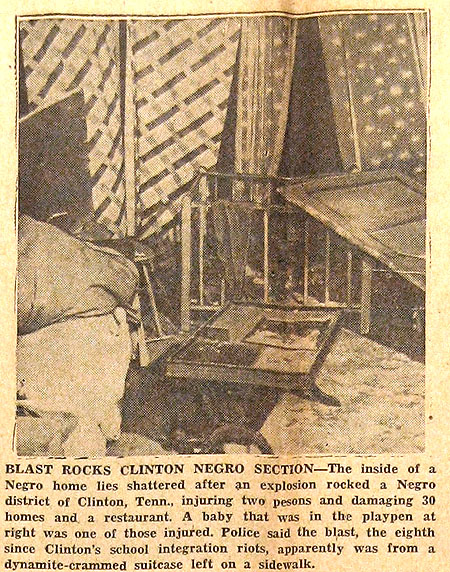
[picture caption]BLAST ROCKS CLINTON NEGRO SECTION—The inside of a Negro home lies shattered after an explosion rocked a Negro district of Clinton, Tenn., injuring two persons and damaging 30 homes and a restaurant. A baby that was in the playpen at right was one of those injured. Police said the blast, the eighth since Clinton's school integration riots, apparently was from a dynamite-crammed suitcase left on a sidewalk.
It is rash actions like the one above that cause Northerners to take a dim view toward the South's cause for segregation and causes communists to rejoice. Most Northerners and most educated Southerners are for eventual integration brought about over a long period of time by slow, moderate methods. However, when a person in the North reads of the violence that has been caused and ignored by the citizens of Clinton, Tenn., he finds it almost impossible to support a cause that uses and condones these methods of displaying agitation against the Supreme Court's decision on segregation.
If more Southerners took strong action against these self-appointed vigilantes and made a concentrated effort to bring them to justice, rather than shrugging their shoulders and turning their backs, nearly everyone would support the South's cause. It seems obvious that those who throw the bombs and start the riots are inflicting more damage to themselves and their cause than to the Negroes.
If the people of the United States could be assured that there were mature minds in the South capable of handling the situation, as there most certainly are, they would gladly join the South in a moderate camp.
Fight it, yes, but as rational, educated gentlemen that Southerners profess to be, and not warped-minded anarchists.
W. B. II
©1957 The Cavalier Daily
The Cavalier Daily 26 February 1957: 2
Letters To The Editor
Dear Sir:
I should like to offer a few comments on your picture of the Clinton bombing which appeared in a recent issue of the Cavalier Daily.
I know, of course, that many newspapers try to publish the lurid and shocking under the impression that this is what their readers want. And, unfortunately, this is true in many cases. It would be a real contribution to better race relations, however, if the Cavalier Daily—instead of perpetuating this policy—printed a number of instances of mutual friendship and goodwill between Negroes and Whites. The cases of overt violence in the South have been amazingly few when one considers the needling and provocation under which these people (Negro and White) have been living. Aren't you perhaps turning a molehill into a mountain?
The New Yorker who reads the daily papers may profess horror at the bombing of a Negro's home in Alabama or Tennessee. At the same time, he will accept as normal (or at least with complacency) the beatings and murders which regularly accompany the recurring strikes on the New York water front. A few years ago, the New York Tribune published each morning a box score of the murders, assaults, rapes, burglaries, etc., which had occurred in the city over the last 24 hours. The paper was forced to stop this practice because of the bad impression created in the hinterlands. The crimes weren't suppressed, of course, only the news. I do not suggest that news of bombings be suppressed, but I do urge that it be put into proper perspective. I fear that many New Yorkers project upon the South guilt feelings which they would like to forget.
I suspect that desegregation and not integration is the correct word in the context in which you use the term in article [sic] which accompanies the Clinton picture. This is no reflection upon your knowledge of the King's English, Heaven knows! The word "integration" is thrown at us almost every hour on the hour by radio, TV, press and pulpit. But I must confess that I do not always know what is meant. Are the American Chinese "integration"? [sic] To be sure, they meet the white American on equal footing, but they prefer to live in their own communities, to have their own clubs, to marry within their own race, and in general go their own way. This is true to a considerable degree of other minority groups—the Jews, the Italians and the Latin-Americans. Should all of these folks be forced to mingle socially willy-nilly? Or is integration only for Negroes and Southern Whites? Some of our more militant crusaders talk and write as though this last were true; at least they imply that whites should be forced with bayonets if necessary (a few would say preferably) to "integrate" with Negroes. All of this is palpable nonsense, of course. The law can desegregate, but it cannot integrate, if by the last term is meant full social acceptance in all walks of life. Social acceptance is not a "right" but is something to be sought after or not, as one prefers; it is not conferred gratis as any aspirant to membership in a college fraternity can testify.
Fortunately for all concerned the Negroes (if not the Whites) will have something to say about integration, too, and like the Chinese their social aspirations may not include the Whites. I believe the Negro will work out his own salvation, if not crowded too fast and too fervently. In fact, I sometimes think that the Negro can take care of his enemies if someone will take care of his overly ardent friends
Sincerely, Henry E. Garrett
Visiting Professor of Educational Psychology
©1957 The Cavalier Daily
The Cavalier Daily 7 March 1957: 1
Integration Leader Attacked By Whites
BIRMINGHAM, Ala., March 6.—(U.P.)—A mob of rock-throwing white men, yelling "kill the nigger lover," attacked a white integration leader today as he left the race-troubled Birmingham terminal station.
As violence flared again in the South's segregation wars, fiery John Kasper announced in Miami at the cross-burning trial of one of his aides that he will form a white supremacy youth group in Florida because parents "are not educating their children properly."
Kasper, wanted in Tennessee on a charge of interfering with court-ordered integration and free under $10,000 bond pending an appeal to a conviction of similar charges, said he will reveal is plans for a "Florida White Youth" group at a rally in Miami Friday night.
A relative calm here was shattered when an angry mob attacked integrationist Lamar Weaver as he left the terminal station where two negroes tested waiting room segregation laws.
Weaver was hit over the head with a suitcase and his Cadillac convertible was showered with stones and cement blocks as he tried to escape from a crowd of white men who met him at the door of terminal station.
Weaver had gone to the station for a talk with the Rev. F. L. Shuttleworth, a negro minister. Shuttleworth had taken a seat in the white waiting room at the station and was allowed to remain. However, police asked Weaver to leave because he was not a ticket-holder.
Some 150 white men were waiting outside the station and taunted Weaver with cries of "nigger lover." About 25 or 30 of the men followed the integration leader to his car, where the attack began.
One car pulled in front of his Cadillac, blocking Weaver's way out of the parking lot. The cursing white men grabbed chunks of concrete block from a nearby wall under construction and broke several windows in the car.
One man pulled open the car door and started hitting Weaver over the head before a reporter managed to shut the car door and keep the attacker away. Weaver backed into another car, put his car in low and ran headlong into traffic, barely missing several cars.
He drove to city hall to protest the attack, but was instead charged with reckless driving. Weaver told police both car door windows were broken as well as the windshield and the convertible top of his car was slashed.
Weaver told reporters after the attack he plans to "leave this city and state right away."
"I think it is best I leave to avoid any more trouble," he said. "I don't know where I am going but it will be out of Birmingham and Alabama."
Weaver, a clerk at U.S. Steel's big Tennessee Coal and Iron Division in this southern steel city, has requested permission for he and Shuttleworth to appear before the Senate Subcommittee on Constitutional Rights.
He was granted permission to submit a written report since the subcommittee closed its hearings yesterday. Weaver, a frequent speaker before Negro integration groups, claimed "repeated threats against my life" had forced him into hiding.
Kasper announced his long-range plan to teach the children of the South "the ideal of racial separation," after he came to Miami for the trial of four men, including one of his aides, Fred Hockett, 51, for attempting to burn a cross in front of the home of a negro entertainer living in a white residential section.
The four men were convicted of trespassing and disorderly conduct charges. Hockett, James McSwiney and Frank L. Foster, Jr., were given maximum sentences of 120 days in jail and $1,000 fines. They appealed their convictions and were freed on $1,200 bonds. The fourth Defendant, Hampton Earl Shaver, was given a suspended 60 day sentence and fined $200.
©1957 The Cavalier Daily
The Cavalier Daily 26 March 1957: 1
High Court Refuses To Change Virginia Desegregation Rulings
Integration Orders Upheld In Charlottesville, Arlington
Special to The Cavalier Daily
WASHINGTON—The United States Supreme Court yesterday rejected Virginia's attempts to delay desegregation of its public schools.
The Court, by its unwillingness to review appeals from lower court orders, directed the integration of Negro pupils in public schools in Charlottesville and Arlington, the two areas under consideration as "test cases" by the NAACP.
Neither Charlottesville School Supt. Fendall R. Ellis, nor John S. Battle, Sr., former governor of Virginia and attorney for the Charlottesville School Board, offered comment on future action or on the Supreme Court's decision.
Both said that they withheld statements on yesterday's refusal until they had studied the ruling.
Colgate W. Darden, Jr., President of the University, said that the Supreme Court's action, which makes final the U.S. District Court's integration instructions to the local boards, does not involve the University.
The court orders which the high tribunal has refused to review were the results of suits brought by the National Association for the Advancement of Colored People in U.S. District Court "on behalf of Negro children" in the two cities.
The two orders were appealed to the Supreme Court by Virginia Attorney General J. Lindsay Almond and the two involved school boards after the local Federal court rulings were upheld by the U.S. Circuit in Richmond.
Pending the outcome of Virginia's appeal to the Supreme Court, the effectiveness of the integration orders in both Charlottesville and Arlington had been "postponed."
As a result of the NAACP suits, Federal District Judge Albert V. Bryan, prior to the appeals, ordered integration of Arlington's elementary schools in January and of junior and senior high schools by the beginning of next September's school year.
In Charlottesville, Chief Judge John Paul ordered a "start toward integration," which except for the series of appeals was to be effective in all grades last September.
Schools in Charlottesville have remained completely segregated, including the two high schools, Lane and Berkeley, and numerous primary and elementary schools.
Under existing Virginia state law, the power and authority to assign pupils to a specific school has been taken from local authorities and given to the Pupil Placement Board, which is located in Richmond.
Local school authorities speculated that because of the Supreme Court's final refusal to review the Charlottesville-Arlington suits, no immediate difficulty would result.
They declined comment on what procedure will be followed in September.
©1957 The Cavalier Daily
The Cavalier Daily 26 March 1957: 2
The Order To Desegregate
The Supreme Court has just announced that it will not review the school desegregation suits against the school boards of Arlington and Charlottesville (See story on Page 1). The high court ruling has the effect of closing both of these cases and ordering the integration of public schools in the two areas concerned by September 1957.
There are now but two courses open to the two school boards and the central administrative authority over them which lies in Richmond—compliance with the May 1954 decision or defiance against it. The route of appeal is closed.
What has happened here is exactly what persons all over the State considered inevitable when the Virginia legislature adopted the Stanley Laws in special session last summer. The laws brought pupil placement control from the counties of the State to a central board in Richmond and set down a direct policy of "no integration anywhere in Virginia." By placing control of school policy in one central committee, the laws prevented independent action (integration of the schools) being taken by any of the localities under direct fire of the federal courts.
Probably the only measure still open which will legally prevent mass integration in the Virginia schools is adoption of laws similar to last year's Gray Plan whereby limited desegregation would be authorized in certain areas. We feel that this would be far superior to anything which possibly could duplicate the disgraceful situation which recently took place in Clinton, Tennessee when the schools were "forced" to integrate.
The Gray Plan was a package of laws designed by a special committee in Richmond, approved in a statewide referendum by Virginia voters and later scrapped by the General Assembly in favor of the "no integration" plan introduced by Governor Stanley last August. The courts have indicated that they will rule against this plan.
If Virginia schools are to be saved, there must be prompt action in Richmond. Closure of the schools to prevent integration would constitute what we consider the highest crime which could be committed against the youth of this state. This is not a time to allow emotions to gain the upper hand over sensible leadership in government.
Now that the legal process of court action has failed to remedy the school crisis over integrated schools, it seems that the leaders of this state would do well to look to the U.S. Congress if they still hope to avoid racially mixed schools in Virginia. There is simply no other way unless the State is to openly violate what must be interpreted as the law of the land.
©1957 The Cavalier Daily
The Cavalier Daily 16 April 1957: 2
Mistaken Invitation And A Damaged Reputation
Virginia lost a genuine opportunity to create goodwill in the race issue last week when the State Chamber of Commerce withdrew two invitations accidentally extended to Negroes for a "Distinguished Virginians Dinner" in Richmond on May 17. The invitations were issued in the names of Frank A. Ernst, Chamber president, and Thomas B. Stanley, Governor of Virginia, through what was termed by Ernst a "clerical error."
Newsmen were able to obtain nothing more than a "no comment" from the Governor's office when they tried to get an official explanation. The Chamber of Commerce stated that personal letters had gone to both Negroes asking that they return the invitations. One of these persons has answered that he will attend the dinner unless Governor Stanley personally rescinds the offer.
If this "Distinguished Virginians" banquet is to be what the name implies, we can see no good reason why it should not include Virginians of both races. Certainly, once colored persons had actually been invited – through error or not – it was a mistake to retract their invitations. A far more sensible course would have been public welcome of the Negroes as proof that we respect distinguished Virginians regardless of race even though we are not ready to bring their race into the white schools of our educational system.
The date of the dinner, May 17, serves as an ominous reminder to us of the damage done to our State in the current racial crisis. It was on this date in 1954 that the U.S. Supreme Court handed down the original decision outlawing race segregation in public schools.
©1957 The Cavalier Daily
The Cavalier Daily 8 May 1957: 1
SC Examines Spectator: Council To Investigate 'Segregation' Issue
Magazine Will Include Articles By Kasper, Boyle, And Faulkner
Four members of the Student Council have been assigned to look into the forthcoming publication of the Virginia Spectator entitled the "Segregation-Integration Issue." (See editorial, Page 2) Concern over its effect on the University has been expressed by members of the Council.
The controversial Spectator will include articles written by John Kasper and Floyd Fleming, well-known advocates of racial segregation, Sarah Patton Boyle and NAACP leader Edwin B. Henderson, pro-integrationists, and William Faulkner, University Writer-in-Residence and famous author. Mr. Faulkner will express the "moderate" views between opposing sides represented in the other three articles.
The Council action, first of its kind in recent times, was decided upon after long debate as to what position student government should take in such a circumstance.
It was feared that Council investigation might tend to over publicize the matter but also felt that it was the duty of this body to study the magazine, since its publication might possibly reflect discredit on the University.
President Leigh Middleditch expressed concern over the Spectator staff's announced plan to add a "humorous touch" to the seriousness of the subject saying that improper treatment of this could "hurt Negro students now at the University."
The liaison committee, composed of President Middleditch and councilmen William Hazelgrove, Peter Leisure and J.P.C. Hanbury, will investigate the magazine dummy and proofs and, if further action is considered necessary will call together a special session of the Council before next week's regular meeting.
©1957 The Cavalier Daily
The Cavalier Daily 8 May 1957: 2
Council Investigates Spectator
An important decision was made in Monday night's meeting of the Student Council. Four Councilmen have been assigned to investigate the forthcoming issue of the Virginia Spectator due on the stands Friday. The magazine will be devoted to a study of racial segregation. The Council decision to look into this matter is one which has taken courage and which reflects deep concern over the potentialities of such a magazine.
Five articles will be presented. John Kasper, arch-segregationist of Clinton, Tennessee, and Charlottesville notoriety, has written an argument in favor of separation entitled "Segregation or Death." This is the first piece written for publication by this person.
A second pro-segregation article, "Segregation Means Degeneration," has been submitted by Floyd Fleming, Vice-President of the Seaboard White Citizens Council on which Kasper is Executive Secretary.
Two authors have written pro-integration articles. Sarah Patton Boyle of Charlottesville has contributed "Why I Believe in Integration" and Virginia NAACP president Edwin B. Henderson has submitted "Integration in Virginia."
William Faulkner, noted author and University Writer-in-Residence, has written a "middle-of-the-road" stand which previously appeared in Life Magazine, "A Letter to the North." There is little doubt that this issue of the Spectator will receive wide attention and comment.
We say that the Council decision to investigate was courageous because another course of action (or inaction) was available to them. They could just as easily have ignored this matter and waited to see what reaction it would cause after the Spectator had gone on sale. In taking the more positive approach and looking into this magazine before it reaches the public, the Council not only risks charges of interfering with the free press (which they are in no way doing) but more important, they fore themselves into the position where they must publicly go on record either in favor of or opposed to publication of the issue. This is not an envious position but, as several Councilmen stated, one to which they are obligated by virtue of the office to which they were elected.
It is one thing to investigate and another to act. If the Student Council finds this magazine unacceptable to the University, what measures can they take against the Spectator Corporation? Two regulations seem to apply–one a Council bylaw and the other a University regulation. Section 5 of Bylaw IV states,
"All student organizations excepting the Honor Committee, the Judiciary Committee, and self-governing groups hold their power from the Student Council and are subject to the regulations of the Council."
University regulations as set forth in the University of Virginia Record specify, after referring to a list of approved publications, that:
"...students who wish to publish, distribute or sell any other publication must first obtain approval of the Student Council..."
(The reference to "other" publications would at first imply that the Council authority extended only to activities not included in the above-mentioned list of approved publications. But, authority over one such organization certainly implies authority over them all in a case such as this.)
We hope that there will be no need to use either of these rules against the Spectator. Presentation of this issue, if handled intelligently and maturely, can make the magazine a genuine contribution to the study of racial segregation and integration and a credit to the University. Anything short of this however, can make it a disaster. In this fact is found justification for the Council's choice to investigate. The handling of this matter calls for thought and good judgement on the parts of all persons concerned. We believe it will receive just this.
©1957 The Cavalier Daily
The Cavalier Daily 10 May 1957: 2
Opinion Poll Next Week
William Faulkner said yesterday, "I'd like to see more undergraduates of this University express their opinions on topics of wide interest." In this short statement, Mr. Faulkner probably struck the principal failing of this student body. It gets back to the old problem of apathy, or whatever else one might wish to label it.
Today's Spectator marks somewhat of a departure from this silence and it has been the policy of this newspaper to comment on any and all such issues as they arise. What is missing however, is response from readers and members of the student body.
We hope to correct this on at least one problem–school segregation in Virginia–through a University-wide poll in one of next week's publications. The student body will be asked its opinion on the methods in which the state government is currently handling the school problem as it faces us today. If the response from this poll is as complete as was the one from last year's straw ballot on the Presidential election, a valuable service will have been done in showing how the younger people of this state react to what we believe is Virginia's gravest problem.
©1957 The Cavalier Daily
The Cavalier Daily 14 May 1957: 1
Cavalier Daily Will Conduct Poll On Integration
An opinion poll will be conducted tomorrow throughout the University on the subject of state policy on racial integration in the public schools (See editorial page 2). Ballot boxes will be placed at key points in all schools for collection of student votes.
Ballots will appear on page 2 of tomorrow Cavalier Daily. They can be torn out and placed in the boxes between 8 a.m. and 1 p.m. Boxes will be collected at 1 p.m. and counted during the afternoon.
Two state plans will be placed on the ballot. They are the Gray and Stanley Plans, both designed but in different ways, to meet the school crisis caused by the 1954 Supreme Court decision barring racial segregation in the public schools. Objective descriptions of the two will appear in tomorrow's paper along with the official ballot.
It has been considered by State officials that student opinion on this issue is important because the school problem is "a lasting one and will effect the younger generation even more directly than the one now responsible for planning state policy in meeting the race situation." Results of the poll will be published in Thursday's Cavalier Daily.
The two plans up for consideration differ in that one permits limited integration under a pupil assignment plan whereas the other bars all integration and refuses to recognize the Supreme Court decision as law.
All students have been urged to take part in the voting so that a representative opinion will be obtained from the poll.
©1957 The Cavalier Daily
The Cavalier Daily 14 May 1957: 2
Tomorrow's Poll
This newspaper will conduct a poll tomorrow on the state's policy with respect to segregation in the public schools. Students will be asked to vote on the two plans which the state has considered in meeting the crisis caused by the desegregation decision of the U.S. Supreme Court. These two are the Gray Plan and the Stanley Plan. One, the Gray Plan, was proposed a year and a half ago and later approved in statewide referendum and the other, the Stanley Plan, was officially enacted into law during the special session of the General Assembly last summer.
There is considerable conflict between these two plans even though they seek approximately the same goal—prevention of racial integration in the public schools.
The Gray Plan meets the problem by establishing a pupil assignment policy which permits occasional limited desegregation, thereby complying with the Supreme Court decision, but which prevents occurrence of integration wherever possible. The overall result is that desegregation, where it occurs at all, occurs gradually.
The Stanley Plan is opposed to any integration anywhere. It cuts off funds from all schools which desegregate under court order. After closing such schools, it will reopen them at the request of local authorities as a part of a new segregated state system.
Our opinion of these two plans is important and should be noted with deep interest by the leaders of this state. Whereas differences between the Gray and Stanley Plan may at first seem to be nothing more than ones of procedure, closer study will reveal that one plan sets the state in compliance with the Supreme Court ruling, recognizing that decision as the law of the land, while the other defies the decision and places state authority between the Court and the people.
There is also a basic difference of philosophy between the plans. The Gray Plan is so designed that it accepts the principle of racial integration whereas the Stanley Plan does not. This, of course, does not mean that persons voting for the Gray Plan are integrationists for the Gray policy is as opposed to desegregation as any other. It is merely a system whereby the state would permit a certain amount of integration in order to prevent court orders demanding massive desegregation. The Stanley Plan directly opposes the Court decision and allows no integration in any state school.
It is on these points that we should make our decision in tomorrow's poll. The result will very likely be heard all over the state and possibly over the entire country. This is not a matter upon which we can remain silent because its effects may determine the future of all public education in Virginia.
©1957 The Cavalier Daily
The Cavalier Daily 15 May 1957: 1
Cavalier Daily Conducts Poll On Segregation
Ballot Boxes Distributed At Points Throughout University For Voting
Ballot boxes have been distributed at key points throughout the University today for collection of votes in the Cavalier Daily opinion poll being conducted on the subject of school segregation. Students are asked to choose between the Gray and Stanley school plans described fully on Page 2 of this newspaper. Votes will be accepted until one this afternoon.
Boxes are located in the following places: Cabell Hall, Fayerweather Hall, Rouss Hall, Peabody Hall, Thornton Hall, Monroe Hall, Clark Hall, and the Medical School. These boxes are white and identified as property of the "Cavalier Daily Opinion Poll." They are located at Cavalier Daily distribution points.
The two plans being voted on constitute a choice between compliance with the Supreme Court through occasional limited desegregation of certain classrooms and defiance of integration anywhere by closing schools which desegregate.
The first plan was proposed in Virginia a year and a half ago, approved in a statewide referendum on January 9, 1956, and finally placed aside in favor of the second plan which cuts off funds to any school which integrates.
The poll is not strictly one of choosing between integration and segregation. Both choices favor segregation in the schools. One, however, allows desegregation in small limited amounts to prevent court orders to integrate everywhere. The other believes that the state can prevent any integration anywhere by setting down a policy whereby no mixing is allowed in any state operated school at the high or elementary levels.
Hope has been expressed that a large vote will be turned in so that a representative opinion will be obtained from the student body. Observers expect interest in the results to be high since this is the first attempt known at obtaining the ideas of students on this subject.
Ballots are in two sections. The first is an election between the two plans and the second, an indication of the home state of the voter. The usual rules about one ballot per person apply.
©1957 The Cavalier Daily
The Cavalier Daily 15 May 1957: 2
Important Choice
Since May 17, 1954, when the U.S. Supreme Court decided that the practice of school segregation by race was illegal, many plans have been proposed as solutions to the problem which has arisen. Among these many, two have received wide attention in Virginia–the Gray Plan and the Stanley Plan.
The first was approved in a statewide referendum of January 9, 1956 and the second became state law when enacted by the Virginia General Assembly last summer.
Gray Plan
The Gray Plan was submitted to Governor Stanley in the fall of 1955 by the Commission on Public Education, headed by State Senator Garland Gray. It was designed to place barriers in the path of school integration but, at the same time, to allow some degree of desegregation in areas where it was felt that such a plan would be acceptable to parents of school children.
In cases where children would have been forced into integrated schools against their wills, however, a financial grant would have been provided to be used toward the private school education of these students.
The plan was originally accepted by the Governor Stanley who then submitted it to the people for approval in the statewide referendum. It then received a 2 to 1 endorsement by the voters of Virginia.
Between the time of its popular approval and its official enactment into law by the General Assembly, apparent resentment grew over the section of this plan which allowed limited desegregation in certain areas and which accepted the principle of racial integration. Out of this resentment came a second plan different from the first in that it allowed no integration in any school and set the state directly in defiance of the court order to desegregate. This was the Stanley Plan, introduced by Governor Thomas B. Stanley.
Stanley Plan
The Stanley Plan withdrew pupil assignment authority from the local school boards and vested it in a central Placement Board, appointed by the Governor. It further provided that no state funds would go to any white school which enrolled a Negro pupil. In this way, no such school could operate as a part of the Virginia system when its classes were desegregated.
Some have argued that the Stanley Plan is unconstitutional and will lead the state to massive integration and a wrecked school system after the plan has failed in the courts. These persons contend that a policy of limited desegregation, even if this means only a handful of cases in the next decade, will be regarded by the Federal courts as sufficient progress in the right direction and that court pressure to integrate will therefore be lifted.
Advocates of the Stanley Plan on the other hand, believe that even token acceptance of integration will lead to its mass application in the schools of Virginia. They feel that any integration anywhere will destroy the public school system of our state.
To Prevent Integration
Both plans have a common goal–prevention of racial integration in the public schools. Where they differ is in this point. The Gray Plan says that the Supreme Court decision must be complied with if we are to avoid violent and forced integration in the schools. The Stanley Plan, however, favors open defiance of integration everywhere. It does not recognize the Supreme Court decision as law, and its proponents believe that "massive resistance" will nullify its effects on Virginia's schools.
The decision we, as students of this University, must make in today's poll is of vital importance. Whatever course is elected by our state leaders today will have to be applied by us tomorrow. If our state legislators are wise, they will regard what we decide here with seriousness. The problem is in their hands now but its effects will fall on our generation later. Because of this, we have a right to be instrumental in its solution.
©1957 The Cavalier Daily
The Cavalier Daily 16 May 1957: 1
Sparse Voting Endorses Gray Plan
Students Favor Bill By Two-To-One Edge
'Limited Desegregation' Gets Nod; Poll Parallels Statewide Opinion
University students participating in yesterday's Cavalier Daily Opinion Poll endorsed the Gray Plan over the Stanley Plan by over a 2 to 1 margin. A total vote of only 488 was cast in the elections, which was considered "disappointing" by sponsors of the school segregation poll.
The two plans voted upon were measures considered in Virginia to meet the current school problems. The Stanley Plan, now law in the state, proposes total resistance against racial integration in the schools, whereas the heavily favored Gray Plan accepted a pupil assignment policy which would permit limited desegregation in certain areas.
The Gray Plan had been approved in a statewide referendum during January of 1956 an later disregarded in favor of the Stanley Plan when the legislature expressed the opinion that limited integration would be intolerable in Virginia schools.
Virginians favored the Gray Plan by approximately the same majority it received in the total student vote. Northerners voted Gray 3 to 1 and out-of-state Southerners were 3 to 2 in favor of the Gray Plan.
Totals were 312 Gray to 143 Stanley with 33 voting "neither" for the whole University. In-state students chose the Gray Plan 195 to 96 for Stanley. Out-of-state Southerners were [illegible] Gray and 25 Stanley. Northerners favored Gray 71 to 23.
Several ballots state that neither plan was constitutional, one said "we must have complete integration," and two called both plans incapable of stopping desegregation.
The vote from Virginians was nearly double that of out-of-state students, this margin being 291 to 156.
In total votes cast, the College led with 223, with Engineering casting 61, Law 52, Commerce 34, Education 25, Medical 15 and Graduate Business 11. 67 votes were cast in the Commons box.
The school most heavily favoring the Gray Plan was the Law where 35 voted with the Gray Plan, 6 for Stanley and 11 for "neither."
Alone among the other schools, the School of Medicine favored the defeated Stanley Plan 8 to 7.
This poll is the first one of its kind known to have been taken at a college or university on the subject of school segregation.
©1957 The Cavalier Daily
The Cavalier Daily 16 May 1957: 2
Opinion Poll
The University's vote in favor of the Gray school plan would be more impressive if the number of students participating had been higher. Less than five hundred cast ballots which is only slightly more than ten percent of the student body. Nevertheless, we feel that the importance of this decision should not be disregarded by the legislators of Virginia.
Over twice as many Virginia students favored the pupil assignment Gray Plan as voted for the total resistance Stanley Plan. Out-of-state students were of like sentiment.
We believe that this result tends to show that there is a marked difference between young Virginians and older Virginians in the way this school problem should be met. The "young attitude" might be termed as more liberal towards the Supreme Court anti-segregation ruling.
Probably no large number of Virginians, young or old, wants integration in the schools but it is fairly apparent that many would accept a small quantity of desegregation rather than permit the chaos promised by a policy of total defiance against the "law of the land."
©1957 The Cavalier Daily
The Cavalier Daily 17 May 1957: 2
Letter to the Editor
Dear Sirs,
In regards to your last poll, I believe that the lack of voting was not due to the dis-interest of the student body but rather to the haphazard way in which you organized your polling system. Due to your insufficient number, poor locations, and unmanned stations, the poll became a failure.
Sincerely, Fim Feeley
Editor's note—Ten ballot boxes were distributed throughout the University covering every school with the exception of the School of Architecture which, through an unfortunate error, was missed in the box placement. It would be difficult to administer a more comprehensive poll than this and we must conclude that it was more a lack of interest in the question asked than any other factor which contributed to the poor response.
©1957 The Cavalier Daily
The Cavalier Daily 17 May 1957: 1, 4
Law School Team Banned From Field
A University softball team was expelled from Richmond's Byrd Park Field last week because one of its players was a Negro. City officials ordered the Law School's Barristers to move to another city-owned field for their game with a William and Mary all-star team last Friday. The Barristers lost in extra innings, 2 to 1.
The game was a part of the Virginia Amateur Softball Tournament in which the Barrister team represented the University.
Aland D. Groseclose, manager of the Barristers, was instructed by Jesse A. Reynolds, Director of Recreation and Parks for Richmond, to move the team to Parker Field for their scheduled contest.
Mr. Reynolds explained that the reason for the order was "a policy matter" and not a city ordinance. He said that inhabitants in the area surrounding Byrd Park Field were "vehemently opposed" to use of the athletic facilities by Negroes and that such use might result in a public demonstration against the team, according to a statement issued to the Law Weekly of the University's School of Law.
Parker Field is the home of the Richmond Virginians, an upper division team of the International League. Negro participation in games played at this field is permitted by common practice.
©1957 The Cavalier Daily
The Cavalier Daily 22 May 1957: 1
Integration Report In Social Functions At University Given By Student Council
Reprinted below is the text of a Student Council report on racial integration in social functions at the University (See editorial on Page 2). The document, drawn up last year, has just been released for publication.
The Joint Committee appointed by Student Council President William Forrest to consider the problems which might arise as a result of the social mixing of the races at the University met at the Rotunda at 6:45 p.m., April 12, 1956. This committee consisted of Jim Black and Sandy Hoff from the Dance Societies, John Orgain and Jack Ray from the Interfraternity Council, Tom Gill and Doug Godine from the Student Union, and Jack Ackerly from the Student Council.
This committee feels that because of the complexities of this problem and the absence of any specific instances of open friction, no specific rules of social conduct are warranted at the present time. The committee likewise feels that in the event of friction between persons of different races, emphasis should be placed on the exercise of wise discretion by the individuals to alleviate the problem as tactfully as possible. The committee would like, however, to offer the following suggestions as a guide to the solution of any problem that might arise.
No. 1 Fraternities: This committee feels that since a fraternity is a private organization, which in a broad sense may be compared to an individual's home, any visitors who prove objectionable may be asked to leave regardless of color. It would be preferable if an officer of the fraternity would make this request.
If one is not present at the time, then the right should be extend to any member. If possible each fraternity should have a predetermined policy on colored visitors.
This committee does not feel that "closed" parties are necessary. It is felt that the suggestions in the first paragraph are adequate to alleviate any instances that might arise in the near future.
Each fraternity has a clause or clauses in its charter regarding fraternity membership. Thus this question should likewise be left up to the individual fraternities.
No. 2. Dances, concerts and similar functions sponsored by the P-K and German dance societies. It is the policy of the dance societies to admit colored students to their functions as long as they conduct themselves in the manner expected of all University students. However, this policy does not necessarily extend to persons who are not students. The committee feels that the right of the dance societies to exclude these and others they so desire may be justified by the fact that the societies are private organizations which must pay rent for the use of gymnasium. It might be wise for the societies to include a statement on all tickets to the effect that they were subject to revocation at the door.
No 3. Student Union Activities: Negro students have been admitted to Student Union functions and so far have conducted themselves in an exemplary manner.
One characteristic of these functions, particularly the dances, which might possibly cause friction is the fact that students usually come without dates, girls being brought to the University by buses from neighboring schools. If a Negro student should ask a white girl to dance, it is believed the decision should be left entirely up to the discretion of the particular girl. Student Union officers, however, should be cautioned to watch for resentment that might arise on the part of others and be ready to handle it as tactfully as possible. The surprise and confusion of a girl induced by such a request might be avoided by warning them before they come to the University.
©1957 The Cavalier Daily
The Cavalier Daily 22 May 1957: 2
Desegregation at the University
Last year's Student Council drafted a statement setting forth their position regarding social integration of the white and Negro races in University-connected activities (See text of statement on Page 1). The document has just been released for publication.
From beginning to end, this Council paper exhibits calm judgement which makes it a refreshing change from much of what we hear relative to the problem of racial integration in the South today. Rather than try to write rules and regulations covering the situation, the Council calls for nothing more than wise discretion on the parts of all students.
We feel that the success or failure of race relations at the University now rests largely in the hands of Negro students enrolled. Desegregation has gone over smoothly here because it has not been rushed by the colored race and because it has not caused social mixing between white and Negro. Even when the two have attended dances together in Memorial Gymnasium, there has been not the slightest hint of trouble or violence.
Any attempt at exploiting this situation by either race will destroy this atmosphere of calm and good will and result in conflict which will bring both chaos and disgrace to the University. We hope that the same mature judgement and good sense will prevail in the future which we have witnessed in the past and that other colleges and universities will take note of the progress which this attitude has caused here. Both races can be justly proud of racial relations between students of this University.
©1957 The Cavalier Daily
The Cavalier Daily 17 September 1957: 2
Segregation: More Understanding Needed
(Editor's Note: Following is an editorial which was written by Tom Martin, but which was never printed in his lifetime. We feel that his subject, the racial problem, is one of the most timely today, particularly in view of the current trouble in Little Rock, Arkansas, and virtually all over the South with the opening of the public schools.)
This newspaper has recently received a "College Editor's Poll" from the Communication Arts Group of New York University. It asks the editor's opinion on his school's attitude toward a number of questions relating to college, national and international affairs and was sent to each of the 150 largest college and university publications in the country.
Among the questions was one which came as a shock because of the way in which it was worded. "Do you think integration is being carried out fast enough?" It was asked in the same way that one would inquire as to whether or not the library was being painted fast enough. It seemed to completely disregard the problem which integration has created and leads us to wonder whether that problem is even realized much less understood in parts of the country not effected by the desegregation ruling of the Supreme Court.
If it is not, and it seems from this and other evidence that it unquestionably is anything but understood, then it is up to Southerners, especially Southern leaders, to see that the outsiders are informed. It is true that a crisis such as this cannot be fully appreciated unless it is lived with. But it is just as true that those who have firsthand contact with the problem can "educate" those who have not and create an appreciation of what the South faces in the task set down by the Supreme Court decision of May 1954.
Racial desegregation is in a very true sense a national problem. Its immediate effects are concentrated on the South but, at the same time, the whole nation's reputation is connected with it. The Supreme Court's desegregation order was seen by these non-Southern persons as a long stride forward in social improvement and a most effective slap-in-the-face to Russian propaganda which, up to that time, had made great capital of racial inequality in the U.S. They were outraged that the order was not promptly implemented in the South, not because they had no sympathy for Southerners, but simply because they did not realize what a social upheaval such a change could cause.
In much of the country, this attitude still prevails. It is dangerous that we should allow it to do so. With a lack of understanding, there can be no true solution. And with the crisis seeming to heighten with each passing day, it would be wise for us to take the initiative in pressing for understanding and moderation in all parts of the country so that the South won't be pressured into a stand of total defiance against the Court in which there is no hope for future agreement.
©1957 The Cavalier Daily
The Cavalier Daily 24 September 1957: 2
The Old States' Rights Question
Last week the citizens of the United States, many of them unknowingly, celebrated Constitution Week, an observance designed to commemorate the magnificent achievements which that document represents. Ironically enough, this year's Constitution Week came at a time when a decision of the United State Supreme Court, based on sections of the Constitution, was being sharply debated both verbally and actively. We make reference to the Court's decision of May, 1954, when it declared separation of the races in the schools to be illegal and unconstitutional.
The Constitutional basis for that well-known decision was the Fourteenth Amendment, which provides that all persons born or naturalized in the United States are citizens, and the Fifteenth Amendment, which guarantees to all citizens equal protection under the law.
But the 1954 action of the Court was not the first time, by any means, that the legality of racial segregation had been brought under the scrutiny of the nation's highest appellate body. And in all previous instances the jurists had held that the question was a state matter, reserved for action by the states in the Tenth, or so-called States' Rights Amendment, which reads:
The powers not delegated to the United States by the Constitution, nor prohibited by it to the states, are reserved to the states respectively, or to the people.
The proponents of segregation have loudly maintained that it was the intention of the drafters of the Constitution to reserve for action by the states alone matters which are of a sectional nature, that is, matters which do not affect the whole country in the same way. It does appear, indeed, that there exists in the racial question a need to take into account the fact that the problem is not a uniform one throughout the country. It seems that there is a basic fallacy in reasoning that leads to the adoption of the same set of laws governing the question to apply equally in Alabama and in South Dakota.
Nowhere in the South has the protest to racial mixing in the schools been more apparent than in Little Rock, Arkansas, under the leadership of the governor of that state, Orval E. Faubus.
Gov. Faubus began his grandstand play when he called out his state's National Guard units, apparently to prevent Negro children from entering Little Rock's Central High School on the opening day of school, September 2. He also placed a detachment of Guardsmen around the governor's mansion in Little Rock, for largely unexplained reasons. Thus fortified, he has withstood all comers, including President Eisenhower and Little Rock Federal Circuit Court judge, Ronald N. Davies, while he took time to contemplate the situation and to weep for his people. His meeting with the President was characterized largely by vacillation on the part of the Chief Executive; and to his first court subpoena from Judge Davies, Gov. Faubus was aloof.
When he was presented with the subpoena, the governor wrote to the clerk of the Circuit Court:
"While I have the utmost respect for your court and its valid processes, I must point out that almost from the very beginning of our republic it has been uniformly held that the chief executive (of a state) is not compelled to comply with a subpoena unless he chooses to do so. In this particular case because of the obvious ulterior motive of those who obtained the subpoena, I do not choose to comply..."
Now the National Guard troops have been removed under court injunction, and Gov. Faubus has decided to have his day in court after all. As to what has precipitated this strange turn of events, we can only surmise. It seems most probable that the Arkansan has decided not to try to push his luck any farther at the present, but in any case, we may be sure that when Mr. Faubus goes to court to test the laws on the race question, we will see the old fight of state versus federal power cropping up once more.
©1957 The Cavalier Daily
The Cavalier Daily 26 September 1957: 2
The Little Rock Fiasco
What Mr. Eisenhower has done in calling out federal troops to put down Arkansas' budding insurrection, he had to do. It is a shame that he did not act as decisively a few weeks ago when he conducted himself in what he earlier called a "vacillating" manner in dealing with Mr. Faubus. Perhaps the Little Rock situation would not have gone so far as it did if the President had been [a] bit more stern in his initial encounter with the Arkansas chief executive. But the milk is spilled now, and we say again, with things as they were, Mr. Eisenhower acted rightly and in the best interests of his people.
We wish to criticize Mr. Faubus rather than the President, for it is he who is responsible for this disgraceful incident which couldn't have been more ill-timed. Coming, as it did, when America's good name abroad is the greatest single element in maintaining world peace, the mistake which Mr. Faubus made may have the gravest consequences to the free world. Since the termination of World War II, the United States has stood for all that is desirable and good in the world; the nature of our republic has been the most important anti-Red propaganda instrument imaginable. But now, torn by internal strife, tolerating the abuse of our own people, we do not make such a pretty picture.
But there are those who will say that Mr. Faubus is not to blame for what has happened, and certainly we will agree that he is not entirely so. But what happened need not have, and the Governor could have prevented it.
It is interesting to speculate on the motives which led Mr. Faubus to take the action that he did. The speculations form a continuum from base to noble with considerable in-between; if the former end of this continuum seems most plausible, then his was the act of a despotic tyrant; if the latter end is selected, then he must be termed at best a sadly misguided individual.
Whether he acted in good faith is a matter known only to himself and to God. But whatever his motives, it is clear that what he did was wrong. Being a less great man than he should have been, Mr. Faubus forgot that as a leader goes, so go his followers; this must be so, or the leader becomes no longer a leader. And by opposing integration with warlike means, he made it clear to his people that he deemed such means the most effective weapon. It was only natural that they should turn to force, ready to fight. And they did.
We hope now that the pressure of federal troops in Little Rock will alone be sufficient to discourage further violence. If it is not, then Mr. Faubus may find that, rather than ensuring the absence of bloodshed, he has made his people subject to a veritable blood bath.
©1957 The Cavalier Daily
The Cavalier Daily 3 December 1957: 1, 4
Student Legal Forum Sponsors Discussion of Civil Rights Tonight
Javits to Speak
Senator Jacob Javits and three prominent newspapermen will appear in a panel discussion tonight in Cabell Hall Auditorium at 8:30. The discussion is being sponsored by the University's Student Legal Forum.
The newsmen that have accepted the invitations are James J. Kilpatrick, editor of the "Richmond News Leader"; Chester R. Babcock, editor of the Charlottesville "Daily Progress"; and Robert Baker, writer for the "Washington Post."
The discussion will start with Senator Javits delivering a talk that will forecast the success of the civil rights legislation to be proposed in the next session of Congress. The speech will include a prediction of the nature of the new legislation.
Following the talk, the newsmen will question the Senator.
Senator Javits was elected to the Senate in 1956, defeating Robert F. Wagner, the present mayor of New York City. Before his election to the Senate he was elected as the Attorney General for New York in 1954, defeating Franklin D. Roosevelt, Jr.
Javits describes his position on civil rights as that of the "most outspoken opponent of segregation in the Senate."
He was the sponsor of the omnibus civil rights bill, the first legislation that included provisions against segregation in education, housing and the armed forces.
Robert Baker, the writer for the "Washington Post," is one of the best versed newsmen concerning the question of civil rights. He covered the Little Rock situation for the Washington Post.
James Kilpatrick, editor of the "Richmond News Leader," was the chief exponent of the "Integration Doctrine" advanced during the last session of the Virginia General Assembly.
This plan of Kilpatrick's has found wide popularity throughout the South and much of the nation. The doctrine utilizes the theory that [a] state can interpose its sovereignty against a decision of the Supreme Court which it considers contrary to the Constitution.
Kilpatrick has made quite a name in the South, not only for the doctrine, but also because of his rapid rise in the news world.
©1957 The Cavalier Daily
The Cavalier Daily 12 October 1957: 2
The Female Equivalent
It has come to our attention that [a] number of our women students are going about the Grounds in clothing suitable for little outside of the Gymnasium. We make reference to informal attire such as Bermuda shorts and the like, which are very attractive when worn at the proper time and place; but it seems to us that the Grounds during class time is neither.
We do not intend to imply that our co-eds are actually going to classes in shorts, but rather that such garb is being worn after such activities as tennis as the girls make their way back to their dormitories. All of the women's colleges in Virginia require a young lady to wear a raincoat at the very least when she is wearing shorts. And here at the University where all the men attire themselves as befits a gentleman, even that little bit is not being done.
It does not seem unreasonable to expect the women who attend our University to dress in a manner comparable to the men. This would mean that they would wear stockings and heels to classes, which (we are naturally and excusably a bit shaky on our facts at this point) seem to be the female equivalent to coats and ties. No one attempts to force the men to dress as they do; it is as a matter of courtesy that we try to follow gentlemanly rules governing dress and deportment. It has not been necessary to establish rules to force the men of the University to dress as they do, and surely no one will try to propose any rules for the ladies. We can only hope that they will be cognizant of the fact that this is just as much their University as it is ours, and that all things that they do, and this includes dress, are a reflection upon it. Whether credit or discredit is reflected depends upon how they choose to regard this responsibility.
©1957 The Cavalier Daily
The Cavalier Daily 7 November 1957: 1, 4
Segregation Statement Issued by Copeley Hill
A resolution stating that the residents of Copeley Hill would find living near a Negro "distasteful" but that the majority of Copeley Hill families would accept an assignment without violence was passed to the administration last week by the Copeley Hill Council.
The resolution was the result of a special meeting by the council held on Oct. 29 and was requested by the administration. It passed the council by a 5-2 vote with Mrs. Barbara Smith and William Horne voting against the resolution.
Last summer a negro graduate student in Engineering was assigned a trailer on Copeley Hill without prior knowledge that the applicant was a negro. The applications for housing on the Emergency Project does not require that an applicant state his race.
During the summer a member of the local Seaboard White Citizens Council threatened the engineering student and told him, "You ought to leave, we don't want you up here." The residents of the hill made no overt protest to his living on the hill. Police protection was assigned to the negro student.
The Administration, through housing director Donald McKay, had requested a statement of policy from the Council to present to the Board of Visitors.
In passing the resolution, the Council passed over two recommendations of a special committee set up to formulate suggestions of policy.
Mrs. Smith read her suggestion which said that assignment should be based completely on previously determined priorities and not on the basis of race. This was a minority report of the committee.
Albert Epperson, a thir-year student in commerce from Portsmouth, Va., read the majority report which said the basic policy should be that no negro be assigned to Copeley Hill. If a negro family should qualify for housing on the hill, the University should establish a separate and equal housing project.
During the meeting the following points were discussed by the Council: (1) a majority of the residents of Copeley Hill were born and raised in the south, had never lived with negroes, and would be distinctly against it; (2) most of the families would find it distasteful to use furniture and fixtures previously used by negroes; (3) that the negro maids employed on the hill by working wives probably came from more unsanitary conditions than the houses maintained by negroes on Copeley Hill; (4) since the University had no set policy on the assignment of negroes in the dorms, to staff positions, and seating of students in the classrooms, how could there be a policy established for Copeley Hill; (5) and since the progress toward the construction of better housing was slow, it was likely that the University would be unable to establish an entirely separate but equal housing area for negroes.
Donald Thompson, mayor of the hill from Salem, Va., had no comment on the resolution this morning but indicated his approval during the special meeting.
Mrs. Smith questioned that the Council were acting as legislators for the good of their constituents or as representatives of the residents that the general feeling was of a clear understanding of the true feelings of the people of the hill.
©1957 The Cavalier Daily
The Cavalier Daily 12 February 1958: 2
Women, Wahoos, And Words
Women around the University have always presented a problem; they are distracting and there are definitely too many of them. But the problem is growing consistently worse. The boom in adult education had lead the Admissions Office to disregard age in the case of admitting some women into the University, and thus we have seen women who could pass for grandmothers wandering around the Grounds in outfits which would turn them into young coeds.
And some of them persist in wearing the outlandish headresses which have plagued society for centuries, complete with feathers and everything. It is certainly disconcerting to the student who is attempting to take notes on a lecture to have a long and brilliant plume continually annoying his nose and face. We urge discrimination in the selection of our unwanted coeds. Since they are a necessary evil, they at least can be made as inconspicuous as possible.
©1958 The Cavalier Daily
The Cavalier Daily 1 May 1958: 1
Darden Says Christianity Only Force That Can Combat Communist Threat
Addresses Presbyterians
Speaking to the Westminster Fellowship Sunday evening President Colgate W. Darden professed the belief that the turn against Communism will come with ideas and not armaments, no matter how powerful the weapons which scientists invent.
He said Christianity is the only force which, if adhered to, can defeat Communism. Citing the fact that Christ's influence has been greater than that of the Caesars of the Roman Empire and the great conquerers of other empires, he called attention to the impact of Christianity on the world and submitted that our continuation as a democratic nation depends on our adherence to the Christian faith.
"The human spirit," he said, "is the only thing that is really instructive, and therefore possesses the greatest potential strength."
During the questioning period, Mr. Darden's "off the cuff" remarks kept his audience in constant laughter. However, in a more serious vein he expressed his opinion on several current issues at the University.
On the segregation question as related to the University Mr. Darden stated the University's present position of admitting all Negroes when equal and separate facilities are not available in the state rested upon the federal court decision in Swanson vs. University of Virginia in 1948. Swanson, a graduate Negro law student, was allowed to attend the University. Subsequently he dropped out of school.
Negroes are not admitted to the College of Arts and Sciences or the women's division of the University, Mary Washington College, because equal facilities are available in Negro colleges in the state.
Mr. Darden stated that there has actually been very few requests among Negroes to enter the University and said most of the Negroes admitted have been about average students. In some instances, he said this is quite a significant accomplishment since some Negroes have had very poor preparation.
Asked about the future of the University with the prospect of swelling enrollment, Mr. Darden replied that two courses are open. First, the legislature can create a number of small strategically located liberal arts colleges, similar to Clinch Valley, which he favors. The other alternative is to let the University grow with the population. This would probably enlarge the enrollment of the University to 12,000 in the next ten years. Such a rapid expansion, Mr. Darden feels, would be unhealthy.
©1958 The Cavalier Daily
The Cavalier Daily 14 May 1958: 2
Charlottesville Showdown
The test has at last come to Charlottesville. Federal District Judge John Paul has ruled that Charlottesville public schools must desegregate in September. The big question now is what will be the outcome of the ruling. Will Charlottesville turn into another Little Rock, or will white students peaceably attend schools with Negroes? Will the General Assembly take further steps to resist the court rulings, or will Virginians come to realize that they cannot resist the powers of the court.
We have enough knowledge of the attitudes of the people in Charlottesville to know that resistance can be expected, and that there won't be any peaceful integration of public schools in the fall. We do not think that violence in any way similar to the Arkansas crisis will arise, but we feel sure that legal steps will be taken to prevent integration.
We have heard two attitudes on the issue at the University. Mr. E.J. Oglesby of the Engineering School faculty heads the local chapter of a somewhat extreme organization bearing the pretentious name of "Defenders of States Rights and Individual Liberties." This group's main objective is to prevent integration of schools in Virginia, judging from what Mr. Oglesby has had to say on the subject, they mean to take strong steps to do such, mainly through the General Assembly, which the group seems to feel is just an organ for their objectives. We certainly cannot endorse their attitudes, for such outright disregard for the court ruling would eventually lead to violence.
The other attitude we have heard has been expressed by Mr. J. Lindsay Cohen of the Law School. Speaking before a luncheon of the Virginia Circle of Omicron Delta Kappa, Mr. Cohen reviewed the many legal steps which could be taken to prevent integration of the Charlottesville public schools. Mr. Cohen pointed to the delays which would arise in obtaining court orders for specific cases involving integration, the lengthy amounts of time which would be necessary to schedule cases, the difficulties arising from the dual roles of pupil placement by the local school board and the Pupil Placement Board in Richmond. He also pointed to the legal trouble which would arise in case the Governor of Virginia were indicted for closing public schools, and also the difficulty of proving the students had been turned down in a white school because of only race or color.
It was Mr. Cohen's attitude that the legal difficulties which would arise in the case where Charlottesville public schools were ordered to integrate, which they have been, would prevent any integration for many years.
Certainly if the people of Charlottesville do not wish to comply with the recent court order, following Mr. Cohen's views of finding legal delays is the most sensible attitude to assume and support, rather than to exhibit outright defiance. We certainly hope that clear heads will prevail in the forthcoming showdown, and that Charlottesville will not become a spark to ignite the flame of resistance and disorder in Virginia.
©1958 The Cavalier Daily


